
 CORE is on the
CORE is on the
Ground Ready to Help
Invictus Games Returns to Canada
Sustainability in Travel and Tourism
Rethinking the Meaning of Good Food
Standing in Solidarity with Iranian Women
November • 2022globalheroes.com
RAYE MOCIOIU
At just 22 years old, Alphonso Davies has already made sports history—and he’s set to do it again. Known for his incredible technique on the field, Davies, who was widely lauded as one of the finest teenage talents in the world, made his mark on the soccer pitch as the youngest senior international debutant and goalscorer for the senior men’s national team. In 2021, the athlete was appointed the newest Global Goodwill Ambassador for the United Nations High Commissioner for Refugees (UNHCR)—the first soccer player and Canadian to do so.

Born in a refugee camp in Ghana to Liberian parents who fled the civil war in their home country, Davies knows first-hand what it means to be a refugee. When Davies was five years old, he and his family were resettled in Canada.
He also knows that as an athlete, he has the power to inspire a new generation of Canadian soccer fans.
After becoming the youngest to play, at the age of 16 he became the youngest player ever to score for the Canadian national team. In January 2019, he moved to FC Bayern Munich, helping the German giants win the German championship later that year.
“Over the last year or so, I’ve had a lot of support and interest from my fans in the work I do for refugees and UNHCR,” Davies shared. “I think when people learn about my personal story, it can really change their minds about how they see refugees. Anyone can become a refugee, at any point and anywhere.
“Becoming a Goodwill Ambassador for UNHCR was

one of the proudest moments of my life, it made my parents happy as well. That I am the first soccer player and the first Canadian to be a Goodwill Ambassador for UNHCR made it even more special.”
BUILDING A PLATFORM
Davies has repeatedly shared how important it is to use his platform in a positive way, advocating for refugees and the transformative power of sports—and showing how the two can intersect.
“It goes without saying that the main reason I do what I do, is because I was once a refugee,” Davies said. “I knew the moment I became a professional soccer player that I wanted to help others who’ve been forced to flee. I want to use my platform to give them hope and drive, and maybe be a role model for others who went through a similar experience.”
When the pandemic started in 2020, Davies teamed up with soccer player Asmir Begovic on a livestream tournament, where the two athletes, both former refugees, competed online to aid the COVID-19 response and raise money to help refugees. The funds raised during the livestream helped UNHCR provide soap and clean water for refugees. A year later, UNHCR launched a video with soccer community 433, in which Davies connected to three young refugees in Liberia, Canada, and Germany.
“I know the power sport can have on people, especially refugees,” Davies shared. “In refugee camps, the most popular sport is usually soccer. You don’t need much to play and it can give kids a safe
place and a way to forget about what they went through and help them make friends. I’ve also heard stories of refugees walking miles and miles to see me play on TV for Bayern Munich. These stories humble me and motivate me to do more and better. Soccer gave me hope, stability and a future—I know becoming professional is not an option for everyone, but sport can still give people a healthy outlet and a sense of belonging. It helped me settle into Canada and make my own friends. Working with UNHCR on sport campaigns has been very special.”
This year, Davies took part in another sporting campaign for refugee aid. In a joint appeal with UNHCR and the World Food Programme (WFP), Davies and five other leading soccer players came together to raise funds to help refugees who have fled their homes and displaced people inside Ukraine. The appeal, titled #Football4Ukraine, combined UNHCR’s expertise in protecting families forced to flee with the incredible power of audiences worldwide coming together to provide aid for Ukraine.
“The need for support is growing by the day,” Davies said in March. “This is why this appeal is important, to get urgent aid where it is needed, for everyone.”
INVESTING IN THE FUTURE
“I’ve learned from UNHCR about the many difficulties that refugees and displaced people still face,” Davies explained. “I’ve learned how much help is needed still. There are now over 100 million people displaced around the world. That’s a lot more since I became a Goodwill Ambassador
in 2021, when there were around 84 million. That’s a lot of people who need support.”
In early 2021, Davies helped launch a Canadian Government campaign, called Together for Learning, to promote access to quality education for refugees around the world. The campaign marked a three-year, international, targeted effort to promote quality education and lifelong learning for refugees and forcibly displaced children and youth.
“It’s crazy to think that refugees are not guaranteed access to school and learning,” said Davies. “At higher education levels, refugee enrolment stands at only six per cent. For me, going to school was one of the big ways I could chase after my soccer dreams.”
Approximately 3.7 million refugee children are out of school, according to the UNHCR. On top of that, girls are 2.5 times more likely to be out of school if they live in conflict-affected countries, and only about seven refugee girls are enroled in secondary education for every ten refugee boys.
“It’s important that we continue to invest in refugees’ education and offer them the same opportunities as you and me. Their futures are just as important.”
HISTORY IN THE MAKING
As the youngest senior international debutant and goal-scorer for the senior men’s national team, Davies has already made a name for himself and earned a spot in sports history. Now, he’ll be playing in the World Cup for Canada’s men’s national team—another monumental


moment, as this is the first time in over 30 years that Canada will be playing. When asked how it feels to be part of another historic sporting moment, Davies shared:
“Wow, when it’s phrased like that, I’m reminded of how far I’ve come—I was a refugee, I became a professional soccer player in Edmonton, and now we’ll be competing at the World Cup for Canada. It’s a dream come true: we will play against some of the most talented soccer players in the world. People I’ve dreamt of playing against all my life. It’s very exciting.
“It reminds me of how grateful and thankful I am to Canada for welcoming me and my family all those years ago. And how having the opportunity to play soccer when I was young opened up so many opportunities for me in the future. That’s also why I’ve decided to donate the money I make by playing at the World Cup to charity.”
Davies announced his decision to donate his World Cup earnings to charity in early August, sharing that he wanted to give back to the country that gave his family a better life. Canada begins its World Cup campaign against Belgium on November 23.
For his part, whether on or off the pitch, Davies is keen to continue supporting the work of UNHCR and harnessing the power of sport to help those forced to flee to build a better future.

“I hope I can continue to use my voice and experiences to make a difference for people forced to flee. I hope to show that if you give refugees opportunities, they can contribute positively and help society.”

PUBLISHER Amir Shirazi EDITOR IN CHIEF Denise Koprich Shirazi EDITOR Raye Mocioiu CREATIVE DIRECTOR Sergio D. Spadavecchia GRAPHIC DESIGNER Kelly Laufer PRODUCTION MANAGER Allie Murray FINANCE DIRECTOR Marie LaVoie BUSINESS OPERATIONS MANAGER Liam Rowe CONTRIBUTORS Raye Mocioiu, Allie Murray, Kent Page, Richa Gupta, Lisa MarcAurele, Marie-Josée Patry SALES DIRECTOR Stephen McDermott ADVERTISING Heibrie Barron, Jacqueline Stewart, Venes Zukic, Coleby Smith, Daniel Sette, Jonathan Ramlal Cover Photo © Marco Donato/FC Bayern Muenchen Published by IVY HOUSE MEDIA LIMITED. Headquarters: 2660 Sherwood Heights Drive, Suite 202 Oakville, Ontario • L6J 7Y8 - Office: 905-815-1500 info@globalheroes.com
© UNHCR/FC BAYERN MÜNCHEN
© CANADA SOCCER
© CANADA SOCCER CANADA’S ALPHONSO DAVIES IN ACTION © REUTERS/HENRY ROMERO
“I’VE DECIDED TO DONATE THE MONEY I MAKE BY PLAYING AT THE WORLD CUP TO CHARITY.”
The power of positive, solution-based journalism. globalheroes.com November • 2022
Give Real, Life-Saving Gifts to Children this Holiday Season
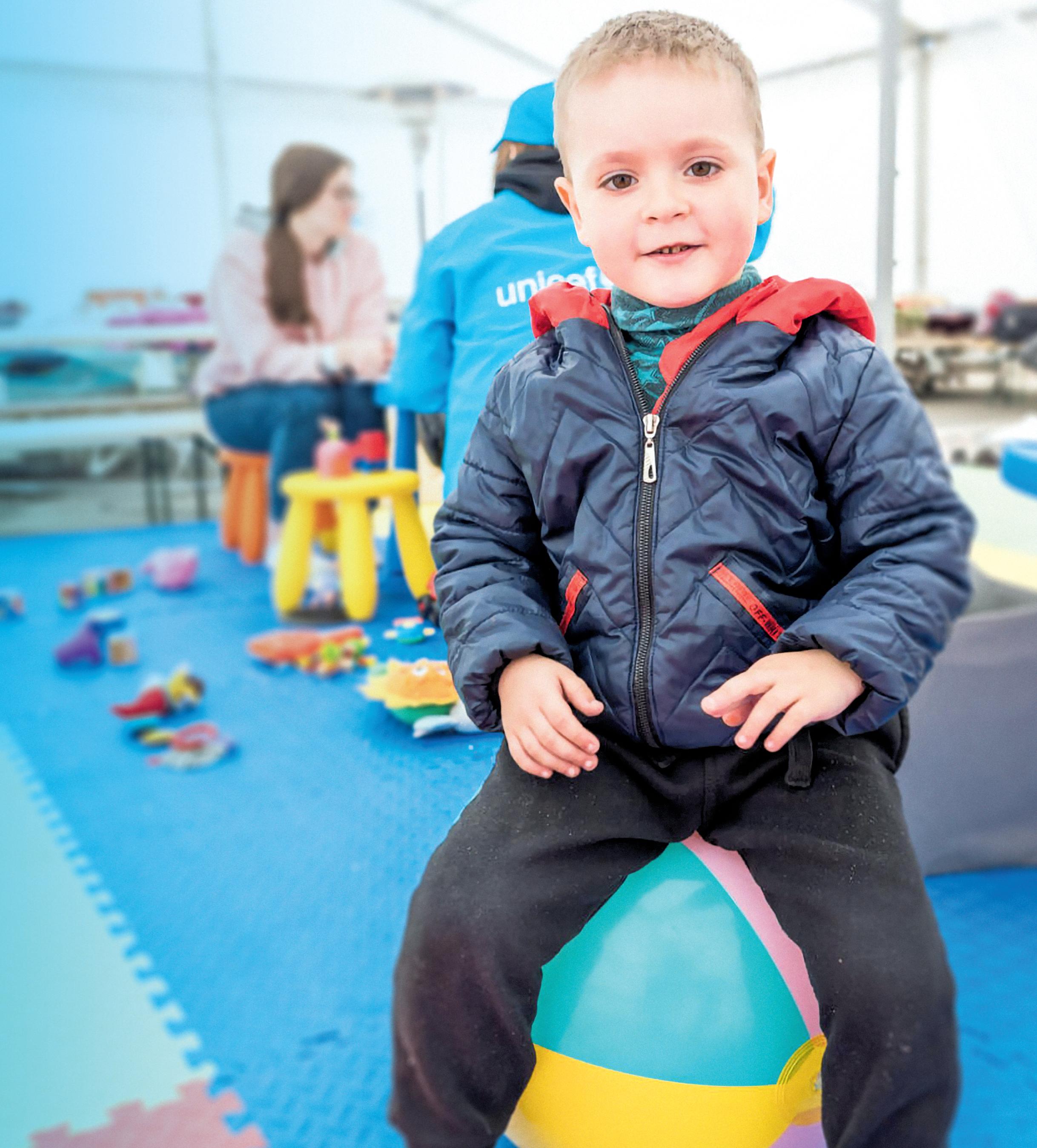
2022 has not been an easy year for children.
War, rise in hunger, the climate crisis and ongoing impacts of the COVID-19 pandemic continue to threaten the basic rights—and the future—of children globally. Their access to essential services like safe water, proper nutrition and education is being disrupted.
In Ukraine, nearly 1,000 children have been killed or injured since the war began. Over 5.5 million children remain in dire need. Continued drought in Somalia and parts of east Africa have pushed children and families to the brink of survival.
In Somalia, a historic dry spell wit h a fifth dry rainy season has left an estimated 1.5 million children likely to be malnourished by the end of the year.
But behind every statistic is a real child and their family, like
10-month-old Ubah and her mother. This young girl experienced malnu trition due to the continued drought in Somalia. Thankfully, through the support of UNICEF, she received a Ready-to-Use Therapeutic Food called Plumpy’Nut ® at a health centre. Plumpy’Nut is a life-saving, peanut-based food supplement that can help a malnourished child gain up to two pounds per week!

UNICEF is the world’s leading hu manitarian organization focused on children, working in more than 190 countries to help children survive. This holiday season, you can help us reach more children like Ubah by giving a Survival Gift, while also honouring your loved ones with one of the most meaningful gifts you can give.
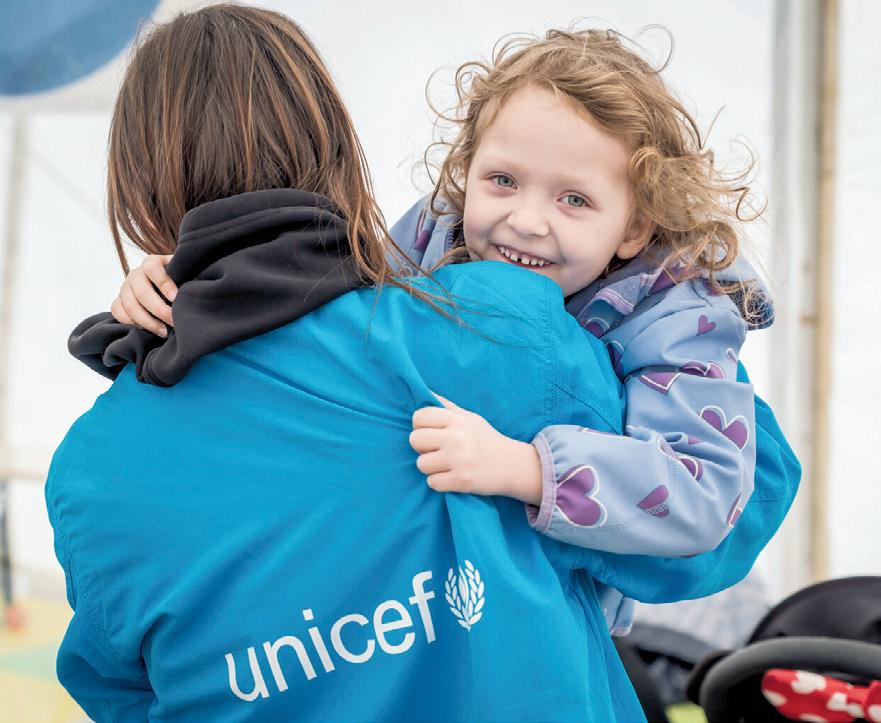
Survival Gifts ® are real, life-sav ing items shipped on your behalf to children in some of the world’s most difficult places to be a child.
There are more than 40 gifts to choose from. Your gift will be shipped directly from the largest humanitarian warehouse in the world to kids in need of immedi ate and long-term support.
And in thanks for your gift pur chase, we’ll also send a special greeting card to the loved one you wish to honour.
Thanks to someone like you, Ubah received a Survival Gift of Plumpy’Nut Therapeutic Food, used to treat malnutrition, which helped her gain weight and en ergy quickly. But millions of children still need urgent help right now. Please consider giving today at survivalgifts.ca.

PLUMPY’NUT®
THERAPEUTIC FOOD - $14 Malnourished children need to gain weight fast. This life-saving, peanut-based food supplement
can help a child gain up to two pounds per week! This gift will provide 24 packets of pro tein-rich Plumpy’Nut to nourish eight children who are suffering from malnutrition.
2X MATCH
URGENT AID FOR UKRAINE - $50

Millions of children continue to face immediate danger due to the war in Ukraine. This gift sends urgent humanitarian aid, including life-saving nutrition, ed ucation and emergency relief to 137 children and families directly affected by the war. Thanks to an anonymous donor, all Urgent Aid for Ukraine gifts will be matched up to $250,000 until the end of 2022.
EDUCATE TWO GIRLS - $80
Despite evidence showing how central girls’ education is to their
development, gender disparities in access to education persist. There are 129 million girls out of school, while many more lack basic reading and math skills. Educated girls grow up with the knowledge, skills and confidence needed to pursue their dreams and reach their full potential.
2X MATCH
URGENT AID FOR YEMEN - $50 Yemen remains one of the world’s worst humanitarian crises. Seventy per cent of the population, includ ing 11.3 million children, is in dire need of humanitarian assistance. All Urgent Aid for Yemen gifts will be matched by The Lawrence Schafer Foundation until the end of 2022, up to $25,000.
For more information and to give now, visit survivalgifts.ca
10-MONTH-OLD UBAH IS FED READY-TO-USE THERAPEUTIC FOOD BY HER MOTHER AT DOLLOW HEALTH CENTRE IN SOMALIA. © UNICEF/UN0644320/FAZEL FIVE-YEAR-OLD EMMA, FROM UKRAINE, PLAYS WITH A UNICEF STAFF MEMBER AT A BLUE DOT HUB AT THE ISACCEA BORDER CROSSING IN ROMANIA. © UNICEF/UN0622178/HOLERGA THIKRA GETS SCREENED FOR MALNUTRITION USING THE MID-UPPER ARM CIRCUMFERENCE (MUAC) TAPE IN YEMEN. © UNICEF/UN0671564 SURVIVAL GIFTS ARE REAL GIFTS WITH REAL IMPACT GUARANTEED TO REACH CHILDREN AROUND THE WORLD Scan with your phone to see more gifts and order now. Give children the immediate support they need at survivalgifts.ca © UNICEF/UN0627865/HOLERGA globalheroes.com ADVERTORIAL November • 2022
Charitable
That Makes Sense

First Nations control over how we invest in our young people, KLF invests in the limitless potential of Indigenous youth and the com munities that love and empower them, connecting commitment with unlimited potential.

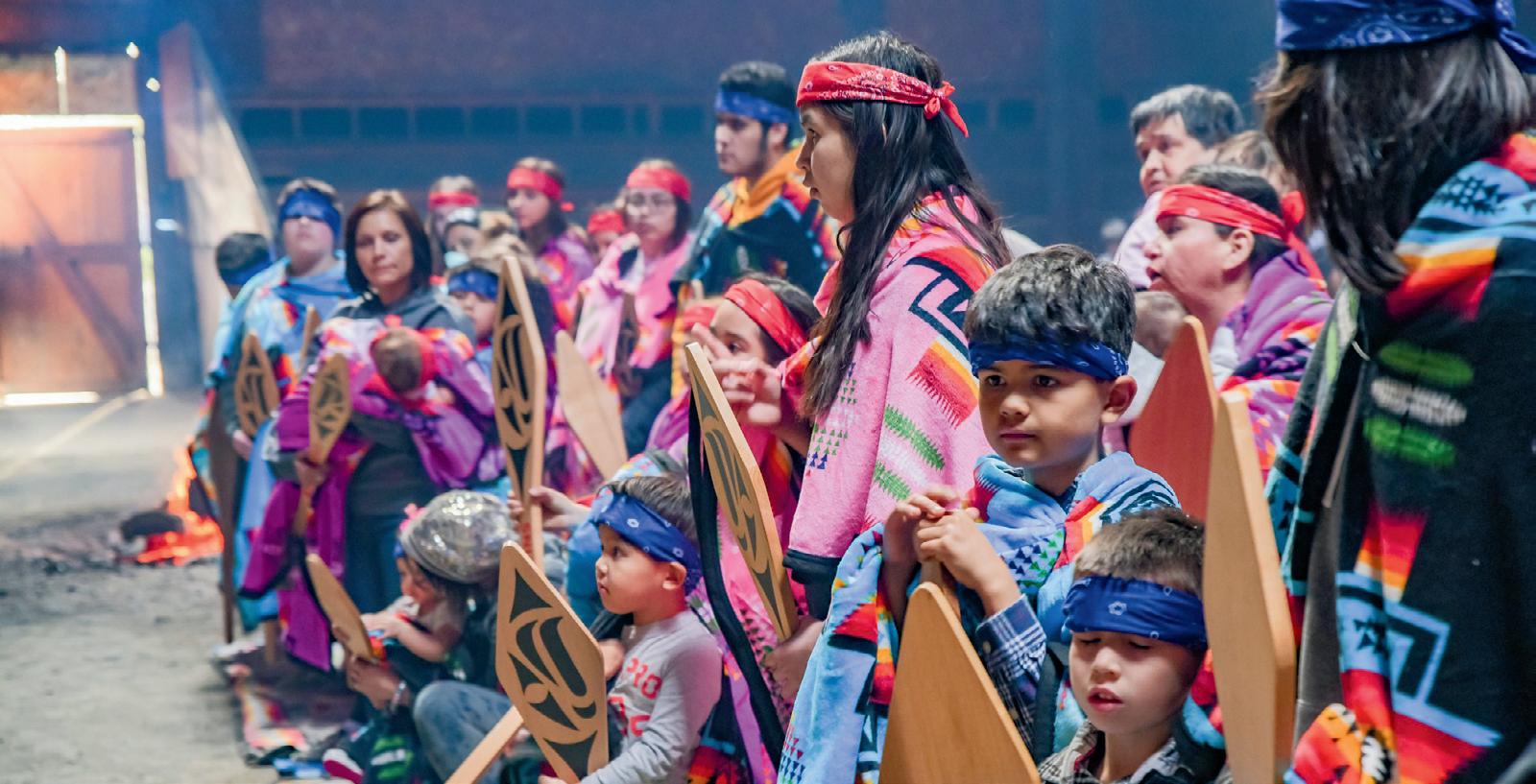
Through Indigenous-led collaborations and with a focus on inter-connectedness, KLF empowers and supports young people through forging their own self-determining paths.

Building on 25 years of trusted
children and their families. We are rooted in self-de termination and the rights of Indigenous children. KLF bene fits from and honours the Truth and Reconciliation Commission of Canada: Calls to Action. We warmly welcome businesses, industries, and individuals into the conversation.
Learn more and find out how you can be
at klfoundation.ca
involved
Investing in the limitless potential of Indigenous youth Learn how you can be involved at KLFoundation.ca © COURTESY OF KW’UMUT LELUM FOUNDATION
Giving
Abundance Canada is a registered public foundation with a long history of assisting clients and their advisors with significant and complex charitable gift planning scenarios. Learn more at abundance.ca or call 1.800.772.3257 The power of positive, solution-based journalism. globalheroes.com ADVERTORIAL ADVERTORIAL November • 2022
The Nature of Time: Seiko Takes on Sustainability
The story of Seiko began in 1881, when entrepreneur Kintaro Hattori opened a shop selling and repairing watches and clocks in central Tokyo. Today, after more than 130 years of innovation, Seiko upholds the same dedication and care to every watch that made Seiko a leading name.
Known for its long line of mile stone watches, Seiko is a leader in taking on innovation challenges, from pocketwatches to self-winding watches. In 1975, upon receiving a letter from a professional diver, Seiko engineers were shocked to hear how much strain was put on a watch by the athletes, diving to depths of 350 metres. Seiko took on the challenge, crafting the world’s first diver’s watch that would be re sistant to helium and legible at great depths. Seiko is now taking on a new challenge: returning to nature. Nature is within time, and time flows within nature. This venture upholds the Japanese affection for nature and combines it with Seiko’s passion for capturing time in the craftsmanship of their watches.
THE GRAND SEIKO STUDIO SHIZUKUISHI
Welcome to the Grand Seiko Studio
Shizukuishi, the new home of Grand Seiko’s mechanical watchmaking.
In the town of Shizukuishi, with a panoramic view of Mount Iwate, sits the Grand Seiko Studio, which opened in 2020. The studio, like the location, feels in harmony with nature, with each element carefully selected to elevate the landscape and uphold long-lasting values.
“As an architect, creating a studio that brings to life the philosophy that underpins the watches was such an intriguing and pleasurable experience,” shared architect Kengo Kuma, who designed the studio. “There is rhythm created by the use of wood. Like the marking of time, the studio’s design should also have rhythm. When designing wooden construction, I like to emphasize the ‘rhythm’ created by the wooden material just as much as its texture. With this studio, the pillars’ rhythm and the traditional Yamato Bari
layers of the wood come together as one in perfect harmony.”
Yamato Bari is a traditional Japanese style of layering wood panels so that each panel slide is slightly layered onto the next, creating a dimensional and rhythmic feel. The wood has a dual mission as well—with sustainability and long-lasting value in mind, the wood will look and feel nicer as the years go by.
“I think one can understand the oneness of nature and time intuitively, but the studio ex presses both nature and time in a very literal way with the studio’s wooden construction and the me chanical watches created,” Kuma explained. “I would be thrilled if you feel, from wearing the watch, where the watch was made and the natural environment surrounding its birthplace. Wouldn’t it be de lightful if you could feel closer to nature through a watch?”
The studio, which will produce Seiko’s line of mechanical watch es, embodies sustainability, from the making of the structure to the manufacturing that takes place within. Watches are, in a way, a representation of sustainability. The power comes from the unwinding mainspring, a natural energy, and watches often outlive their owners.
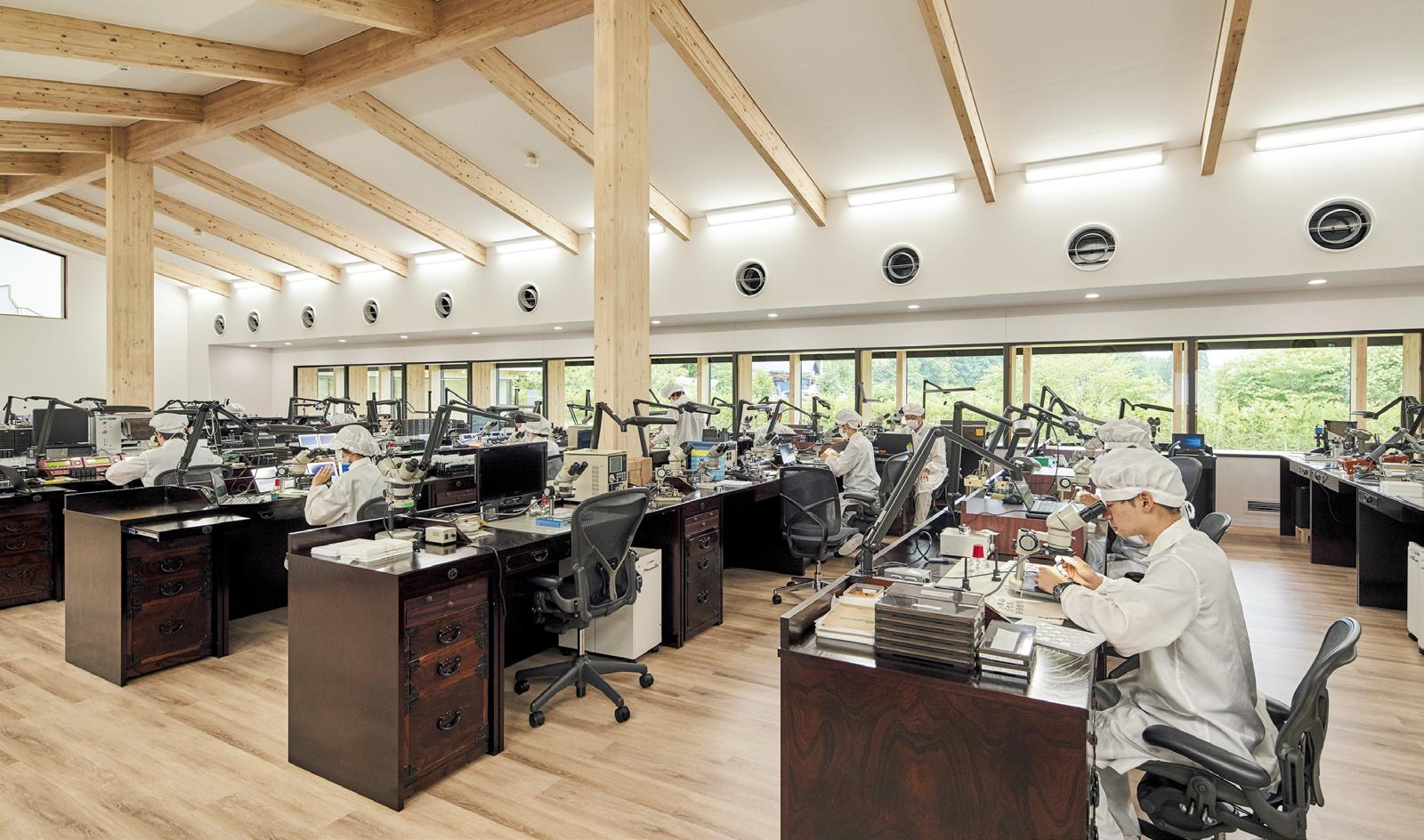
“From the earliest stages of its development, we sought to ensure that this new studio embodies the very essence of Grand Seiko and the brand’s philosophy, The Nature of Time, an idea that expresses the Japanese spirituality of time deeply inspired by nature,” said Shinji Hattori, Chairman and CEO at Seiko. “This facility will house the watchmakers who assemble and adjust Grand Seiko’s mechanical watches. It will also be where our next generation of watchmakers will learn their trade and hone their skills. The studio was created to bring all who visit it closer to Grand Seiko and its spirit of craftsmanship.”
SUSTAINABLE CRAFTSMANSHIP Seiko’s mission to return to na ture has three pillars: prioritizing sustainability, conserving its lo cal environment, and protecting its community.
Through practicing Reduce, Reuse and Recycle initiatives, the studio strives to promote effective use of resources and waste reduction by using resources efficiently and practicing wastewater treatment to reuse its water. To prevent glob al warming, the factory strives to reduce CO2 emission levels by setting target values and carrying
out continuous reduction activities, including a self-developed wireless sensor network system that mon itors the temperature, humidity, illuminance, and current levels, all to promote energy-saving.
Situated in such a beautiful land scape, Seiko regularly maintains their local environment’s natural forests and habitats. Bird and squir rel houses are installed on-site, and regular maintenance is performed to observe, investigate, monitor, and manage the distribution and breeding status of alien species.
Employees and their families periodically participate in na ture-friendly activities such as green maintenance, green zone tours, and creating insect hotels, which are boxes made from logs and grass to host insects of any species together. These boxes encourage the diversity of local vegetation.
Seiko also holds environmental briefing sessions for residents and government officials, studio tours, and information on environmen tal activities, including lectures on biodiversity and Sustainable Development Goals (SDGs).
Their work is being noticed, too. In 2019, Seiko received the “Chairman’s Award for Urban Greenery” during the “39th Green City Award Recognition,”
recognizing their maintenance to improve the quality of local green spaces and biodiversity.
THE BEAUTY OF TIME
Part of the studio’s charm comes from the design choice to have clear glass walls so that visitors can look inside and see the watches being produced.
“The essence of Grand Seiko’s craftsmanship can be seen and felt through observing the watchmakers making the watches,” said Kuma. “One of the challenges we faced was making the glass transparent so vis itors could clearly see the watches production. The beauty of Shizukui shi’s landscape and Mt. Iwate can be seen beyond the corridor.”

This design also echoes the beauty of time—visitors can see and feel the craftsmanship within the windows and, at the same time, can take a step back to take in the unyielding beauty of nature that inspires the craft.
“Our craftsmanship began 50 years ago in 1970 at this very special place,” said Yoshiaki Hayashi, President of Morioka Seiko Instruments Inc. “As a company, and as watchmakers, we were fostered by the rich natural environment that surrounds us. At Shizukuishi, the four seasons and their colours can be seen and felt clearly. The forest meets the desolate season of winter then comes back to life as the flowers bloom, and a world of fresh green appears and turns a deeper hue. In autumn, the leaves turn red, but only to fall as the land becomes white again with the winter’s snow. We are all so fortunate to witness the beauty of the changing landscape throughout the year from where we work.
“The Nature of Time speaks of the two meanings of nature; ‘es sence’ and ‘environment,’ and to be together with the cycle of na ture, and to pursue high precision watchmaking are ideas that coexist with one another. We will contin ue to realize the essence of Grand Seiko with our craftsmanship that takes inspiration from nature that surrounds us.”
CLEAN ROOM © COURTESY OF SEIKO
globalheroes.com ADVERTORIAL November • 2022
BILL’S PLACE — 10 YEARS OF HOPE
Bill’s Place: Ten Years of Hope, Healing, and Community
In just the first eight months of 2022, almost 1,500 lives were lost in B.C. due to illicit drug toxicity. That is over five times what it was just ten years ago.

In the small community of Vernon, B.C., fatal drug overdoses have increased more than anywhere else in the province.
“The stuff that’s out there, it’s not even a matter of if, it’s just a matter of when. It’s literally like Russian Roulette every time people use nowadays,” said David, a 47-yearold father of four whose addiction led him to Vernon’s streets. “I had bottoms that I never had before. I ended up losing all my material possessions. I was in shelters and even a stretch completely homeless on the streets.”
The increase in overdose deaths over ten years is staggering. But something else has been happening this past decade to quietly combat addiction in Vernon.

In 2013, Bill’s Place Recovery Home opened its doors. Bill’s Place is a 19-bed sober living community offering programs in an environ ment that feels very much like a home. Along with neighbouring
Haven Place, an eight-bed sec ond-stage recovery home, this is a community of individuals at var ious stages of recovery, supported by program staff with their own lived experience.
“It’s great that many of the facilitators have also been addicts or had struggles with addiction before.
We speak the same language,” said Robin, a 60-year-old grandmother and recent graduate of Bill’s Place.
“It’s not just about abstaining from your drug of choice. You learn about why you have those tendencies. And also, we get to the root cause of things. It’s not just about managing life without your
drug of choice. It’s about healing the things that made you vulnerable in the first place.”
Robin is 17 months sober and now working at Bill’s Place as ‘House Mom/Cool Auntie,’ giv ing back to the place she says gave her life back.
David struggled with treatment before but is now 11 months sober and feels the same way. “There’s no way in my own experience that I wanted to be living that way. It’s not fun. It’s not glamorous. It’s just suffering. That’s all it is. At Bill’s, they really do want to see people succeed. They put together a program that works. I feel like
it’s giving people their lives back.”

Over 68 clients completed the program at Bill’s Place last year. But with B.C.’s current drug cri sis, the need is growing. Bill’s Place receives almost 260 annual referrals and is on pace to reach 300 this year. With only 19 primary care beds, the wait list can sometimes be several months long.
“I see folks change their lives at Bill’s Place every day,” said Brad Houghton, Executive Director of Addiction Services for Turning Points Collaborative Society, which owns and operates Bill’s Place. “The program works, but we just can’t keep up with the demand. We need
many more beds, a dedicated dining and classroom space, and maybe even a fitness room. I dream of an entire sober living campus, with programs, treatment, affordable housing—while maintaining the community connection that is at the heart of Bill’s Place.”
David said, “I think people truly believe it is a choice, but it’s not. It is absolutely a medical illness. And it’s one that, unfortunately, doesn’t just affect the user. It’s a family illness. Right? So it trickles down. These people, they’re brothers and sisters. They’re someone’s mom or dad.”
For David, his recovery this time is as much about his own well-be ing as it is for his family’s. “The biggest difference other than peace and happiness I have for myself is knowing my family get to lay their head down with the peace of mind knowing that I’m well.”
“I think there should be about ten Bill’s Places,” said Robin. “The longer people have to wait, the more firmly entrenched they become in their addiction, you know?”
When asked what’s at stake, Robin bluntly answered, “what’s at stake is your life.”
War Child: Investing in a Future Free of War
RAYE MOCIOIU
Dr. Samantha Nutt. “But there’s a tendency to move onto the ‘next big crisis’ when issues are less immediate.”
and everything it touches, and its impact is felt long after the crisis ends. From the devastating destruction of communities to stripping their families of vital means of support to taking away their access to education and legal protection, war is ruinous.
Dr. Nutt, an award-winning humanitarian, bestselling author, acclaimed public speaker, and medical doctor, worked on the frontlines of many of the world’s major crises—from Iraq to Afghanistan, Somalia to the Democratic Republic of Congo, and Sierra Leone to Darfur, Sudan. She is a recipient of the Order of Canada, Canada’s highest civilian honour, for her contributions to improving the plight of young people in the world’s worst conflict zones. Her critically acclaimed book, Damned Nations: Greed, Guns, Armies and Aid , details her experiences working with aid organizations in conflict zones and the hard lessons she learned about how aid is given out and

received, and the issues that fall in between.
“War is never as far away as we believe it to be,” Dr. Nutt explains in the book. “It is in our pockets, generating annual returns for our pension funds, encircling our ring fingers, and filling up our cars, among other luxuries. This means that both individually and collectively, we have a far more direct influence over armed conflicts in the world than we might otherwise believe.”
THE MAKING OF WAR CHILD
“It’s hard to say this, but War Child was born out of frustration,” Dr. Nutt said. “Having arrived in Somalia as a young doctor during the famine and then working for a number of different aid organizations in very complex humanitarian environments I began noticing that certain things kept recurring all the time.”
Dr. Nutt recognized that aid organizations were largely staffed and managed by foreigners, not
locals, leading to a disconnect between those who work for the organization and those who need their support.

“It’s one thing to be an aid worker and to go into an environment and keep people alive, but it’s another thing altogether to ensure that people have reasons to live every single day,” Dr. Nutt continued. “It may sound like a cliché, but they need to have a reason to invest in a different kind of future: a future without war.”
Her realization led to an idea for a humanitarian organization that would utilize the strengths and insights of the people who live in war-torn communities— who better to develop local programming than locals themselves? Local leaders and communities have the most in-depth understanding of their needs and the specific challenges they face, making them the best-suited choice to create sustainable change, with support from War Child.
Healing and Reconciliation at Tsow-Tun Le Lum Helping House
Tsow-Tun Le Lum is a non-profit Helping House that has operated since 1988 and is recognized as a leader in serving Indigenous people in a culturally safe manner. Healing programs incorporate traditional
teachings, cultural ceremonies, and Elder teachings, along with therapeutic techniques to address the trauma that underlies alcohol and drug misuse.
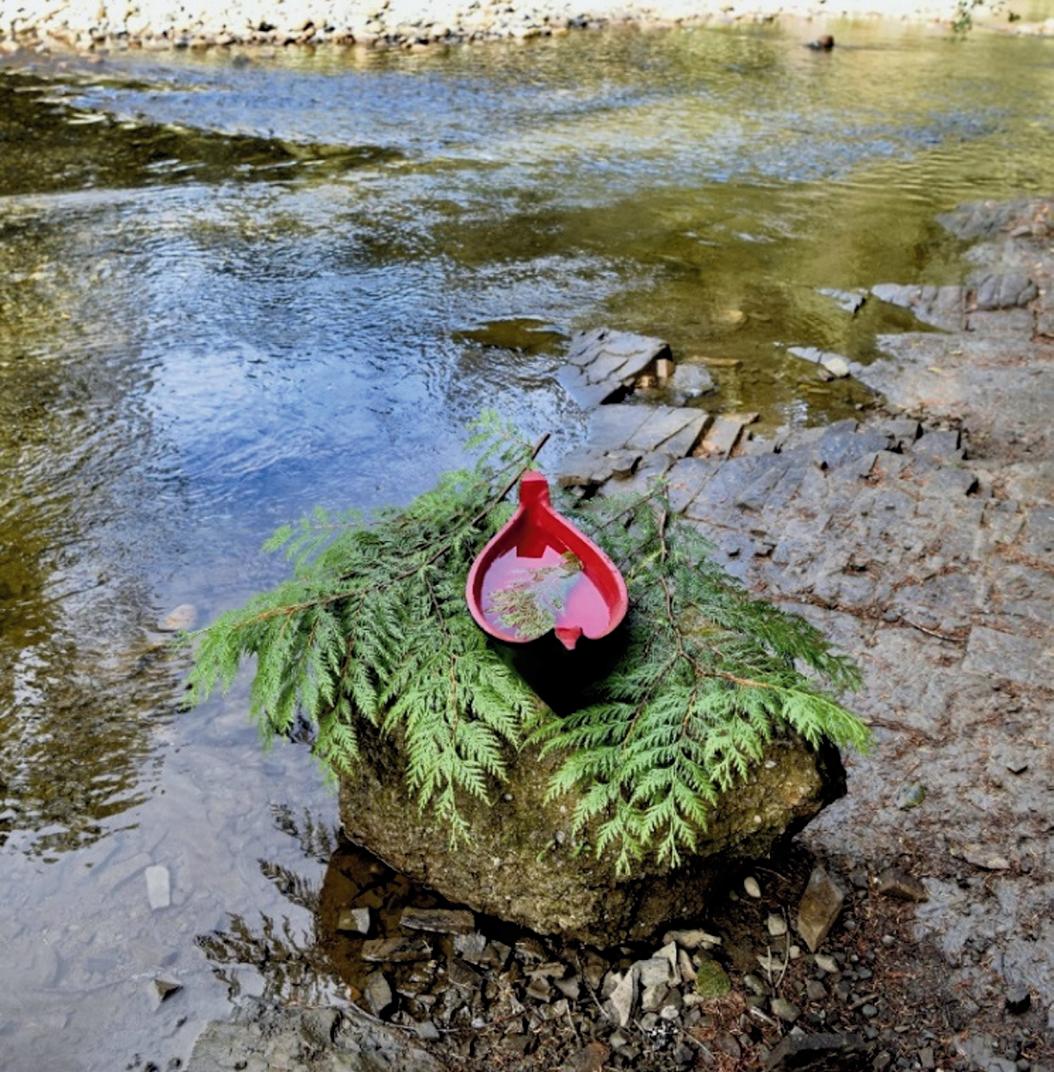
Indigenous peoples in Canada

have been victimized and traumatized in multiple ways since colonization. The effects of Canada’s Indian Residential Schools are far-reaching and intergenerational. Continued systemic racism has been rampant throughout Canadian history and remains to this day. Indian Day Schools, Indian Hospitals, the foster care system, and the outdated and racist Indian Act are examples of racial discrimination against the original Peoples of this land. These systems have enabled trauma, human rights violations, and social and cultural disruption for generations of Indigenous people, resulting in disproportionately high rates of suicide, overdose, incarceration, missing persons, homelessness, substance misuse, sexual abuse, family violence, and mental health issues within Indigenous populations.
Tsow-Tun Le Lum’s programs and services help people find healing from the traumatic effects of systemic racism and empower Indigenous participants to embrace their culture, find their individual strength, reclaim their physical,

emotional, mental, and spiritual balance, and address past trauma in healthy ways. When people feel connected and strengthened, they contribute positively to their families and communities with a renewed outlook and hope for the future.
In addition to the programs offered on-site at the centre, Tsow-Tun Le Lum also has outreach teams consisting of Indigenous Elders and staff skilled in providing cultural support and sharing cultural teachings with people of all ages and professions.
In August 2022, Tsow-Tun Le Lum’s Executive Director, Nola Jeffrey, took a team to Alberta for the Papal visit. Jeffrey shared, “We provided emotional and cultural support for hundreds of survivors. Even clergy, security guards, and other mental health workers came to us for support.”
Tsow-Tun Le Lum’s teams regularly travel to assist individ uals, families, communities, and organizations who request cultural support for various reasons, in cluding during times of crisis.
Examples include supporting Missing and Murdered Indigenous
Women and Girls (MMIWG) events, those displaced by wild fires and floods, and events surrounding the discovery of unmarked graves at previous Residential School sites. They also offer workshops on several topics related to issues Indigenous people face and suggest ways to find healing, understanding, and reconciliation.
Tsow-Tun Le Lum is moving to a new location near Duncan, B.C., and is fundraising for the construction costs of their new Helping House. As a registered charity, all donations to TsowTun Le Lum are eligible for a charitable tax receipt. All donations are greatly appreciated and will help Tsow-Tun Le Lum continue offering muchneeded programs and services for Indigenous survivors, their families, and communities.
Visit the website: tsowtunlelum.org to find more information regarding the healing programs and services Tsow-Tun Le Lum provides, along with videos of the new
© COURTESY OF TSOW-TUN LE LUM SOCIETY
BILL’S PLACE AND HAVEN PLACE SIT ON A CORNER LOT IN VERNON, B.C. THE SPACE AND MANICURED LAWNS ARE TENDED BY THE RESIDENTS AND HAVE BECOME THE JEWEL OF THE NEIGHBOURHOOD. HOUSE MOM ROBIN SAID, “I LIKE THE YARD TO MATCH WHAT IS HAPPENING INSIDE BILL’S PLACE – HEALING, GROWING, AND FLOURISHING.” © COURTESY OF TURNING POINTS COLLABORATIVE SOCIETY
The current wait list at Bill’s Place is several months long. The need is critical and we need your help to expand our Addiction Services. Please give generously at turningpoints.ngo
CONT. NEXT PAGE
“People are good at reacting to emergency situations,” said War Child Founder and President
War changes everyone
FOUNDER OF WAR CHILD CANADA SAMANTHA NUTT (L) SHAKES HANDS WITH
GOVERNOR
GENERAL DAVID
JOHNSTON (R)
AFTER BEING AWARDED THE RANK OF MEMBER IN THE ORDER OF CANADA ©
REUTERS/CHRIS WATTIE
The power of positive, solution-based journalism.
globalheroes.com ADVERTORIAL ADVERTORIAL November • 2022
Embarking on the Journey to Recovery
“It took me a while to realize he needed help…in hindsight, I was probably in denial. The fact that my husband was addicted to opi oids was a hard reality to face,” said Cheryl, whose husband Jim struggled for a decade with a severe Opioid Use Disorder. It was not until she found Jim unconscious on their living room floor that they explored treat ment. Like one in ten British Columbians, Jim suffered from substance dependency. But, un like the five British Columbians that die from overdose daily, Jim was resuscitated.
A Substance Use Disorder (SUD) is a clinically significant impairment caused by repeated use of drugs or alcohol, including health problems, physical disabil ity, and failure to meet responsi bilities at work, school, or home. Substance use issues can affect anyone irrespective of age, sex, so cio-economic status, or ethnicity. With 20 per cent of the Canadian population experiencing a sub stance dependency, the likelihood of you knowing someone who is struggling is high. It could be your
co-worker, your neighbour, your parents, your child, or in Cheryl’s case, her husband.
Fortunately, there is treatment available for individuals suffering from substance dependency.
Cheryl reached out to Pacifica Treatment Centre (Pacifica), a registered non-profit that provides in-residence treatment and community supports to individuals dealing with
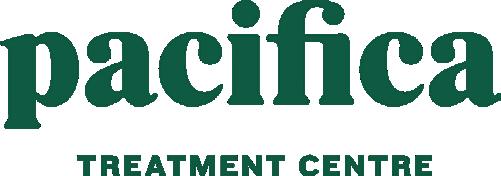
problematic substance use in conjunction with mental health and trauma. “We didn’t know what to do, Jim wanted help, but we didn’t know how to get it…Pacifica made the journey simple,” Cheryl said.
Jim enrolled in the 84day in-residence program at Pacifica. Over his 12 weeks on site, he participated in various forms of therapy (including group, individual, art, and psychotherapy), learned about nutrition and its impact on substance dependency, and participated in integrative wellness programs such as yoga and acupuncture. “I liked the holistic approach at Pacifica, it made me think about my recovery as more than physical, I was working on my mind, body, and spirit,” said Jim of his experience. “The hardest part of recovery is feeling confident that you can do without drugs when you are on your own…but Pacifica didn’t leave me alone. I am two years sober, and Pacifica’s alumni programming has been instrumental in that.”

The comprehensive in-residence programming, private accommo dation, nutritious meals, and up to two years of post-graduation supports, have resulted in a high rate of recovery and continued engagement with Pacifica.

In Canada, it is estimated that 21.6 per cent of the popu lation will meet the criteria for substance dependency in their lifetime. For individuals to over come substance use, treatment centres are essential. Treatment centres provide supportive envi ronments where individuals can focus on their recovery journey. Through treatment, individuals can reclaim their lives.
If you or a loved one is in need of treatment for substance depen dency, please reach out to info@ pacifica.ca or (604) 872-5517. Pacifica has 45 years of experi ence and can support in creating a customized journey for you or your loved one.
You can make a life-changing financial contribution.
Donate and help save lives at pacificatreatment.ca
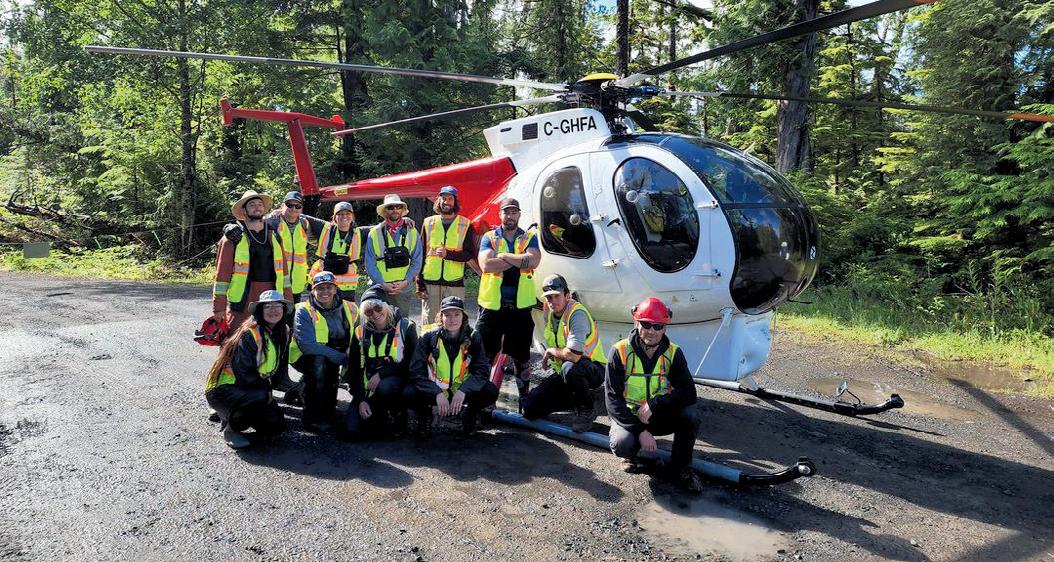
“There are only so many wars to fight, whereas the possibilities for investing in reconstruction, reconciliation, democratic development, health care, and social welfare for at-risk populations are nearly infinite,” Dr. Nutt shared in Damned Nations
BRIDGING THE GAP
War damages every aspect of a child’s life and makes it impossible for children to enjoy their childhood. Dr. Nutt’s experiences across dozens of conflict zones across the globe gave her firsthand insight into how war impacts not only communities but children and their families.

Humanitarian organizations often focus on the short-term needs of communities in crisis. While these measures can be incredibly helpful, they leave a gap in long-term support, dealing with the conditions that contribute to violence and instability. War Child exists to bridge the gap between short-term emergency relief (primarily food, health care, water, and shelter)
and long-term development programming that can help break the cycle of poverty, violence, and despair that so many are facing in war-torn communities. Even when the headlines disappear, War Child remains on the ground, knowing that the work is not over yet.
For over 20 years, War Child has worked with children and their families at the frontline of the world’s major crises. War Child uses a bold, communitydriven approach to deliver programs that give children the best chance to overcome the challenges of war and grow up to see a brighter future.
War Child supports more than 600,000 women, children, and families annually. They provide numeracy and literacy classes to vulnerable women and catch-up education to children who have missed out on years of schooling. They work with women and youth, offering skills training and small business loans so that they become less aid dependent and lift their families out of poverty, and protect the rights of women
and children through access to justice programs. War Child also works to enhance public education and awareness through music and other artsbased initiatives.
It’s a long-term holistic approach that seeks to end cycles of violence and poverty and sets up women and children to look forward to brighter futures. What makes it possible is that 99 per cent of War Child’s staff are locals to the communities the organization works with, allowing them to build systems of change and empowerment not just for these communities but within them. The hope is that one day War Child won’t be needed anymore, and communities will be able to continue this critical work on their own.
For now, War Child’s work is far from over. In many countries where War Child works, including Yemen, Afghanistan, and Sudan, communities face urgent food crises. War Child’s team of local staff work from within to train farming families, especially those that are female-led, to develop sustainable farming methods.
In Sudan, War Child has provided close to 50,000 internally displaced people with agriculture and business training and access to seeds and livestock to ensure long term food security for those most in need.
“Many of War Child’s local staff and partners—

they are doing extraordinary things for humanity against immeasurable odds,” Dr. Nutt shared. “Yet they bring such a deep conviction that they can change the status quo—that they can build something that is better for themselves and for their children. To me, that is just awe inspiring.”
An EPIC Solution to Plastic Pollution
Over the last 60 years, the use of plastic has grown exponentially. Plastic is inexpensive, light weight, and durable in nature, al lowing it to be applied in a broad array of applications, including packaging, automotive, household products, electronics, construction, and marine sectors. However, it is estimated that more than 75 per cent of all plastics that have been produced have become waste, while substantial quantities of plastic ac cumulate in landfills and natural ecosystems worldwide. Plastic pol lution is now found in the deepest depths of the ocean (10,975 metres under) to mountain tops of more than 3,000 metres in altitude and is known to entangle, starve, and suffocate wildlife, as well as intro duce invasive species that may affect endangered and sensitive species. Other major global issues induced by plastic pollution include ship ping hazards, dangers to fisheries and other maritime activities as well as economic loss from prop erty damage. Despite the growing global impact of plastic pollution, plastic manufacturing and trade are rapidly growing sectors, now
producing more than 450 million metric tonnes of plastic every year.
If significant improvements are not made to plastic management systems worldwide, plastic in aquatic and landfill environments is estimated to increase to 12,000 million metric tonnes by 2050.

There are no proven formulas that provide one solution to end ing the plastic pollution crisis.
However, over the better part of a decade, the Ocean Legacy Foun dation has been developing a robust program, which fuses the Blue and Circular Economies together for the Pacific Northwest; catalyzing a hub to clean up coastal environments,
develop skilled employment, and build critical infrastructure to re circulate precious resources back into the plastic economy. The pro gram is called EPIC, an acronym that integrates Education, Policy, Infrastructure, and Cleanup as an emergency response program to combat and end plastic pollution. The program identifies, removes, and prevents plastic pollution from occurring or entering aquatic and land-based natural environments. The purpose of EPIC is to create practical solutions that are accessible for communities around the world to restore critical natural habitats for improved human and wildlife
health, as well as assess and develop long-term plastic collection, pro cessing infrastructure, stimulate green employment and lend to policies that mitigate plastic pol lution sources.
With support from the Depart ment of Fisheries and Oceans, the BC Ministry of Environment & Climate Change Strategy, region al districts, non-profits, coastal Indigenous communities and var ious sponsorships and donations from concerned citizens, Ocean Legacy has now opened the first and only industrially scaled pro cessing facility in North America, focused on 11 different streams of
materials collected from ocean, shoreline and marine industri al cleanups, located in the heart of Steveston Harbour, British Columbia. These operations are dovetailed with a quickly evolving province-wide ocean plastic depot program to divert select plastics such as rope, netting and oyster baskets from landfill and the nat ural environment. The program focuses on processing high-density polyethylene, polypropylene, and nylon, and has diverted more than a million pounds in just under two years of operations. Programs are currently focused in British Columbia with expansions under way in Mexico and Panama and growing interests along the East Coast of Canada.
Please support Ocean Legacy by visiting our website at oceanlegacy.ca to make a donation, join our free e-learning Academy to take action in your community, apply to join our growing cleanup and facility teams or purchase plastic pellets made in-house from materials collected from clean-up.

PELLETS MADE FROM BUOYS © OCEAN LEGACY FOUNDATIONCLEANUP NORTHCOAST © HIGGY PHOTO / OCEAN LEGACY FOUNDATION
HOW WE COMBAT PLASTIC POLLUTION IS EPIC. OC E A N LEGACY CA © COURTESY OF PACIFICA TREATMENT CENTRE PACIFICATREATMENT.CA CONT. PREVIOUS PAGE
© WAR CHILD CANADA
The
power of positive,
solution-based journalism. globalheroes.com ADVERTORIAL ADVERTORIAL November • 2022
Help Kids Keep Their Curiosity Through STEM
When a child is young, science is everywhere. Children are natural, curious learners and the way they explore and discover the world is inspiring. A child can pick up a rock in a field and play for hours. Fossils, bugs, dirt…it is all exciting and interesting. But, at some point in that child’s education, science becomes a chore, and they begin to disengage from it, dropping STEM (science, technology, engineering, and math) courses in high school and closing doors and opportuni ties for their future.
That young child will encoun ter a number of critical barriers to their STEM engagement while they are growing up, including lack of perceived relevance, lack of awareness of post-secondary pathways and careers, lack of meaningful or relevant role mod els, teachers lacking resources and training, and parents who may have their own STEM phobias and misconceptions.
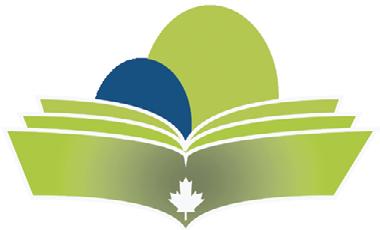
Let’s Talk Science understands the education system and is working to tackle these barriers through STEM-based program ming because it builds on kids’ natural curiosity about the world.
Pakistan
ALLIE MURRAY
When torrential monsoon rains began in Pakistan in July 2022, CORE (Community Organized Relief Effort) acted quickly, meeting with local leaders and partners to address the critical needs of those affected in the Sindh province. Now, some four months later, the region is still feeling the effects of the disaster—but working towards rebuilding with the help of the humanitarian organization.
CORE arrived on the ground in Karachi in September to outline a plan of action and determine what needed to be done. The team began distrib uting hygiene kits, feminine hy giene kits, mosquito nets, cash assistance, medical supplies, and dry food with the help of local organizations.
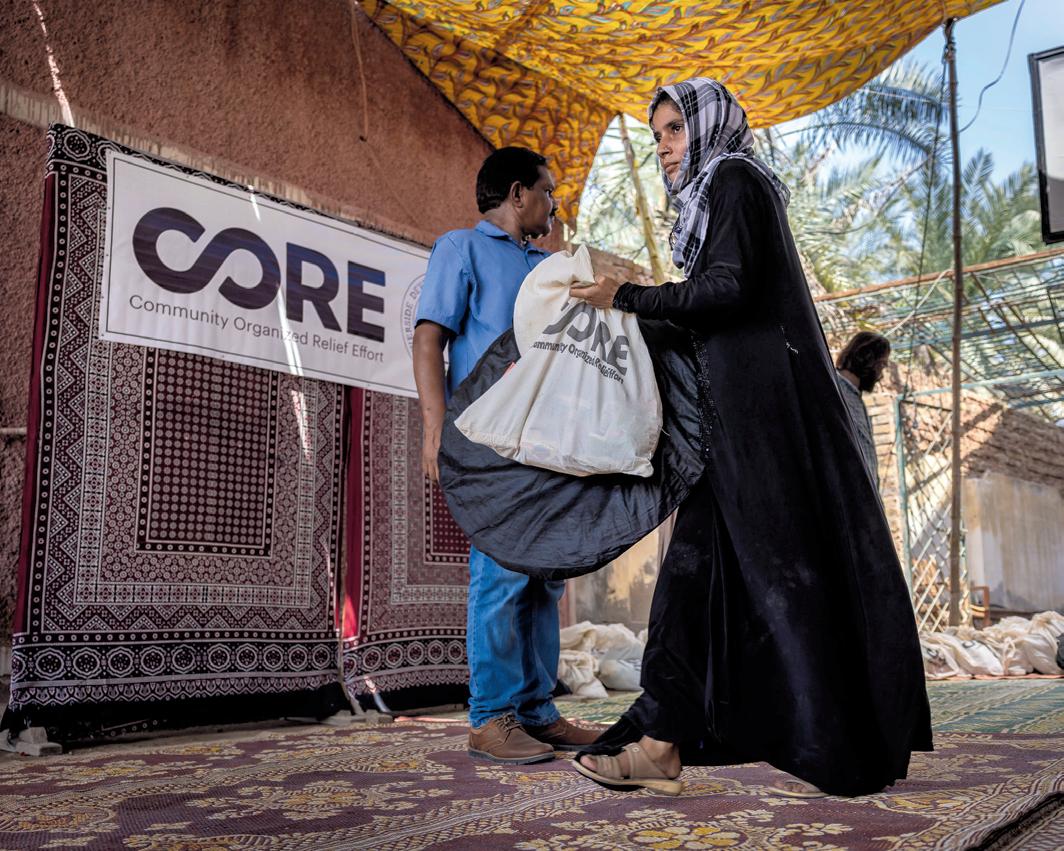
The organization, run by Sean Penn and Ann Lee, has responded to countless tragedies worldwide: most recently, the war in Ukraine. Similarly, the team has worked on the ground in New Orleans, Haiti, and Florida, among others.

CORE responds to crises
Our programming builds critical competencies that everyone needs while helping youth understand the important subjects that un derpin today’s global challenges.
Our audacious goal is to be a partner in every school and positively impact every youth in Canada—all 6.5 million of them. However, we know that we can’t do this alone.
Through the generous dona tions of individuals, companies, foundations and government agencies, Let’s Talk Science can continue to provide its STEM-ed ucation programming, resourc es and events—in English and French—at no cost to youth, educators, parents/caregivers and community groups.
Together, we can help more children to retain the initial won der that science offers them, sup porting youth in Canada as they prepare for their work and citizen ship demands in an increasingly complex world.

Donations to Let’s Talk Science ensure cost is never a barrier for children, youth, volunteers, ed ucators, and parents/caregivers across the country. Through
your support, we can reach more teachers, schools and community partners, deepen our engagement with children and youth, and see long-term, sustained impact in the education sphere.
“Whether building tech ca pacity, offering equitable, free programming, or facilitating workshops for our teachers/stu dents, Let’s Talk Science has been a blessing to us,” said Matt, an educator in the Lambton-Kent District School Board. “[Let’s Talk Science provides] students oppor tunities to ask questions, challenge their thinking, and learn in new and exciting ways. Overall, Let’s Talk Science has always been an incredibly positive influence in our board’s program planning.”
Your donation helps Let’s Talk Science provide equitable access to meaningful STEM pro gramming in person and online for children and youth across Canada. Your gift will help us inspire wonder in the next gen eration of Canada’s leaders.
Make a difference in a child’s life today. Donate now at letstalkscience.ca/donate

Is On
immediately to fill gaps, mobilize resources, and establish trust and collaboration from within communities. Co-founder Sean Penn started the organization within hours of the devastating earthquake that struck Haiti in 2010. After feelings of frustration amid recovery efforts in Haiti and Hurricane Katrina in New Orleans, he wanted to do more to help—and CORE was born.
The crisis in Pakistan has been astronomical, with more than 7.9 million people displaced, two million homes damaged or destroyed, and 1,600 confirmed fatalities. However, despite the crisis, support organizations have received minimal donations, and the tragedy in itself has seen limited media coverage.
Donations are critical to CORE’s ability to offer services
in countries like Pakistan. As the fifth most populated country in the world, Pakistan is struggling to recover—leaving hundreds of thousands of people displaced and without access to clean water and food.
“The lack of aid being provided by the international community to Pakistan is a brutal repetition of an alarming historical pat tern,” CORE VP of Programs Mathew Chandy explained. “We have worked in many emergency response efforts in the Caribbean, South America, India and the U.S. with Indigenous nations, and unfortunately those crises do not generate the news coverage, do nations and global support on the same scale as Western/European, industrialized nations. We have seen this cycle repeat itself in Haiti and Puerto Rico. If we do not provide the much-needed support to help the Pakistani people to rebuild their communities now, we will inevitably face another disaster that will have more dire outcomes because we never fixed the infrastructure during these terribly destructive floods.”
In August, Pakistan received
more than three times its usual rainfall, which according to ABC News, made it one of the area’s deadliest natural disasters in five decades. The Federal Minister for Climate Change Sherry Rehman said one-third of the country was underwater.
“We are at the moment at the ground zero of the front line of extreme weather events, in an unrelenting cascade of heatwaves, forest fires, flash floods, multiple glacial lake outbursts, flood events and now the monster monsoon of the decade is wrecking non-stop havoc throughout the country,” Rehman said.
According to EU data, Pakistan is responsible for less than one per cent of planet-warming global emissions but is ranked as the eighth most vulnerable nation to the effects of climate change.
CORE continues to provide critical support to communities that have been devastated by the floods in Pakistan. After begin ning relief efforts in the Sindh province, the organization contin ues to evaluate what the needs are on the ground, particularly for the most vulnerable communities.
Just Like Home: Together When Families Need It Most
Imagine your loved one need ing vital medical care, life-sav ing surgery, or cancer care. Now imagine driving more than 200km to access that care. Campbell River Hospital serves


32 communities and is the first point of referral for emergencies and illnesses, including indus trial and workplace accidents, heart attacks, strokes, respiratory problems and other diseases.
During moments of crisis, this travel time, combined with finding appropriate accommo dation near the hospital, can contribute to increased emo tional and economic stress for both patients and their families. For these reasons, some will also postpone or forgo medical care. Unfortunately, when they do visit our hospital, their health is at greater risk.
For Lisa and her family, trips to Campbell River Hospital are all too familiar. Both Lisa’s father and mother-in-law battled cancer in Campbell River, and being able to visit them meant staying in hotels nearby and stocking the hotel room mini-fridge with groceries. In times of crisis, having loved ones nearby can be incredibly healing; however, Lisa’s family knows all too well that the cost of accommodations, food, and parking can quickly add up and put a sizable strain on a family’s income.
A few years ago, right as COVID-19 was beginning to spread, Lisa suffered what she and doctors thought was a stroke

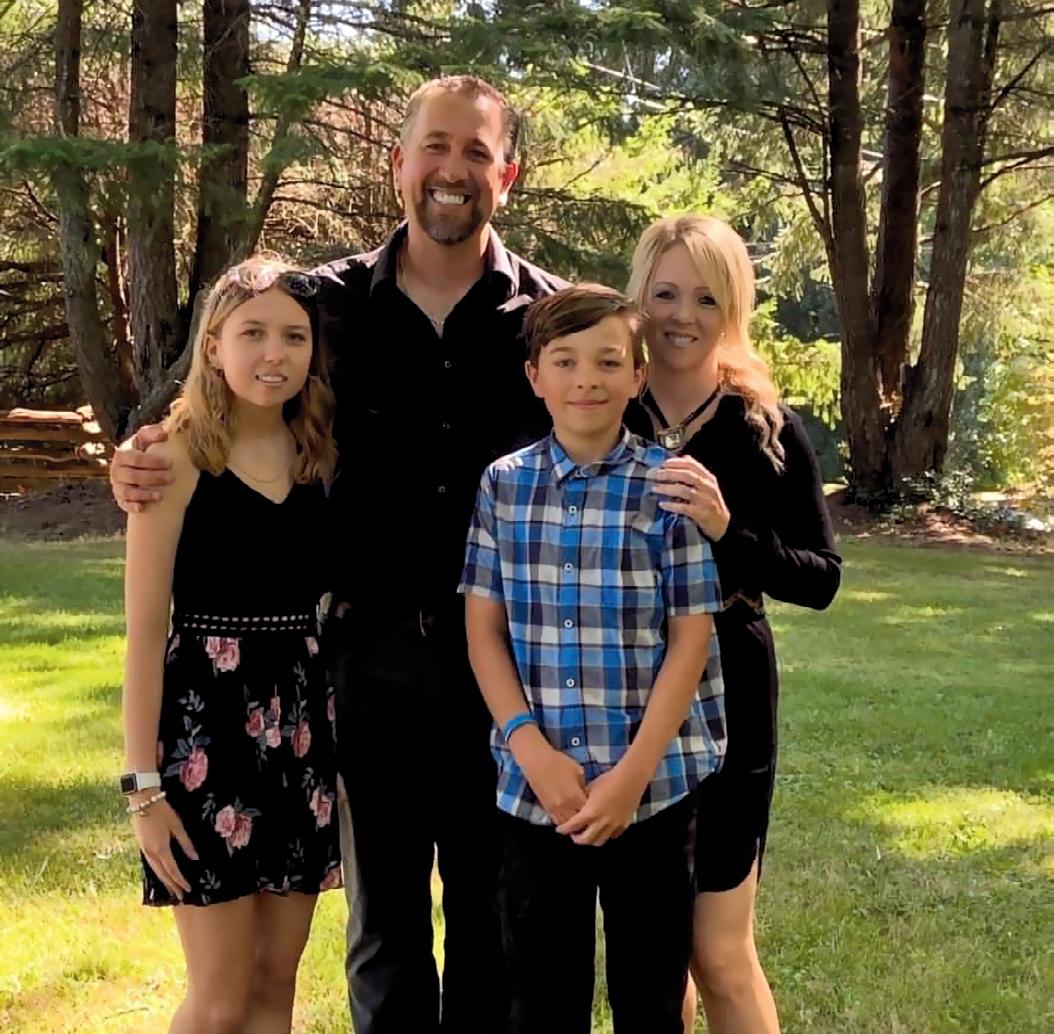
and spent time in Campbell River Hospital. Although her doctors have determined that she did not suffer a stroke, Lisa continues to live with an undiagnosed illness and the subsequent follow-up medical appointments and testing. These trips, while vital, have placed an immense financial and emotional strain on Lisa’s family, from the cost of travelling back and forth to finding appropriate accommodations. The Just Like Home Lodge would have made all the difference in the world to Lisa and her family.
The Just Like Home Lodge will be a safe haven for patients and loved ones who find themselves having to travel to Campbell River for specialized care or procedures that are not available in their home communities. This 10-bedroom lodge will feature separate sleeping rooms with private washrooms, a communal living space, a shared kitchen and laundry facilities. The plans also include areas for Recreational Vehicles with hook-ups and a
walkway with easy access to the hospital.
ABOUT CRHF
The Campbell River Hospital Foundation (CRHF) is a team of professional staff and community-minded leaders who are passionately committed to inspiring, enabling and celebrating community support for Campbell River Hospital. With your support, we can help ensure that our doctors, nurses and other key members of our healthcare team have the tools and equipment they need, so you and your loved ones continue to receive first-class healthcare right here at home. With your help, we can help keep families close when it mat ters most.
Scan to Watch Lisa’s Story
With your help, we can help keep families close when it matters most. crhospitalfoundation.ca Give Because You Care LISA AND HER FAMILY © COURTESY OF CAMPBELL RIVER HOSPITAL FOUNDATION
let s t alk science.c a
Donate Now!
With your help, Let ’s Talk Science can provide free, bilingual STEM programs and resources so youth in Canada are prepared to tackle the big s tuf f
Needs Help—And CORE
The Ground Ready to Give It PAKISTAN HYGIENE KIT PACKING AND DISTRIBUTION © 2022 COMMUNITY ORGANIZED RELIEF EFFORT (CORE)/LIAM STORRINGS NOW I CAN READ WITHOUT GUESSING RRCANADA.ORG The power of positive, solution-based journalism. globalheroes.com ADVERTORIAL ADVERTORIAL November • 2022
Awarding Excellence and Sparking Innovation
When life brings the unexpected, people need support from their communities. The COVID-19 pandemic was no different, with communities across the globe witnessing the power of people and communities coming together to care for each other in real and meaningful ways. Known for the delivery of the Parking Permit Program for People with Disabilities, the Social Planning and Research Council of BC (SPARC BC) has worked for almost 60 years with communities to seek out creativity and innovation designed to build a more just and healthy society for everyone.
Since 1966, SPARC BC has worked on the ground and at the policy level by providing research and information. SPARC BC is committed to working for positive policy change to meet the needs of underserved populations including seniors, people with disabilities, and families and children experiencing poverty. SPARC BC is also committed to addressing systemic issues like food insecurity, housing and homelessness, and income insecurity and poverty. Through focusing on needs that are not yet met, SPARC BC seeks to create a better future for others because we know the future always grows brighter when everyone is included.
SPARC BC DERYCK THOMSON AWARD NOMINEES

The Deryck Thomson Award, named after Deryck Thomson— one of SPARC BC’s founding Directors and the first social worker in B.C.—recognizes individuals and organizations who reflect the ideals of social planning and social justice and who have gone above and beyond in their efforts to make a difference in their communities.
While we know there is still much work that needs to be done to achieve our vision of a just and healthy society for all, we feel fortunate to have the privilege of a generous membership and donor base who support our work and who believe in the difference that can be made
when people and communities work together. We also have the benefit of working with individuals who willingly share their wisdom and their belief that better is possible. To this end, we would like to recognize and thank the following Deryck Thomson Award nominees for standing in their truth in ways that help to make each of us better citizens.
This year we would like to recognize THE TK’EMLÚPSTE SECWÉPEMC FIRST NATIONS for sharing their grief and pain at the discovery of the 215 unmarked burial sites on the grounds of the former Residential School. Recognizing the deep pain of their experience has provided an important call to action for each of us to stand beside them and all First Nations to acknowledge their loss and to ensure that all Canadian understand what it means to say that ‘every child matters.’
We would also like to recognize
THE SAVAGE SOCIETY for their use of myths and storytelling as a way of building a connection to
the past while looking forward to the future. In their celebration of the cultures and traditions of the Nlaka’pamux people of Lytton, British Columbia, THE SAVAGE SOCIETY has offered us important insights into the history of a community that will be forever changed by the devastating wildfires of 2021. In presenting this Award, we want to thank THE SAVAGE SOCIETY for showing us the power of having a connection to the land through their stories of ash EETLemsh a demEEwh (Songs of the Land). May this kind of history give strength to the people of Lytton as they continue to rebuild.
As society continues to face multiple crises, whether it is the lingering impact of the COVID-19 pandemic, the devastating effects of extreme weather and other climate emergencies or the war in Ukraine, it is clear we live in an interdependent world where we have a responsibility to care for each other. As events swirl around us, it is easy to forget
© PEXELS/ANDREA PIACQUADIO
some of the simple joys that can help to nourish the spirit, including simply being a child.
To this end, we want to recognize the efforts of Julia of JULIA’S JUNCTION and her parents for their commitment to ensuring that every child has the chance to experience the simple and carefree joys of playing with their friends. Through the presentation of the Deryck Thomson Award to JULIA’S JUNCTION, it is our wish to remind each of us of the importance of people and communities coming together to remove barriers that limit others. For Julia and her parents, we wish to recognize your commitment to true inclusion and your belief in the power of community.
SPARC BC’s Board of Directors also wishes to recognize the importance of the work of Sharon Karsten and the WALK WITH ME PROJECT, which was developed in response to the growing number of lives lost to the toxic drug poisoning crisis and the sense of pain and loss experienced by those who use drugs,
their family members as well as front-line workers. Through WALK WITH ME, Sharon uses cultural mapping and stories to create a space that allows communities to come together to talk about their grief and loss and to remember those who are gone. Not only is WALK WITH ME about coming together as citizens and individuals who are at the heart of the crisis, but it is also about collectively reimagining a better future.
The final Award goes to Linda Lavallee for teaching us the power of humility and resilience. Raised in Timber Bay, Saskatchewan, Linda learned how to bead and sew from her mother, aunties and grandmothers and is known for her talent and creativity. Linda is also known for her tireless commitment to addressing the issue of homelessness and for her work with vulnerable youth. A few years ago, after an incident of racial profiling left her feeling shocked and hurt, Linda decided to use the skills she had learned in her childhood to make a new “ribbon skirt” each day as a way of walking proudly and celebrating her culture. Linda found that as she surrounded herself in her culture, she could feel her ancestors walking beside her. Through the presentation of the Deryck Thomson Award to Linda we want to recognize our shared citizenship as well as the importance of walking together without judgment.
The Deryck Thomson Award represents the difference that each of us can make in our communities and in the lives of others.
Strengthening B.C.’s communities starts with caring and from support from within. SPARC BC’s donors and members are committed to positive social change and believe in the importance of people and communities working together for a better future. There is still much to be done to promote greater equality across communities, and we invite you to join us in working for positive social change.
Visit sparc.bc.ca to learn how you can become a member or help to make a difference.


Visit sparc.bc.ca to donate or call 604-718-7733 Advancing social justice and inclusion SPARC BC is committed to building a just and healthy society for all.
globalheroes.com ADVERTORIAL November • 2022
Seeing Her Smile and Dreams Come to Life
It was obvious to Yvette’s mother that her three-year-old daughter was struggling to see. But Burundi, where they live, has only 16 oph thalmologists and two optometrists for a population of almost 12 mil lion people. Her mother worried about her daughter’s happiness and future opportunities.
As any mother would, Yvette’s mother went to great lengths to help her daughter. When she fi nally found a doctor to examine Yvette’s eyes, she was relieved when told it was just allergies. The respite was short-lived. The medicine pro vided didn’t help Yvette’s vision.
Using what little money the family earned from farming, Yvette’s mother took her daugh ter to different hospitals, hoping to find a cure. Unfortunately, the hospitals didn’t have a doctor who specialized in eye care.
When Yvette was old enough to go to school, her mother’s fears for her future increased. Yvette couldn’t see clearly enough to fol low the lessons on the blackboard or read her textbooks. She was forced to drop out of school and became isolated and depressed. Yvette rarely smiled.
“Without proper care and local ly available eye care services, chil dren like Yvette often don’t finish school or learn a trade and will continue to live in poverty and face life-long challenges. This is especially true for girls, who make up two-thirds of the world’s chil dren who are blind or visually-im paired but are only half as likely as boys to receive care,” explained Penny Lyons, Executive Director of Seva Canada (seva.ca).
Lyons says that’s why Seva Canada donors fund free eye screenings, prescription glasses, and surgeries for thousands of children in low-income countries each year.
With little hope remaining, the now eight-year-old Yvette and her mother made the treacherous and long trip to Bujumbura, the capital. There they visited the CTSOE (Centre Tertiaire de Santé Oculaire de L’Enfant/Tertiary Child Eye Health Center), the only eye hospital in Burundi capable of treating children with severe visual impairment and blindness.
At the CTSOE, Yvette was examined by ophthalmologist Dr. Levi Kandeke, Seva’s partner,
who diagnosed her with cataract. Thanks to the generosity of Seva Canada donors, Yvette’s sight-re storing surgery was free of charge.
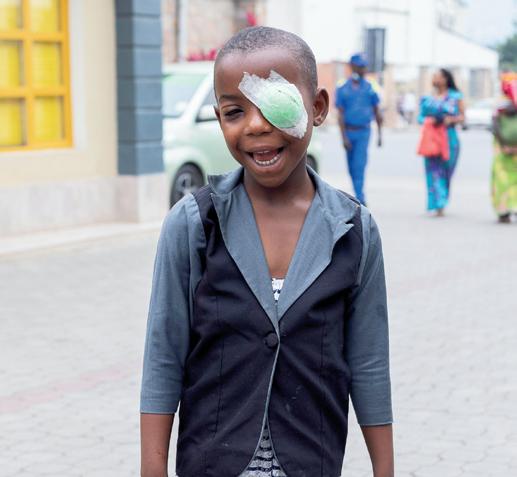
The next day, Yvette’s mother couldn’t contain her excitement and relief! “I am happy she can smile now. She will be able to go back to school and follow along in class! She can follow her dreams!”
When you give a child the power of sight, you are also giving them access to education, employ ment, and the foundation for a better life, full of potential.
Learn how you can help the over one million children living with treatable blindness in low-income countries see and succeed at seva.ca
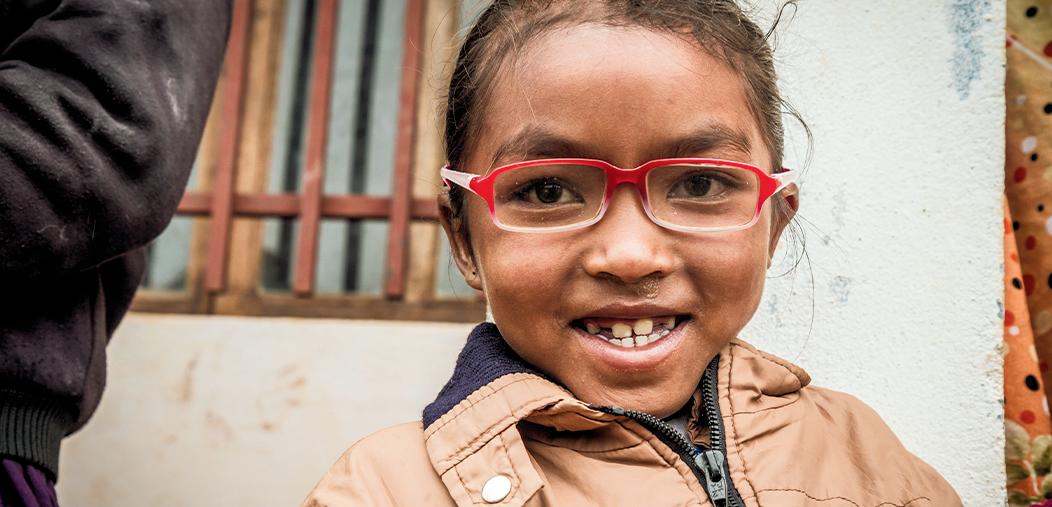
HelpKids See aNd suCceed

 ALLIE MURRAY
ALLIE MURRAY
Sport is a powerful thing—one that is known all too well by Rab Hare, who, before partaking in the Homeless World Cup, was living on the streets of Glasgow.
Hare started his career as a pro fessional soccer player but went into early retirement, not from an injury but a prison sentence. After coming out of prison, he went through a breakup, lost his house and job, and lost three friends to suicide within five months.
He ended up sleeping on the street, in hostels and shelters, when he then discovered the Street Soccer Programme. From that program, he was chosen to represent Scotland at the 2011 Homeless World Cup.
By 2016, Hare was instrumental in organizing that year’s Homeless World Cup in Glasgow. Then, two years later, in 2018, he returned once again as the coach for Scotland’s Homeless World Cup team.
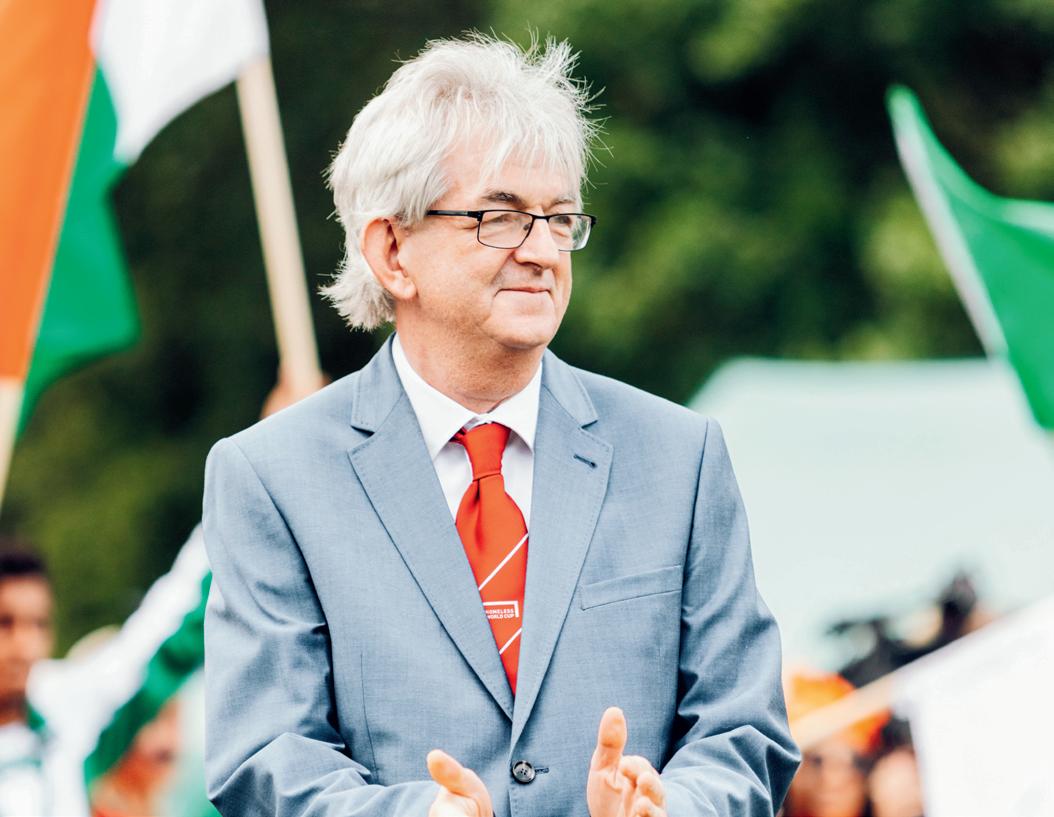
With the support of the
Homeless World Cup, Hare turned his own life around and committed to helping others do the same through soccer, through a program with Street Soccer Scotland implemented in prisons.
“After the 2016 tournament, I continued to take the coaching sessions up at the League at Townhead then, four years ago,
funding came in to kick off a prison programme created by Street Soccer,” Hare said.
The Homeless World Cup held its first tournament in Graz, Austria, in 2003 when an idea sparked for co-founders Mel Young and Harald Schmied. The two were colleagues in the street paper industry—a social initiative
Give
Donate at seva.ca/giftofsight or call 1-877-460-6622.
SEVA_GlobalHeroesAd_3.5"x



that provides unhoused individ uals with the means to make an income through newspaper sales.
The two got together to figure out how they could change the world—and then the idea for the Homeless World Cup sparked. They wanted to utilize the power of sport and invite teams world wide to represent their country. The first tournament occurred 18 months later and featured players from 18 countries.
The tournament then took place every year up until the pandemic and now features some 70 nations participating annually. In 2023, the Homeless World Cup is returning for the first time since 2019.
“The global pandemic and lock down has been an incredibly dif ficult time, it’s left people isolated and the state of the economy has resulted in more people becoming homeless,” Young said.
Leading up to the tournament, the Homeless World Cup is building back stronger—dedi cated to making the return of the tournament one that will leave
behind an even bigger positive impact. They’ve brought on a team of celebrity ambassadors— including actor Michael Sheen, sports activist and co-founder of the Palestinian Women’s National Football Team Honey Thaljieh, actress Cristina Rodlo, and actor Hero Fiennes Tiffin.
To date, the tournament has hosted more than one million players from around the world, brought in more than 70 member countries, and hosted the tourna ment in more than 17 major cities. But their work isn’t done yet.
“Given the right opportunity, anyone can shine,” Young said. “Football is a game that you can play anywhere, you don’t need equipment, you don’t even need a pitch. But the main thing we hear time and time again is how playing football gives people the chance to forget, escape their dayto-day life and become part of a community. When you feel com pletely alone and lost, feeling part of something like a football team can truly be transformational.”
Looking Good, Feeling Better: Lisa’s Volunteer Story
“What inspires me is when we watch the participants walk in the room—unsure, not feeling well, told this would be good for them—and then we watch them blossom,” said Look Good Feel Better (LGFB) volunteer Lisa Wynn.
Lisa’s connection to Look Good Feel Better, Canada’s only charitable program dedicated to helping women manage the effects cancer and its treatment have on their appearance, runs deep and spans decades.

“When LGFB came to Kelowna in 1997, I was in the first meeting. Over the years, I have had many volunteer roles, moving to assistant team lead, to team lead, then site coordinator,” Lisa shared.
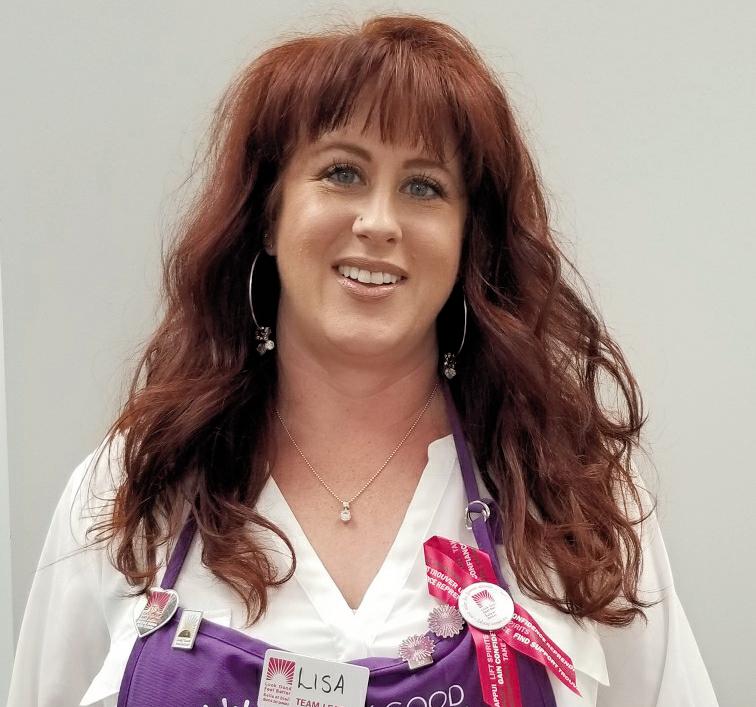
This year, Lisa celebrates 25 years of volunteering with LGFB and being part of a community that offers women supportive care so they can feel like them selves again.
“My own mom went through cancer,” Lisa said. “In Kelowna, we had two Tuesday evening programs and a Wednesday
afternoon program. I went with my mom to an LGFB program that wasn’t my typical Tuesday evening. I was there as her sup port, but also had my apron in case of volunteer shortage. As things would go, I ended up leading the program that night, with my mom on my left!”
Through her years of working with LGFB, Lisa has seen the transformative power of selfcare. True health care treats the whole person—not just
the physical but the emotional and psychological aspects too. Often, the most challenging thing about a cancer diagnosis is not the disease itself but the loss of identity that comes with it. The disease can rob you of your unique identity—instead becoming “the cancer patient.”

LGFB offers complimentary workshops that give Canadian women, teens and most recently men, the tools and techniques to feel beautiful and restore their
sense of self. It’s a method that puts people first and prioritiz es how they feel. At the LGFB workshops, both in-person and online, people with cancer can learn how to manage the appear ance-related impact of cancer and its treatment, led by expert volunteers like Lisa.
“Every workshop I host ends up being one of my favour ites,” said Lisa. “It sounds cli ché, but each and every one of the workshops offers so many
experiences, connections, new understandings, education, sup port, and, as a bonus, a kit of skincare and cosmetics. Seeing and hearing the women con nect is such a gift, as is hearing them say, ‘Oh my goodness, I look like me again!’ Each step of the skincare regime, you see the women light up more, sit a little straighter. Eyes brighten, conversation grows, there’s often laughter and stories shared.”
At LGFB, there is something for everyone. As the seasons change and the weather cools, Lisa reminds us of some mustknow tips for taking care of ourselves, inside and out, this autumn and winter.
“As seasons change, mois turizing our skin and properly hydrating our bodies as the air gets drier can make so much of a difference. And sunscreen is still a must! Also, paying attention to the moments or days that we need to ‘fill our cups,’ whether it’s curling up with a good book, a cup of tea and a blanket, or going out for a walk in the crisp autumn air.”
5"_Oct 2021
Registered charity #13072 4941 RR0001
the power of sight to kids in low-income countries with surgery, glasses, and medicine. When kids can see clearly, they can succeed in school, play with friends and thrive. Give the gift of sight from $25 YVETTE © COURTESY OF SEVA CANADA
Workshops SKINCARE & COSMETICS HAIR ALTERNATIVES BREAST FORMS TEENS MEN for those facing cancer Register for our complimentary workshops at lgfb.ca or by calling 1-800-914-5665 Follow us @LGFBCanada LISA WYNN © IMAGES COURTESY OF LOOK GOOD FEEL BETTER How the Homeless World Cup Has Supported Unhoused Communities Worldwide HOMELESS WORLD CUP CO-FOUNDER MEL YOUNG AT OPENING CEREMONY © ALAYAH QUINN AND MILE44 NOW I CAN WATCH HIM READ WITH CONFIDENCE RRCANADA.ORG The power of positive, solution-based journalism. globalheroes.com ADVERTORIAL ADVERTORIAL November • 2022
Family-Centred Care At BC Family Hearing Resource Society


BC Family Hearing Resource Society (BCFHRS) has a long and rich history of providing a wide range of specialized early intervention services and community capacity-building activities to Deaf and Hard of Hearing (D/HH) children and their families across the provinces of British Columbia, Yukon and Northwest Territories. Services are provided to children and families from birth to school-aged entry. This year marks a milestone as the organization celebrates its 40th Anniversary in service delivery and community engagement.
The approach to services in cludes specific intervention that offers the flexibility of various communication choices. A range of services are offered across the full spectrum of language devel opment, such as visual language (American Sign Language—ASL), spoken language (English), as well as alternative augmentative com munication options.
The organization has Teachers of the Deaf and Hard of Hearing, Speech-Language Pathologists, a Listening and Spoken Language Specialist, Sign Language Instructors, Early Childhood Educators, and Family Support Parents. Some staff are also trained
deaf/hard of hearing role models and personally identify either as Deaf or Hard of Hearing. A combination of a broad range of expertise with specialized knowledge of professionals is used to conduct assessments in two languages (English and ASL), identify goals and strategies, develop Individualized Family Service Plans, and provide individualized intervention based on the needs of the child and family. Families and Deaf and Hard-of-Hearing children receive support for the development of cognitive language and communication intervention services in visual language as well as spoken language.
“I can’t speak enough of the quality of service our family has received. Staff have been com passionate, supportive and our greatest cheerleaders in building our confidence and awareness.”
—BC Family Hearing Resource Society client
The core services provided by BCFHRS include outcome-driv en individualized intervention services tailored to the needs of each D/HH child and their family in a range of different areas that
encompass cognitive receptive and expressive language and global development. The Individualized Family Service Plan forms the central and vital document in the coordination of all services for the child and the family. Various auxiliary services and group pro grams include a new specialized bilingual childcare that opened in September 2021, educational support, training, and workshops offered to children, their families and community service providers. Interventionists establish partner ships with families to enable them to develop competency and con fidence to make the best possible choices for their children.
BCFHRS has been actively involved in educating, training, supporting and sharing resources with many communities across the provinces. Many rural and remote communities also have limited information, expertise and experience with deafness, hearing loss, the range of hearing levels and its impact on language, communication and the overall well-being of the child. The orga nization’s objective is to identify the needs of each community ser vice provider in these areas and strengthen their resource capac ities to achieve self-sufficiency.
BCFHRS has played a leadership role throughout the province of B.C. in building such commu nity capacity. Feedback is sought from families and community service providers, and such feed back is used to improve standards of service delivery and care.
“BCFHRS does an outstanding job. Our collaboration leads to the best possible outcomes for families. We always enjoy work ing with you.”
—BC Family Hearing Resource Society community partner
The children and families that BCFHRS serves come from di verse linguistic and cultural back grounds, including Indigenous families. Understanding families’ values and differences, respecting their diversity and being flexi ble during service provision has been one of their strengths. The BCFHRS’s staff are trained and committed to actively engage with humility and self-reflection, and self-critique as they develop equal partnerships with families to minimize barriers to their child’s success. Staff recognize the sensitive and confidential nature of service provisions and respect
the unique needs of every child and family. Intervention services are individualized and provided by a team of skilled and compe tent professionals who are caring, compassionate and empathetic.



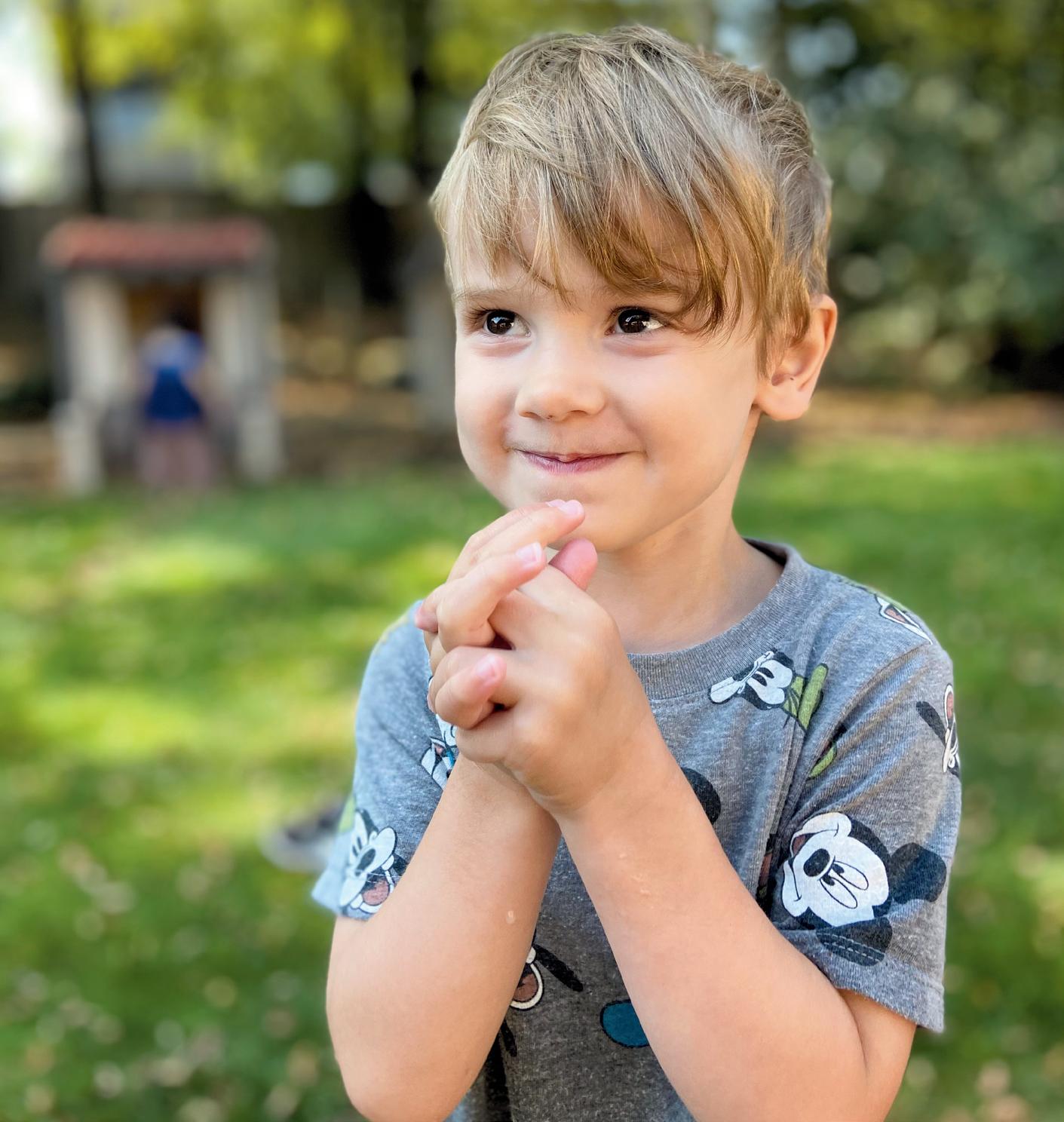
The focus of the organization for the next three years would be on the expansion and im provement of the frequency of individual and group services for Indigenous families, especially from rural and remote communi ties. BCFHRS has partnered with Indigenous leaders and commu nity service providers to tailor and adapt practices to maximize service delivery to families from Indigenous communities. They are in the process of conducting family gathering sessions across B.C., and the Yukon, wherein current and past families come together to share their personal stories and experiences that al low for awareness, learning and growth to build respectful and sensitive relationships for impact ful service delivery.
If you are interested in more information on the programs and services, contact Dr. Noreen Simmons, Executive Director at BCFHRS: nsimmons@ bcfamilyhearing.com or call 604-584-2827 ext. 223
© IMAGES COURTESY OF BCFHRS Donate to BC Family Hearing Resource Society to ensure that every child who is Deaf or Hard-of-Hearing gets the support they need. bcfamilyhearing.com FUTURES BRIGHT 40 YEARS OF MAKING
globalheroes.com ADVERTORIAL November • 2022
Feeding Our Neighbourhoods, From Garden to Table
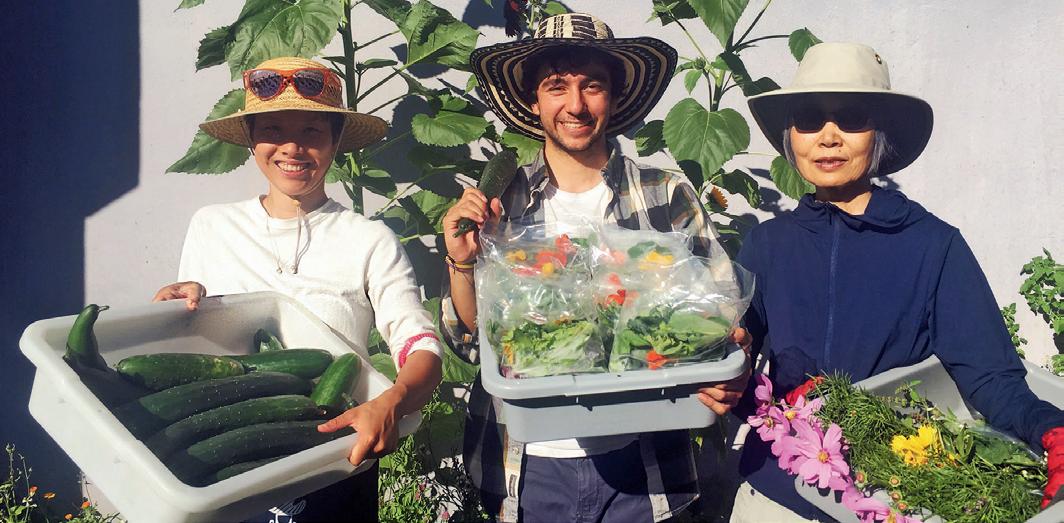
Hundreds of thousands of British Columbians are in the midst of food insecurity. Our neighbours are pulling each other out— through the Association of Neigh bourhood Houses BC (ANHBC).

It’s true that we provide food pantries for immediate support through Frog Hollow, Gordon, Kitsilano, and South Vancouver Neighbourhood Houses. But ar en’t ingredients just the begin ning? Neighbourhood houses follow through on food justice, from garden to table.
We grow gardens together, because everyone has a green thumb. We learn to create nu tritious, satisfying meals together, because a chef is inside us all, longing to nurture our friends and family. And from babies to seniors, we eat together at every one of our eight houses and out door camp, because the steam of a hot meal melds our social fabric together.
Who faces food insecurity? You’d be surprised. In British Columbia, more than one in every ten people you cross paths with is food insecure. • As seniors develop a chang ing palette, lower energy levels,

and disabilities that change the cooking tools they can use, they may struggle to learn accessi ble recipes. They also may not find interest in eating alone. ANHBC neighbourhood houses bring seniors together to make eating accessible and pleasur able again.

• In this province’s housing cri sis, many students pay exploit ative rents and run out of money for food. Since they may move multiple times within a decade, they miss out on the benefits of rent control. ANHBC con nects youth with food, as well as mental health services to mitigate the turbulence that goes handin-hand with their experience of food insecurity.
• British Columbia is current ly welcoming thousands of Ukrainian refugees. They are courageously facing a new con tinent and culture with very lit tle. With so many of ANHBC’s participants being newcomers, we need your support now more than ever to provide familiar, cul turally appropriate food to our new neighbours.

• We operate on the unceded territory of the Musqueam,
Squamish, Semiahmoo, Kwantlen, Tsleil-Waututh, Kwikwetlem, Tsawwassen and Sto:lo Nations, which have long stewarded this territory to produce an abundance of nutritious food. Much of these food systems are being challenged by climate change, poor management of marine resources, development and industry. As part of our commitment to decolonization, ANHBC works with Indigenous partners to share knowledge about local Indigenous Food Systems and what we can do to ensure the health and vitality of this place for generations to come.
A donation today to the Association of Neighbourhood Houses of BC is the best, most immediate way for you to help solve food insecurity for your neighbours. And second—and perhaps most important—your financial support today will fuel our heavy lifting with oth er partners to address the sys temic issue at the heart of food insecurity—poverty.
With your support, we will come out stronger in a chang ing world, with neighbour hoods that are more food secure than ever.
Sean Penn to Receive Television Academy’s Bob Hope Humanitarian Award

The Television Academy
him into their Hall Of Fame.
The academy
honour
Hall Of Fame. The other Hall Of Fame inductees include Fame actress Debbie Allen, documentary filmmaker Ken Burns, former Warner Bros. chairman Bob Daly, BET founder Robert L. Johnson, West Side Story actress Rita Moreno, and cinematographer Donald A. Morgan.
“These legendary perform ers, creators, craftspeople and television executives are luminaries in our industry. Their work has influenced and immeasurably elevated the cur rent television landscape and culture,” Television Academy chairman and CEO Frank Scherma said of the inductees in a statement. “We are proud to induct these trailblazers into the Hall Of Fame and honoured to celebrate their extraordinary contributions to our industry.”
Penn is being recognized for his work through his organization CORE (Community Organized Relief Effort), an emergency response organization that works on the ground to support
communities impacted by climate disasters, war, and poverty. In the last year, CORE has been working on the ground in war-torn Ukraine and its bordering countries, Pakistan, Florida, and much more.
Co-chair of the academy’s Humanitarian Award Selection Committee, Kim Coleman, explained why Penn was cho sen for the Bob Hope Award: “Sean’s activism and immense humanitarian efforts have had a profound impact on the global community, and he has effectively used his platform to motivate change.”
Co-chair Michael Spiller added: “Sean is responsible for getting help to people who need it the most. From Haiti to Ukraine to Los Angeles, he is an inspiration to us all.”
CORE was founded in 2010 after an earthquake rocked Haiti. Frustrated by the search and rescue efforts, he founded CORE within hours of the disaster, which immediately mobilized a powerful network to take action, operating a

55,000-person tent camp for displaced locals.
The organization was founded in partnership with Ann Lee, an activist with a long history of humanitarian efforts.
“We are not saviours,” Lee shared. “We are not coming to help for the glory and recognition, and then leaving once the initial job is completed. We are trusted partners to the community, and that requires close collaboration with community leaders and members to ensure we are addressing their needs.”
Now, more than ten years later, the organization continues to lead sustainable programs focused on four pillars: emergency relief, disaster preparedness, environmental resilience, and community building. The latter has proved a vital lesson, not just for the organization, but for the hardhit communities it helps.
Penn will be given the humanitarian award during a ceremony on November 16.
Bringing Futures Into Focus
Amandah is a girl with big dreams.
“I hope to be a designer when I grow up,” explained the fourth grad er in Uasin Gishu County, Kenya.
Sitting in class, Amandah throws her hand into the air as her teacher asks the class a math question— but it wasn’t always this way.
“Before I got my glasses, I couldn’t see very well from afar, no matter how close I was to the blackboard,” said Amandah.
Last year, Amandah received free prescription eyeglasses through Operation Eyesight’s school eye health program. Launched in 2021, the program screened more than 70,000 children and 1,800 teachers for eye conditions across 209 schools in Uasin Gishu County, located in western Kenya near the Rift Valley.
It’s part of a focus on achieving the UN’s Sustainable Development Goals, including improving access to quality education and achieving gender equality.
Made possible through partnership with Kenya’s national government and Peek Vision, as well as the United States
Agency for International Development’s (USAID’s) Child Blindness Program, 205 students like Amandah received prescription eyeglasses, and more than 1,500 were referred to one of Operation Eyesight’s partner hospitals for advanced care such as cataract surgery.
CARE FOR THE WHOLE COMMUNITY Alice Mwangi, Operation Eyesight’s Country Director for Kenya, said school screening programs impact students’ families and others in their network.
“People often do not seek eye health care—or are simply unable to access it—for a variety of rea sons. We also know that women and girls are more likely to suffer vision impairment and face bar riers to care,” she said.
School eye health programs play an important role in edu cating parents, families and en tire communities about health services in their area.
“Our work in Kenya’s schools connects students and their
families with their local health system. This means children and their families are more likely to access health care, including eye health care, when they need it,” Mwangi said.
She added that the program’s ‘train the trainer’ model equips teachers to identify students with eyesight problems.
“This means that the impact of school eye health programs is sustainable.”
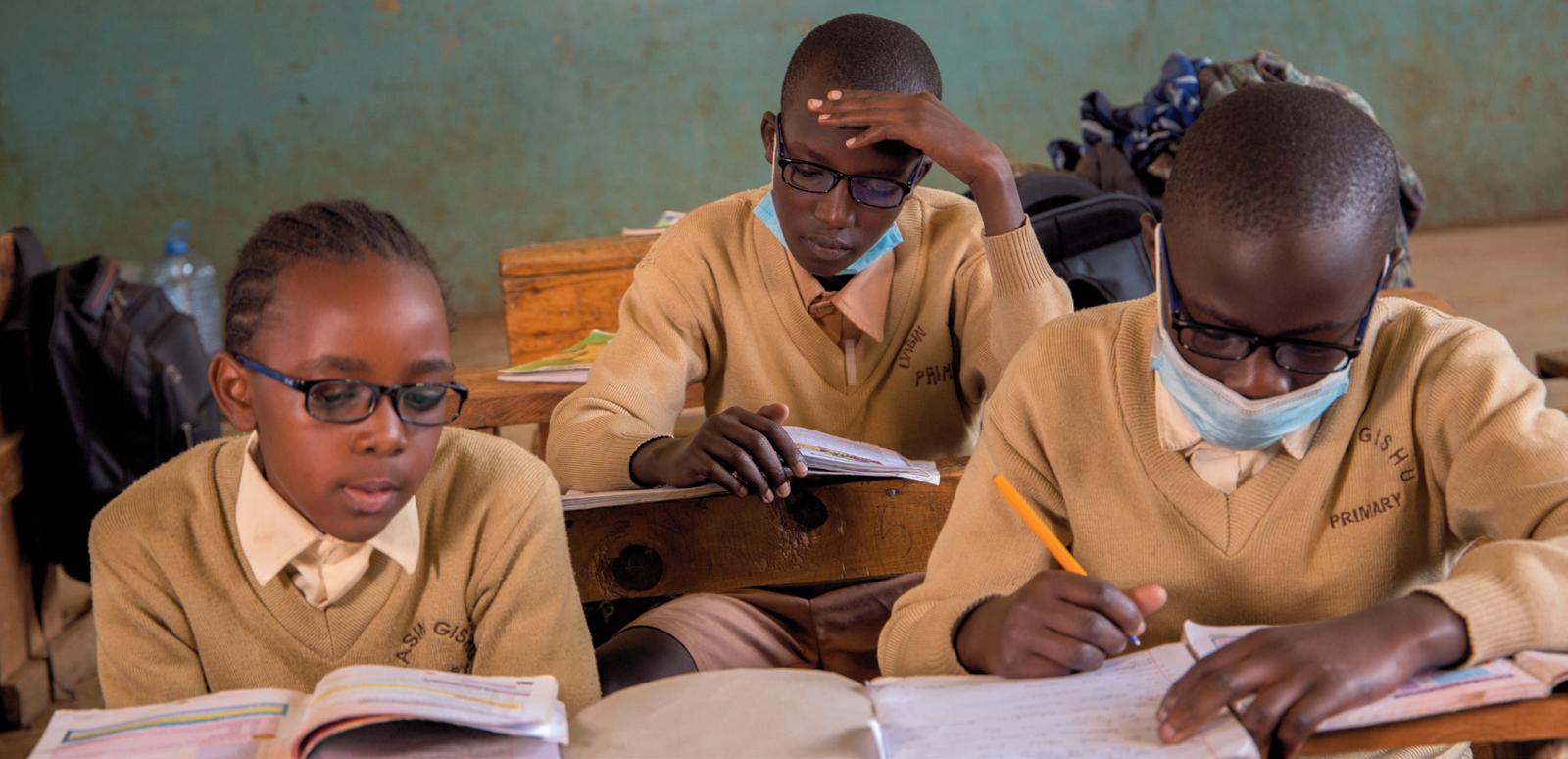
THE FUTURE OF SCHOOL EYE HEALTH SCREENING Across Africa, Operation Eyesight’s
school eye health programs in Ghana, Ethiopia, Kenya and Zambia screened 77,140 students and teachers in 2021.
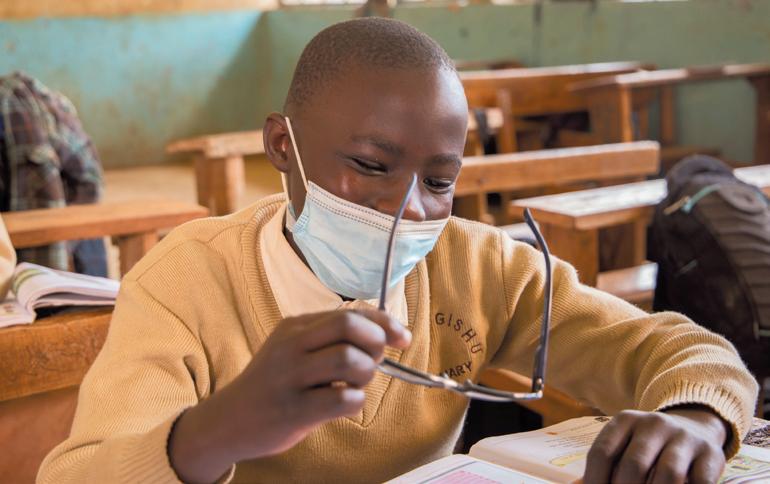
Today, Operation Eyesight is partnering with communities, focused on expanding school eye health programs in Africa and South Asia.
“Through our presence in schools, we are having a tangible impact on health outcomes for entire communities,” said Kashinath Bhoosnurmath, President and CEO of Operation Eyesight.
“That’s because our work goes beyond providing eye health care;
we are empowering women and girls, and supporting gender equality and sustainability in countries where we work.”
With vision loss no longer standing in her way, Amandah is confident her hope of becoming a designer will become a reality.
“I would like to thank the peo ple who gave me the glasses,” she said. “Now that I can read and see well, I hope I will be able to achieve my dream.”
Give today to help bring futures
into focus at operationeyesight.com/give © COURTESY OF OPERATION EYESIGHT AND PEEK VISION HELP PREVENT BLINDNESS AND RESTORE SIGHT Donate today at operationeyesight.com or call 1-800-585-8265 REGISTERED CHARITY # 119068955 RR 0001
To donate, mail this slip or a cheque to: Association of Neighbourhood Houses BC c/o Shirlyn Baskette 203-3102 Main St. Vancouver, BC V5T 3G7 First & Last Name: Address: Email: Phone #: Donation Amount: Credit Card #: Expiry Date: CVV: VISIT US AT ANHBC.ORG OR CALL 604-875-9111 HELP FEED YOUR NEIGHBOURHOOD
will honour double Oscar-winning actor Sean Penn with their Bob Hope Humanitarian Award in a November ceremony, inducting
will
Penn with the award at a ceremony inducting him and five other new members into its
(Source: Reuters)
SEAN
PENN (PICTURED) AND ANN LEE HOST THE 2022 CORE GALA AT THE
HOLLYWOOD
PALLADIUM. © REUTERS/
FAYE`S VISION/COVER
IMAGES/INSTARIMAGES.COM
The power of positive, solution-based journalism.
globalheroes.com ADVERTORIAL ADVERTORIAL November • 2022
Dr. Eitan Prisman: Reimagining the Future of Medical Care
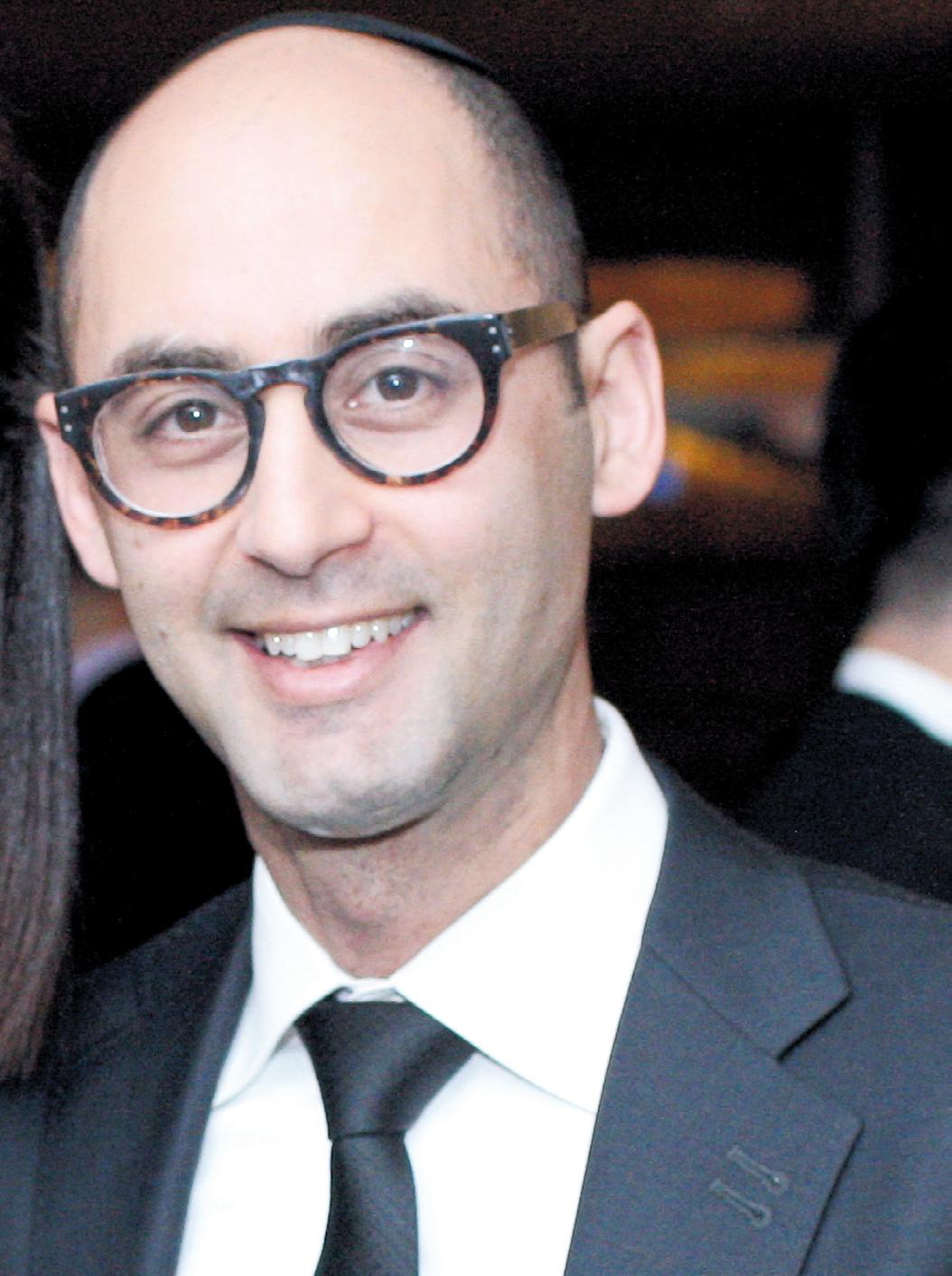
A mother of two noticed pain on her tongue, only to receive the devastating news that she had salivary gland cancer and needed treatment immediately. An engineering student with a toothache has her world turned upside-down when it’s discov ered she has a tumour lining her jawbone, risking deformity and death. A police officer and fitness nut who finds a bump on his neck faces the grim reality of throat cancer.
At Vancouver General Hospital (VGH), these patients have not only survived their complex and challenging medical conditions, they are thriving today. And each of them shared one thing in common: the care of a world-lead ing innovative medical expert, Dr. Eitan Prisman.
PUSHING THE BOUNDARIES OF MEDICINE
Dr. Prisman is a specialist in head and neck cancer and microvas cular reconstruction of the head and neck. His clinical expertise includes oral, larynx, thyroid, salivary gland and cutaneous malignancies. And as much as he is a practicing surgeon, pro viding care first-hand to individ uals suffering from all manner of medical diseases of the head and neck, he is also an innovative re searcher, constantly pushing the boundaries of what is possible in medical care.
Specifically, Dr. Prisman uti lizes groundbreaking technology to create the most efficient and optimal outcomes for his pa tients. He does so by utilizing international training in the use of robotics in procedures such as Trans Oral Robotic Surgery (TORS) and microvascular re constructive surgery.
He compliments these surger ies with other technological ad vancements, including utilizing a 3D printer and a proprietary software he and his team built to run simulations of surgeries in order to find the most effi cient way to approach complex surgeries on real patients. And no one knows that better than Joyce Senorin.
A YOUNG WOMAN’S LIFE—AND FUTURE—

SAVED
“It’s just a toothache.” Or at least that’s what Joyce thought at the time. The pain would come and go, so she wasn’t overly concerned, but Joyce mentioned it to her dentist, who thought it was an infection, and she was eventually referred to an oral surgeon.
Due to the pandemic, Joyce wouldn’t be able to see the spe cialist for almost two years. What she learned turned her world up side-down.
“I had a tumour in my jaw that was growing so aggressively it was ‘eating’ my left jawbone,” Joyce said. “The bone had become so thin that I had to go on a puree diet immediately just to avoid further damage. I was…terrified.”
Joyce was suffering from a rare bone tumour called ameloblastoma. It needed to be removed, or it would soon leave Joyce unable to eat or speak. Without proper care, it could become fatal.
“The more I read about the surgery, more worried I became, because apparently after the sur gery, you might need to rehabili tate your jaw,” Joyce said. “As in, learn how to talk and learn how to chew and learn how to smile again. That scared me. ‘Cause I was just like, what? I’m not going to be able to do something that’s very basic anymore?”
This was when she met Dr. Prisman at VGH, who walked her through precisely what needed to be done to help put her fears at rest.
“This was on the jaw, which would mean it would grow so large it would prevent her possi bly from speaking, eating, and it could deform her face. It’s not a tumour you can live with by any means,” Dr. Prisman said. “Now, Joyce was remarkably healthy with her whole life ahead of her. To me, this meant I wanted to optimize the procedure to reduce any im pact it may have on the rest of her life. One of my areas of passions is to optimize outcomes for patients.”
THE IMPORTANCE OF PLANNING
Dr. Prisman had to do a “full sec tion” removal due to the tumour’s location. This means he had to remove the entire area of the jaw bone and replace it.
“The complexity with the jaw bone is how much we use it every day,” he said. “There’s constant mo tion and pressure. You can’t just throw a titanium plate in because the bone will not fuse properly and then you’re dealing with a whole other problem.”
Instead, Dr. Prisman needed more bone.
“We only have one jawbone, so we took her shoulder bone, spe cifically the scapula,” Dr. Prisman said. “And then we virtually de signed what needed to happen in order to optimize the outcome.”
Using CT scans and model ling of Joyce’s bone structure, Dr. Prisman utilized simulation soft ware he and his team designed. It ran hundreds of virtual surgeries on Joyce before landing on the
most optimal one for Dr. Prisman to perform.
This pre-surgical preparation is key for improving outcomes, as it reduces the amount of time a pa tient is in surgery by hours. This reduces inflammation, soreness, the chance of infection, and increases the likelihood of surgical success.
“Joyce’s surgery went text book,” Dr. Prisman said. “She had zero complications.”
Today, Joyce is happily moving forward in her life. She has a bur geoning business in calligraphy for weddings and events and is even looking to get married herself in the near future.

“I’m so grateful for Dr. Prisman,” she said. “He saved my life.”
Powered by donations, VGH & UBC Hospital Foundation is proud to support the career of Dr. Eitan Prisman. It’s because of individuals like him that VGH can be a world leader in health care, saving and improving lives every day.
PLEASE DONATE TODAY Dedicate your gift to a loved one, caregiver, or member of your health care team. vghfoundation.ca/angel-honour 604 875 4676
Kathy Wong Occupational Therapist at GF Strong
DR. PRISMAN © COURTESY OF VGH & UBC HOSPITAL FOUNDATION JOYCE SENORIN © COURTESY OF VGH & UBC HOSPITAL FOUNDATION globalheroes.com ADVERTORIAL November • 2022
SurreyCares Community Foundation: A Gift Forever for Our Community
Since 1994, SurreyCares Commu nity Foundation has been Surrey’s charity for charities. SurreyCares makes decisions based on our lo cal expertise to grow the not-forprofit sector. As the Community Foundation of the third fast est-growing city in Canada, we continue growing to meet our community’s future needs.
Community foundations help guide volunteer efforts and financial support to where they can make the greatest impact. Community knowledge gives us a deeper understanding of the well-being of our community and fosters collaboration with others. It is at the heart of our work. SurreyCares helps donors make a positive difference in our community, and in the lives of people here.
OUR TOTAL INVESTMENTS HAVE GROWN AND SO HAVE OUR GRANTS THAT SUPPORT IMPORTANT COMMUNITY CAUSES
In 2022, SurreyCares Com munity Foundation granted al most $519,000 to community

organizations delivering a wide range of programs. These grants were made possible by invest ment income. In most cases, the original gifts are invested for longterm growth. Endowment funds create a legacy for lasting impact. In addition to the Community Grants, SurreyCares distributed scholarships, bursaries, and grants to ten charities for whom a des ignated fund was created. Surrey Cares Community Foundation, in partnership with generous donors, also made grants to the City of Surrey for Keery Park enhancements in support of the resurfacing of the South Surrey Athletic Track (Race2Resurface); the Surrey School District in
support of youth and families with disabilities; and a special Youth Philanthropy Initiative grant. In 2022, SurreyCares plans to grant over $800,000 in local dollars and federal programs in partnership with Community Foundations of Canada.

LOOKING BACK
In 1992, a group of community leaders began work on establish ing what is now the SurreyCares Community Foundation. Of ficially established in 1994, in dividuals and corporate donors contributed to the original monies of the Foundation. 1998 saw the creation of the Foundation’s first locally held endowment fund—in
support of community health.
Surrey has Francisca and Edwin Darts to thank for seeding the Foundation’s largest endow ment fund in 2001: creating a legacy to benefit our very own Surrey. Their original endowment of $200,000 now stands at over $4 million. With our steward ship, their legacy will provide an estimated $4 million in invest ment income over the next 25 years, monies that finance capital projects in the garden.
As we approach 30 years, we need your help to keep pace with the needs of our growing community during good times and difficult times.

Now, in 2022, our funds are expanding, and with your help, they will grow more quickly to address pressing needs. Here are three of the many ways you can support through SurreyCares: Food Security—We have seen an increase in the need for food security. It is timely that the new Food for Everyone Fund is estab lished. Proceeds from our second annual Toonies for Tomorrow Campaign in February 2023 are designated for food security.
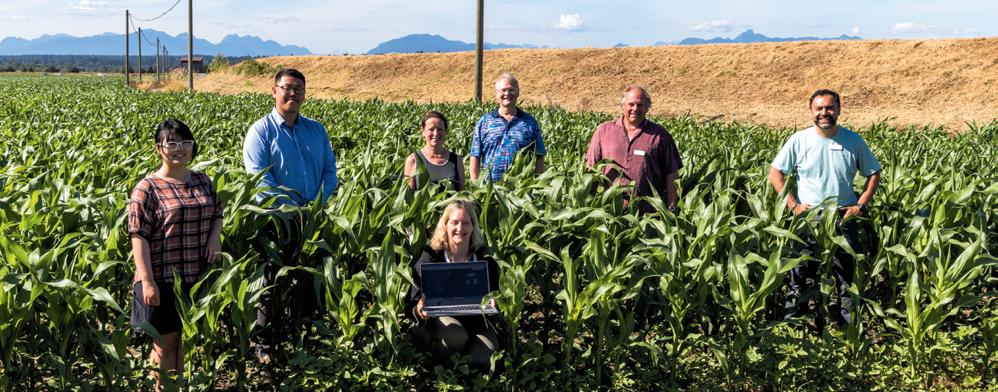
Seniors—Proceeds from this year’s Challenge and Cheers Event for Professional Advisors are to raise dollars for the launch of a Seniors Fund to fill a gap in our community and Women—SurreyCares Com munity Foundation is seeking matching dollars to support our Women’s Equity Fund.
As a medium-sized communi ty foundation serving a large and fast-growing city, we are proud of the impact we have. With the support of the community during these challenging times, we can do even more at a faster pace to support charities that face increased demand for services and increased costs.
Scan the QR code to watch and learn more about our work and how your donations to the fund are spent:
Show that you care by giving to the community where you live, work and play.
I Am Coming to Canada: The Invictus Games’ First-Ever Winter Hybrid Games in Vancouver
ALLIE MURRAY
The Invictus Games are returning to Canada—this time, British Columbia will become the host nation for the first-ever winter hybrid Invictus Games.
The event and namesake foundation was founded in 2014 by Prince Harry, Duke of Sussex, and brings together wounded, injured, and sick servicemen and women for a multi-national sporting event. The event was hosted in Toronto in 2017 and has unified nations in a variety of host cities, including Orlando, London, Sydney, and more.
Earlier this year, Prince Harry announced Vancouver and Whistler would be the host cities for the 2025 games, welcoming more than 500 competitors from 20 different countries.
“I’m excited that Canada will host the 2025 Invictus Games,” Canadian Prime Minister Justin Trudeau said. “Today’s investment will help us welcome competitors from around the world to beautiful
British Columbia to showcase their athleticism, drive, and competitive spirit. Canadians look forward to welcoming you once again.”
Similarly, Lawrence MacAulay, the Minister of Veterans Affairs and Associate Minister of National Defence, shared his excitement, “It is incredibly exciting for Canada to be hosting the 2025 Invictus Games in Vancouver and Whistler. The energy I felt in Vancouver when the Games were announced this spring is only going to build as we get closer to 2025. Canadians and folks right across the world are in for a great show when these world-class athletes compete and showcase their talents at the first ever winter hybrid games.”
The games returning to Canada was made possible with support from the Governments of Canada and British Columbia, alongside bids from True Patriot Love Foundation and the Soldier On program.
“Invictus Games 2025 will provide a platform to once again demonstrate how perseverance,

determination, and unity can inspire, empower, and enable recovery and well-being,” Jay Feyko, National Manager at Soldier On, explained. “It also is an opportunity to reaffirm to ill and injured members of the Canadian Armed Forces, Veterans and those military communities around the world, that they are not alone, and need not to recover alone.”
The 2025 event will also be the first time the Invictus Games will include adaptive winter sports like alpine skiing, Nordic skiing, skeleton, and curling.
Similarly, the event is dedicated to respecting territorial protocols and working with local Indigenous communities in the planning, execution and participation of the games.
“The Invictus Games VancouverWhistler 2025 will offer a global platform to expand the range and profile of winter adaptive sports. With deep respect, I’m also pleased to share that the games in Canada will be held in partnership with
the First Nations, in the spirit of Truth and Reconciliation with Indigenous communities,” Prince Harry said.
After attending the Warrior Games in 2013—an event similar to the Invictus Games for injured active duty and veteran U.S. military service members—Prince Harry saw firsthand how the power of sport could uplift those suffering from injuries and illness. He was inspired by this visit, and the
Invictus Games were born.
The name Invictus means unconquered—it embodies the fighting spirit of wounded, injured and sick service personnel and personifies what these tenacious men and women can achieve post-injury.
“This is the spirit of Invictus,” a competitor on the Romanian team shared. “Never quit. Even if you are down—get up and continue your race.”
Leveraging the Power of Women’s Solidarity
“The Mothers’ Club was aware of my situation, so when CAUSE Canada wanted to know if girls in the community were out of school, the Mothers’ Club told them that I was one of them,” said Mariama.
When Mariama was 14 years old, her mother died, and she had to drop out of school. Mariama laboured on a farm to help grow peanuts, a staple food in Sierra Leone. “There was no one to sup port my education.”
There soon was, though— the community Mothers’ Club. When CAUSE Canada began working with the Mothers’ Club to help them identify and sup port girls to go back to and stay in school, Mariama was quick ly identified as someone the Mothers’ Club could help.
Children out of school, ado lescent pregnancies, and families struggling with little to eat—com munity women’s solidarity groups know what is happening in their community. When you invest in them to help, their impact is sus tainable and empowering—both to them and the people with the greatest needs.
Through Mothers’ Club and other women’s solidarity groups, CAUSE Canada has supported thousands of children to stay in school. In Sierra Leone alone, over 800 adolescent girls on track for child marriage instead went back to school last year.
“While critical supplies such as food distribution are needed in times of acute crisis, longer-term solutions must be found if we are going to solve poverty,” Executive Director Wendy Fehr said. “We need to help people have digni ty and the opportunity to find their way out of poverty so that they can meet their own needs. I love how we work together with communities, and particularly women’s groups, to empower them to identify and solve the problems of poverty.”
Mothers’ Clubs are one example of this approach. Women living in poverty are brought together, trained, and start small economic projects. These projects help them feed their families and send their children to school. Together they also agree on a small amount of funds that they will each contribute
as “interest” on the grant into a savings box. With these funds, they identify children who are out of school and families who need food. They help children and families meet their most critical needs.
CAUSE Canada’s sustainable approach reaches far beyond help ing women meet their own and their communities’ basic needs. It helps women find a voice and in fluence in communities primarily dominated by men’s voices.
“Women rarely have money of their own, and even more rarely do they have funds that they can decide how to spend,” Fehr said. “Gaining access to these types of funds, helps them to join in with the largely male-dominated com munity leadership. These women gain agency and influence in their communities. It is amazing to see women standing up to have their voices heard. They know what theirs and their families’ biggest needs are, so it is wonderful when they have an opportunity to speak about these needs.”
In Sierra Leone, women’s solidarity groups are called Mothers’ Clubs, but CAUSE
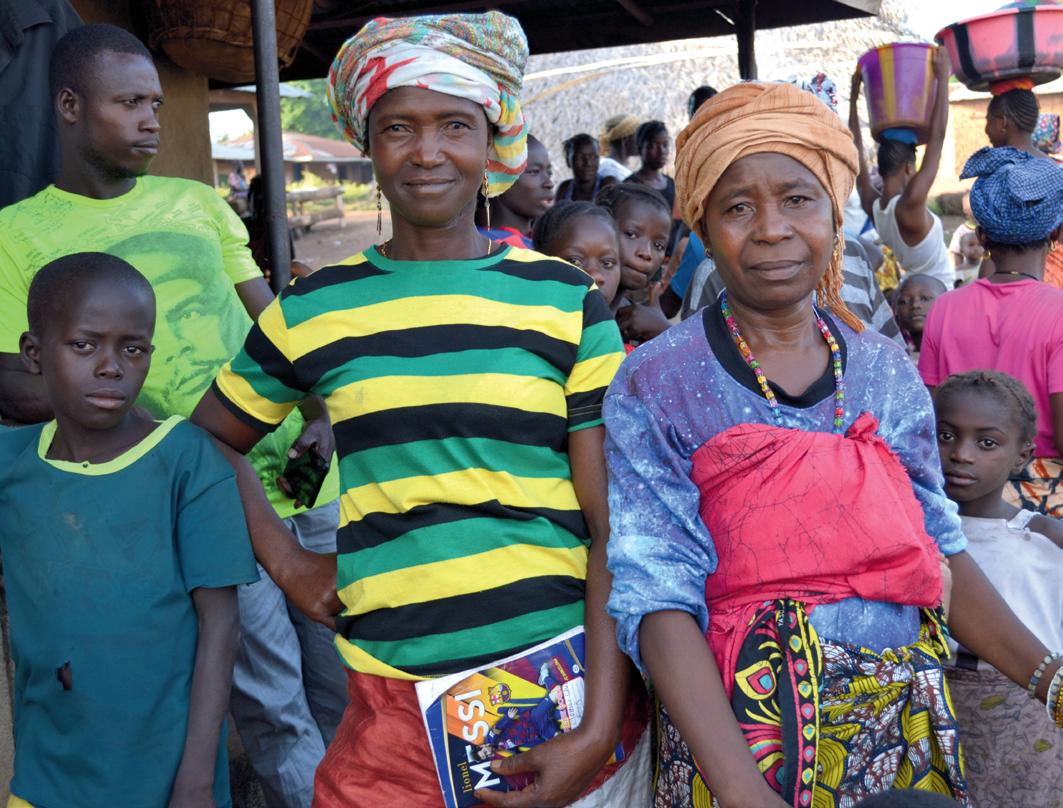
Canada works in West Africa and Central America using this approach. In each country, bringing women to work together must suit their culture and challenges. In Guatemala and Honduras, Women’s Health Committees are solving the crisis of maternal mortality by ensuring that families can access qualified prenatal, postnatal and delivery
care. They identify pregnant girls who would never have care and ensure they have access to medical support.
Women, especially women liv ing in rural poverty in the devel oping world, rarely have a voice, but they know the problems. Sus tainable, effective change happens when we bring these women to gether to be the change.
© COURTESY OF SURREYCARES WE STRIVE TO BUILD A GIVING CONNECTED COMMUNITY
We inspire donors, grow endowments, and invest in people.
www.surreycares.org
© COURTESY OF CAUSE CANADA
BRITAIN’S PRINCE HARRY SHAKES HANDS WITH A BRITISH TEAM MEMBER AFTER THE WHEELCHAIR BASKETBALL FINAL OF THE INVICTUS GAMES IN THE HAGUE, NETHERLANDS © REUTERS/PIROSCHKA VAN DE WOUW
The power of positive, solution-based journalism.
globalheroes.com ADVERTORIAL ADVERTORIAL November • 2022
The Brave Voice of a Child Trafficking Survivor
At 13 years old, Sona was lured away from her rural village in Nepal with the promise of a better opportunity in the city, only to be deceived and sold into sex trafficking in an Indian brothel. She’s not the only one— an estimated 12,000 children are trafficked out of Nepal every year (International Labour Organization, Nepal: trafficking in girls with special reference to prostitution: a rapid assessment). Around the world, millions of people are being abused and exploited by human traffickers. This crime can take on many forms, including, but not limited to, forced labour, sexual exploita tion and domestic servitude. Trafficking affects all regions and countries of the world—includ ing Canada. It can occur within a country or may involve move ment across borders. Increasingly, sexual exploitation is also tak ing place online through social media, gaming, and messaging platforms. According to a recent report from the United Nations Office on Drugs and Crime, one in three victims of human
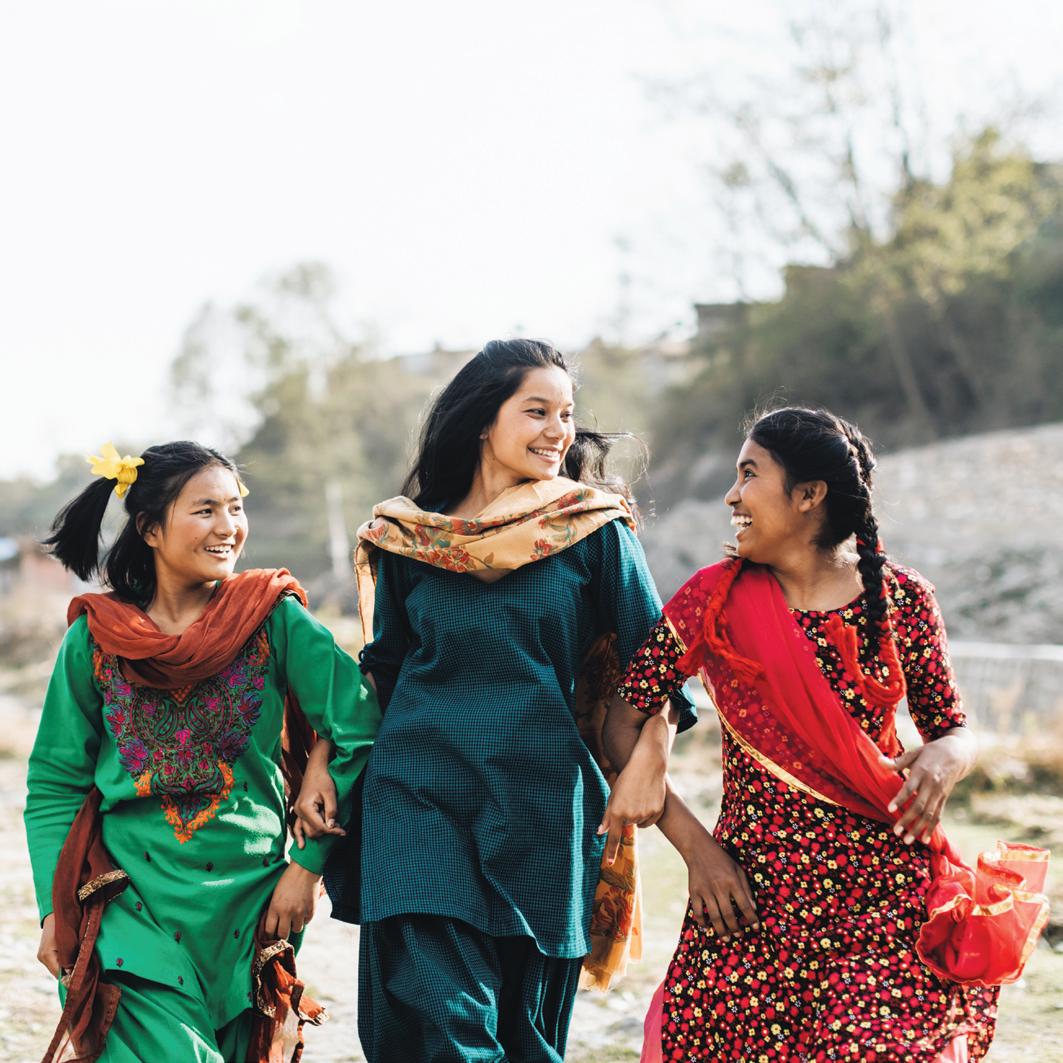
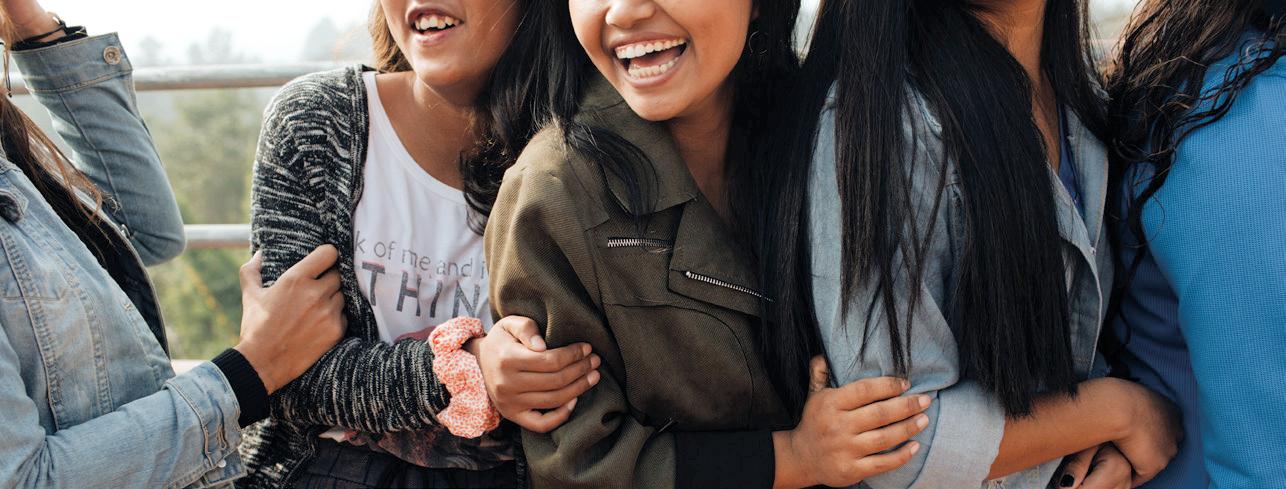
trafficking is a child (UNODC, Global Report on Trafficking in Persons 2020).
Can there be any hope in a situation so dark? Can one voice
make a difference? Sona believes it can. After being trapped in an Indian brothel for three years, Sona was rescued, repatriated to Nepal, and brought to a safe
home where she could begin her healing process.
This happened to be a safe home supported by Ally Global Foundation. This Canadian-based charity helps survivors of human trafficking find healing through safe housing, education and aftercare in Nepal, Cambodia, and Laos. Ally’s programs also include trauma-informed counselling, agricultural projects and job training to help survivors gain independence and reintegrate into society when they are ready.
After spending a decade in the safe home, Sona—now 26 years old—decided it was time to take a stand: “If sharing my story will help other kids find healing like I did, I want to tell it.” Sona teamed up with Ally Global Foundation to turn her story into a short film.
Shooting the film on-location in Nepal over just nine days, a small team of Canadians worked closely with local leaders to tell Sona’s story truthfully and ethi cally while protecting her dignity. The final script was approved by Sona herself (along with local
leadership), and she and local leaders were on set to verify the elements during the production.
Sona’s harrowing experience and subsequent rescue from human trafficking are depicted in The Twelve Thousand (which can be streamed for free at www.thetwelvethousand.com). In this moving retelling of her sto ry, we are forced to come to terms with the reality of modern-day slavery and are also shown the hope that lies on the other side of freedom and healing.
Ally Global Foundation believes that every child deserves safety and freedom. Every child deserves the opportunity to dream and, some day, to train for work they enjoy. A chance to grow in independence, create meaningful relationships and build a life that is truly their own.
You can help children like Sona find hope and healing. Make a donation to Ally Global Foundation at www.ally.org Together, we can prevent human trafficking and help survivors build healthy, independent lives.
Education Cannot Wait Launches Grant to Support Children and Adolescents in Haiti, Working with UNICEF, WFP and Government
KENT PAGE Chief, Advocacy and Communications, Education Cannot Wait
In response to the evolving humanitarian crisis in Haiti, Education Cannot Wait (ECW) announced an $11.8 million USD Multi-Year Resilience Programme that seeks to mobilize an additional $16.2 million to reach more than 45,000 children and adolescents with holistic educational support.
The three-year programme will be delivered by UNICEF and the World Food Programme (WFP) in coordination with the Government of Haiti and local partners. The seedfunding investment builds on ECW’s $1.5 million USD First Emergency Response, bringing total investments in Haiti to $13.3 million USD to date.
“Haiti has suffered multiple crises over the years affecting the children’s and adolescent’s access to a continued and inclusive quality education,” said Yasmine
Sherif, Director of Education Cannot Wait, the United Nations global fund for education in emergencies and protracted crises.
“We cannot stand by. This is our investment to empower them to rebuild their lives and Haiti. With substantive ECW seed-funding mobilized together with our strategic partners, we now call on donors, the private sector and philanthropic foundations to fully fund this innovative multi-year education programme, and make our true commitments at the UN Secretary-General’s Transforming Education Summit last month in New York. This is an opportunity to translate vision into action.”
—Yasmine Sherif
Haiti is one of the least developed countries in the world, ranking 170 out of 189 countries on the 2020 Human Development Index. A history of social and political unrest, chronic poverty, and natural disasters such as the 2010 and
2021 earthquakes—coupled with the ongoing impacts of the climate crisis and COVID-19— are creating significant educational and development obstacles across the country.
While seven out of ten Haitians are able to go to primary school, just 60 per cent have access to preschool and only 15 per cent are able to go on to secondary education. Most of the country’s schools are private, making it even more difficult for poor or displaced families to access learning opportunities for their children. Over half of the country’s schools do not have water or toilets and 75 per cent have no electricity.
“This Multi-Year Resilience Programme supports the major thematic priorities of the national education and training plan 2020-2030,” said Mr. Nesmy Manigat, Minister of Education and Professional Training (MENFP) in Haiti. “Indeed, it supports the Ministry of Education
and Professional Training (MENFP) in providing quality and inclusive education that meets the needs of crisis-affected students. By maintaining the principle that education remains a fundamental and inalienable human right, MENFP wants to guarantee inclusion and equity of access to education for all. We congratulate and thank ECW for providing these funds to strengthen the Haitian education system in vulnerable areas. We encourage technical and financial partners to support the financing of this Multi-Year Resilience Programme by making additional funds available. They will ensure a bright future for the sons and daughters of Haiti.”
The initial seed funding grant will reach more than 20,000 girls and boys across 35 districts, providing a holistic quality education, including mental health and psychosocial support and school meals. The multi-year programme will pay particular attention to gender equality
and disability inclusion and will strengthen the capacity of the national education system to plan, monitor, coordinate, finance, and deliver holistic quality education to better meet the educational needs of crisis-impacted children and adolescents.
With additional funding, the overall programme targets approximately 45,500 children aged three to 18 in all. The programme spans the continuum from early childhood education through to adolescent skills programming and includes adolescent girls’ secondary education as well as nonformal alternative education.
In recognition of the diverse and differentiated needs of all girls and boys, including adolescents and children living with disabilities, the programme is geared towards delivering a holistic, contextualised package of interventions to ensure safe access to quality education and provide for children and adolescents’ physical and mental well-being.
Providing Essential Support and Opportunities in Times of Chaos
While many communities are moving on from the pandemic, in Vancouver’s Downtown Eastside, the impact of the global COVID-19 pandemic is still acutely felt. To make matters worse, this community continues to face multiple crises, including the ongoing opioid crisis, worsening homelessness, and escalating gender-based violence.
Street-based sex workers con tinue to fall through the cracks. That’s why the services available
at the WISH Drop-In Centre Society are so critical. For more than 35 years, WISH has been working to ensure that women and gender-diverse street-based sex workers have the resources and supports needed to make free, healthy, and positive choices.

“It’s often the choice of taking an unsafe date or going home with no money and having to worry about all the things you can’t afford.”
—WISH participant
At a time when many social service agencies were closing their doors, WISH not only remained open, but expanded services to meet the sharp increase in demand. WISH’s Mobile Access Project Van added a second shift, the DropIn expanded operating hours, and WISH opened Canada’s first ever 24/7 shelter for sex workers. These changes helped participants meet their most immediate and urgent needs.
But street-based sex workers rely
on WISH for much more than just the urgent. Staff have become par ticipants’ primary help navigating through increasingly complicated matters—dealing with hundreds of requests for support every week.
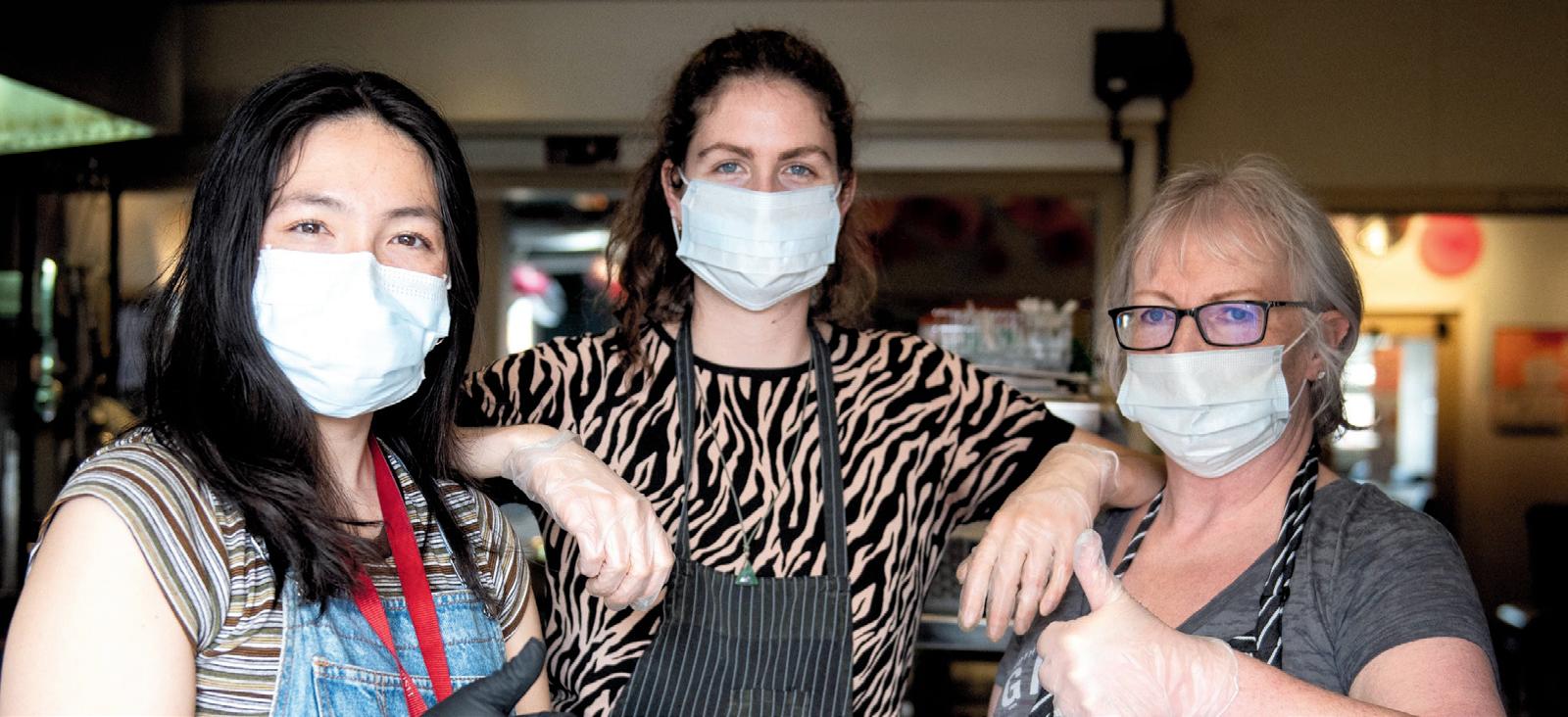
Each day and night, approx imately 350 women and gen der-diverse folks come to WISH for support and services.
Many of those who walk through the doors have experienced target ed, gender-based, and sexualized violence due to the criminalized nature of Canada’s “prostitution” laws. They have physical and men tal health issues related to violence, chronic trauma, and other effects of homelessness and poverty. As a result, they face significant discrim ination and are hesitant to engage with the support services they need.
“We just want to live our lives. We just want to raise our children, we just want to be happy, healthy, productive people but how do you do that?”
—WISH participant
Being able to get one-to-one, longer-term support is vital to participants’ ability to make free
choices and have stability in their lives. This support is provided by WISH’s Inreach team (which includes a dedicated Housing Worker), Indigenous Health and Safety Program, Music Therapy, and Supportive Employment Program.
DID YOU KNOW...
• More than 70 per cent of those who come to WISH live with disabilities • 80 per cent are unhoused or precariously housed • 90 per cent struggle with mental health and/or substance use issues
• All face stigma and discrimination when trying to access services
• Street-based sex workers are seven times more likely to face a violent death
As the Downtown Eastside continues to grapple with multi ple crises, your support is crucial in ensuring sex workers do not face a reduction in services. WISH’s largest fundraising campaign of the year is launching this Giving Tuesday on Nov. 29th. Can they count on your support?
© WENDY D. PHOTOGRAPHY This Giving Tuesday you can give someone the gift of choice. Scan to Donate! Visit wish-vancouver.net for more information.
© COURTESY
OF
ALLY GLOBAL FOUNDATION
The power of positive, solution-based journalism.
globalheroes.com ADVERTORIAL ADVERTORIAL November • 2022
B.C. Charity Helps Youth Get in the Driver’s Seat and on to an Empowered Future
Getting your driver’s licence is an exciting milestone in a young person’s life, providing new free doms and a sense of self-reliance. For the fortunate, who have the necessary supports in place, it is a rewarding rite of passage on the road to adulthood.

But what happens when a young person does not have the resources or support to learn, practice and gain the techni cal skills required to pass their driver’s test?
The Construction Foundation’s SHIFT Driver Training Fund aims to reduce barriers for youth looking to successfully train for and obtain their driver’s licence.

The SHIFT Fund is pleased to of fer Driver’s Licence training grants for youth in care, who have tran sitioned from care or are classified as at risk, allowing youth to gain access to ICBC-recognized driv er training. Since its launch, the Fund has awarded over $100,000 in grants to support young people as they begin to prepare for life after school.
A., a recent SHIFT Driver Training Fund recipient, had been in care since the age of 16 and described the driver training grant as life-changing. A. spoke about the excitement of having
an instructor with her to cele brate passing her novice test on the first try. “She told me she was proud of me,” shared A. “I didn’t realize how rewarding this experience would be for me.”
The benefit of a driver’s li cence to a young person who only has themselves to rely on can be immense. Having a driver’s license means having the independence to get around and do what they need to do without depending on anyone else, and that feeling is transformative.
From tasks as small as grocery shopping to getting to and from work, having a licence to drive can significantly impact some one’s life.
In addition, safety is a key con cern for a young person. Finding a trustworthy adult to provide effective driving lessons can be difficult if you are on your own.
On top of that, being able to drive instead of relying on public transit, rides from friends or co workers, or walking, can provide a feeling of safety and self-reli ance. As a young woman living alone, A. echoed this, sharing that being able to drive herself home after a shift at work has dramatically impacted her sense of personal safety.
A driver’s licence provides confidence and freedom, inde pendence, and safety. For young people who are on their own, a driver’s licence can open new doors to becoming self-suffi cient, providing for themselves when needed.
Our SHIFT Driver Training Fund is actively raising funds to support more young people across British Columbia. We in vite everyone to consider add ing the SHIFT Driver Training Fund to their giving lists this year to help us reduce barriers and connect youth at risk with the tools and training needed to succeed in life.
Help put young people in the driver’s seat at canadahelps. org/en/dn/35760 and apply for funding at constructionfounda tion.ca/the-shift-training-fund
The Construction Foundation is a registered Canadian charity that helps new entrants and un derserved segments of the work force build solid foundations for empowered futures.
How Communities Can Come Together
In communities across Canada, people and organizations are raising awareness of the contributions of those who’ve served in Canada’s armed forces. These are acts like delivering humanitarian aid after Haiti’s devastating earthquake; serving in Panjway, Afghanistan; rescuing people stranded by floods or ice storms; or stepping in at long-term care homes during COVID-19. Often, communities raise awareness by creating memorials and monuments and holding commemorative events. These activities honour the accomplishments and sacrifice of local people who have served the country in uniform. Commemorative activities also help bring communities together by uniting neighbours.
These types of projects even could qualify for financial support from a federal funding program designed to help communities commemorate members and veterans of the Canadian Armed Forces.
Veterans Affairs Canada’s Commemorative Partnership
Program supports organizations undertaking remembrance activities. These can include the construction, restoration or expansion of a community war memorial, an exhibit, learning materials or commemorative events. Past projects that have qualified include a series of concerts to honour those who served in the Korean War, as well as exhibits showcasing the service of Indigenous veterans and the contributions of veterans during times of conflict.

Similarly, Veterans Affairs
Canada is supporting veterans facing homelessness through a variety of programs. Staff across the country are focusing outreach efforts to support and engage homeless veterans and those at risk of homelessness.
“The State of Homelessness in Canada 2013” study reported that at least 200,000 Canadians experience homelessness each year, and of that number, approximately four per cent are veterans.
In 2011, veteran homelessness expert Cheryl Fornchuk conducted a study, which
suggested that the difficulty in transitioning to civilian life after returning from service was one of the most common reasons for homelessness among veterans.
“The transition [from military to civilian life] is like being on Mars and coming back to Earth,” a veteran from the study shared.
To alleviate these issues, Veterans Affairs Canada is working with veterans groups and orchestrating their own programs. They offer services such as veterans emergency fund, health care, mental health
services and support, financial support, employment support, case management, and more.
As the homelessness crisis continues to rise among veterans, more organizations are stepping up to support them. In addition to Veterans Affairs Canada, the Royal Canadian Legion has launched financial programs, partnered with other organizations, and launched an action plan to prevent and eradicate veterans’ homelessness.
Their programs include financial assistance, along with working closely with Veterans Affairs Canada to find shelters and housing. Similarly, the Legion launched a national homeless Veterans program called Leave the Streets Behind. The program operates in Ontario, British Columbia, Yukon, Alberta, Northwest Territories, Saskatchewan, Nova Scotia, Nunavut, and New Brunswick Commands.
“I came into the shelter for a shower and came out with a life,” an anonymous Veteran shared with the Legion.
(Source: NewsCanada)
Theatre for All, in Person and at Home
Celebrating 20 years, Ballet Victoria is an established pro fessional boutique ballet com pany with 12 dancers and four yearly productions, located on the Coast Salish Territory of the Lkwungen and Wsanec peoples in Victoria, B.C. Our perfor mances are dramatic, technically demanding, and often laced with humour: The art of ballet with a 21st-century flair and relevance.
Having produced close to 100 new works, Ballet Victoria’s artistic team is constantly exploring new grounds, from creating new classical full-length narrative works to short, more abstract pieces. We see dance as a global language that unites all people and all communities. We promote inclusion through our productions by juxtaposing culturally universal themes, various dance styles and music genres into an original choreographic narrative. Don’t be surprised to experience Mozart with some rock or even an opera classic with a hip-hop twist! No matter the unexpected combination of music, the harmonious result drives an uncompromising
range of movements and original thematic developments. Our ballets create an unforgettable emotional experience for our audiences, often becoming treasured memories. Of course, Ballet Victoria’s talented and culturally diverse artists contribute immensely to the company’s success, garnering national and international accolades at home in Canada and on tour in the U.S. and Mexico.
More importantly, Ballet Victoria is very fond of its com munity, and we have a unique “Tea for Tutu” program that of fers free performances to anyone who may not be able to go to the theatre due to physical or finan cial barriers. Our venue is fully accessible and fully equipped for a complete and intimate ex perience. These chamber ballet performances include a tea where the audience and artists mingle after the show. This worthwhile program has been top-rated and greatly appreciated, particularly by seniors who could not attend theatre performances anymore.
When the pandemic prompted Ballet Victoria to switch from live


a greater audience, particularly people who may not be able to attend a traditional theatre venue for any reason, such as people living in remote communities or bedridden. As we returned to mainstage theatre performances, Ballet Victoria decided to continue offering digital dissemination and further develop it to make it accessible to as many people as possible. We want to share our artistic creations and passion with you, and it is easy! Simply go to our website: www.balletvictoria.ca, go to BVideo, sign up, and we will email you Vimeo links to our latest productions for you to enjoy at your convenience. The best part is it is free!
Dance, a non-verbal art form, has been part of the human heri tage since the dawn of time. Our works are truly accessible to one and all no matter the age, the culture, the language, and more. Our shows are entertaining, hold great artistic depth and satisfy both those who discover ballet and the expert aficionado. We are looking forward to sharing our art with you.
© COURTESY OF THE CONSTRUCTION FOUNDATION OF BRITISH COLUMBIA
shows to digital dissemination, we decided to share our work for free with the community in the hope of bringing some solace through our art form. We did not expect such a positive response and support. We discovered
an appetite for our offering that went beyond our little community. The dancers were overwhelmed with gratitude for the appreciation and validation they experienced. Ballet Victoria saw a clear opportunity to reach
© COURTESY OF BALLET VICTORIA
© NEWSCANADA/APPLEADSTUDIO The power of positive, solution-based journalism. globalheroes.com ADVERTORIAL ADVERTORIAL November • 2022
SUPPORT A FAMILY IN NEED THIS HOLIDAY SEASON
Neighbours United: Growing a Healthy Community

Everyone deserves to eat a healthy, balanced diet, but the lack of equal access makes it difficult for vulnerable families and seniors.
Neighbours United, a nonprofit community-driven orga nization, is working to change that, one bag of fresh food at a time. We’re connecting families and seniors in need in the small towns and rural communities of the West Kootenays with farm fresh local, organic food once a week to help ensure those who need it most have access to healthy food. According to a 2021 report, nine communi ties in the West Kootenay have more low-income persons than the provincial average.
We’re neighbours looking out for our neighbours so that families and seniors in need can access delicious, nutritious and fresh food. In just over two years, Neighbours United has delivered more than 4,000 bags of fresh food and expanded to support more than 260 people in need.
We now deliver to 75 homes
each week, bringing fresh, healthy food to the tables of families and seniors in Balfour, Nelson, Castlegar, Rossland, Warfield, Trail, Fruitvale, Monstrose, Salmo, and rural communities in between.
“I have been able to create new things out of fresh and healthy foods PLUS my little guy is slowly warming up to veggies because of this. It’s helped him realize where things come from and that veggies can actually taste good. With a bag full of fun new surprises at our door it’s become an adventure to try new things. He’s learning different ways to cook. We are very grateful for this opportunity.”
—Christa, Farms to Friends Recipient
Farms to Friends is commit ted to supporting the local com munity, families, seniors and kids. We are relaunching the program this holiday season, and we’re counting on YOU to help us make sure that every child supported by this program
gets healthy, fresh, local pro duce, this holiday season and into 2023.
We know that 85 families in need are still looking forward
to receiving a bag of fresh, local produce, and we are determined to re-introduce the Farms to Friends program for the benefit of West Kootenays and beyond.

Having invested over $200,000 in the community’s well-being, we are counting on your support to help us meet our goal, and even exceed it, to respond to increased demand for fresh local food and make it accessible to the most vulnerable communities.
This holiday season, let’s give back to our community and help families and seniors in need.
Your support will make a mas sive difference to those who rely on us, and your generosity will help us to propel the program to new horizons. Philanthropy has a beautiful butterfly effect— help us celebrate the relaunch of Farms to Friends this holiday season and provide much-need ed resources for our joint suc cess. A small donation of $55 can provide a family in need with a bag of fresh, local pro duce. Please help us reach our $25,000 goal to provide families and seniors in need with a bag of fresh food for the holidays and into the new year.
Donate today at neighboursunited.org

Women Around The World Stand in Solidarity with Iranian Women
In recent weeks, protesters in Iran—and subsequently all over the world—have been cutting off a lock of hair to protest the death of 22-year-old Mahsa Amini in September.
Actresses, politicians, and foreign ministers are among groups of women who have been protesting on wide scales,
urging the world to step up in solidarity with Iranian women.
SWEDISH MEP CUTS HAIR DURING SPEECH IN SOLIDARITY WITH IRANIAN WOMEN

A Swedish member of the European Parliament lopped off her hair during a speech in the EU assembly in solidarity with anti-government demonstrations in Iran ignited by the death in morality police custody of 22-year-old Mahsa Amini.
“Until Iran is free, our fury will be bigger than the oppressors. Until the women of Iran are free we are going to stand with you,” Iraqi-born Abir Al-Sahlani said in the parliament in Strasbourg, France.
Then, taking a pair of scissors, she said “Jin, Jiyan, Azadi”— Kurdish for “Woman, Life, Freedom”—as she snipped off her ponytail.
Leading French actresses including Juliette Binoche and Isabelle Huppert have also cut locks of hair in protest over Amini’s death after she was arrested in Tehran on Sept. 13
for “inappropriate attire.”
Iran’s clerical rulers have been grappling with the biggest nationwide unrest in years since her death and protests have spread abroad including London, Paris, Rome and Madrid in solidarity with Iranian demonstrators.
MARION COTILLARD AND JULIETTE BINOCHE CUT HAIR IN SOLIDARITY WITH IRANIAN PROTESTERS
Marion Cotillard and Juliette Binoche have shown solidarity with Iranian protesters by filming themselves cutting off pieces of their hair.
The Oscar-winning actresses joined the movement by appearing in a video that was released via the Instagram account @soutienfemmesiran, which translates to “support women in Iran.”
The video opens with Binoche grabbing a large, thick chunk of her hair above her head and saying “for freedom” as she hacks through her locks with scissors and brandishes the hair
in front of the camera. The montage then cuts to Inception star Marion making the front section of her hair much shorter than the rest.
The clip also features appearances from Isabelle Huppert, Charlotte Rampling, and Charlotte Gainsbourg— who is seen cutting a lock of her mother Jane Birkin’s hair before doing her own.
Cotillard shared the video on her own Instagram account with the caption, “For the courageous women and men of Iran who are changing the world at this very moment, fighting for freedom. We stand by you.”
Meanwhile, Binoche wrote on her page, “In SOLIDARITY for FREEDOM RIGHTS for IRANIAN WOMEN and MEN.”

BELGIAN FOREIGN MINISTER CUTS HAIR IN PARLIAMENT IN SUPPORT OF IRANIAN WOMEN Belgium’s foreign minister and two other lawmakers cut their hair in parliament. Hadja Lahbib
snipped off a lock of her hair, following the example of deputy Darya Safai.
Iranian-born Safai had taken scissors to hers—to applause from other lawmakers—after asking the minister about Belgium’s response to a crackdown on widespread protests inside Iran.
A third lawmaker, Goedele Liekens, also cut her hair.
Lahbib, born in Belgium to Algerian parents, told parliament that her government would ask the European Union to impose sanctions against architects of the crackdown when the bloc’s foreign ministers meet.
Iran’s clerical rulers have been battling to contain the most widespread unrest in years since Amini’s death, and protests have spread to many major cities abroad including London, Paris, Rome and Madrid.
A Swedish member of the European Parliament, Abir AlSahlani, also cut off part of her hair during a speech in the EU assembly.
Putting Ecosystem Health on the Front Burner
Tens of thousands of dead wild salmon, drought conditions in fall, heat domes in summer, close to 2,000 species and ecosystems at risk or of special concern—there is little doubt that British Columbia is facing both a biodiversity and climate crisis. Unfortunately, these are crises our current laws are not well equipped to handle. In fact, according to environmental law yers at West Coast Environmental Law, outdated provincial laws cen tred on resource extraction are a root cause of the problem.
An independent review panel appointed by B.C.’s provincial government recently reached a similar conclusion. Nothing less than a “paradigm shift” is required, states the 2020 Old Growth Strategic Review Panel report, which recommended that the provincial government enact legislation that establishes conservation of biodiversity and ecosystem health as an overarching priority for all sectors.
As one of Canada’s oldest en vironmental law organizations, West Coast Environmental Law has worked with communities,

non-governmental organizations, the private sector, and all levels of government to shape B.C. and Canada’s most significant environ mental laws for close to 50 years.
Environmental lawyers say that a new B.C. law for biodiversity and ecosystem health could give species and ecosystems a fighting chance to adapt to the detrimental impacts of climate change and turn the tide on decades of harmful cumulative impacts. Caring for ecosystems benefits humans, too, by preserving critical ecosystem “life-support” services such as carbon storage, clean air and water, food security, and mitigation of floods and landslide risks.

A biodiversity and ecosystem health law, co-developed with First Nations, could contribute to restoring healthy relationships between humans and the natural world, grounded in recognition of Indigenous title, rights and under standings of human relationships with the environment.
Forestry, agriculture, energy, community development and other activities would be pursued in a manner that aligns with the
healthy functioning of natural systems and conservation of bio diversity, rather than working at cross-purposes with these systems. Activities where the ecological con sequences are too high would be avoided, while investment and hu man effort would be concentrated in activities that are consistent with maintaining healthy ecosystems and living within nature’s limits.
Embracing integrated rather than fragmented decision-mak ing, and prioritizing biodiversity and ecosystem health, holds the promise of empowered commu nities, greater local control of decisions, reduced infrastruc ture and emergency-manage ment costs, and more resilient local economies.
The B.C. government com mitted to implement all of the recommendations of the Strategic Review Panel report, but two years later, no process has been announced for developing the new biodiversity law.
West Coast Environmental Law has a unique approach that uses hard-hitting and in-depth legal research and analysis to
engage communities, catalyze coalitions, mobilize allies, and influence decision-makers to implement environmental law reform. As a non-profit working in the public interest, West Coast has a track record of working with Indigenous, federal, provincial and local governments
to shape innovative and proactive legal solutions for environmental protection. West Coast depends on the generosity of donors in this critical work transform the legal landscape for sustainability, democracy and justice. Visit wcel.org to learn how you can be a part of it.
© COURTESY OF NEIGHBOURS UNITED
DONATE AT NEIGHBOURSUNITED.ORG/CAMPAIGN/FARMS-TO-FRIENDS
(Source: Reuters)
SWEDISH LAWMAKER ABIR AL-SAHLANI CUTS HER HAIR AS SHE DELIVERS A SPEECH DURING EU DEBATE ON IRAN PROTESTS © EUROPEAN UNION/HANDOUT VIA REUTERS
DONATE NOW HUMMINGBIRD / PETE NUIJ VIA UNSPLASH The power of positive, solution-based journalism. globalheroes.com ADVERTORIAL ADVERTORIAL November • 2022
Find Your Centre in New West
Riverside restaurants, museums and shops. Just a short 20-minute SkyTrain ride from downtown, right in the middle of Metro Vancouver.
Plan your visit at tourismnewwestminster.com
RESPONSIBLE TRAVELLER
Find Your Centre in New Westminster
What centres you? Is it being in nature, breathing in the crisp, clean air? Is it spending time with friends and family or ex periencing exciting food and culinary delights?
As life changes, we all too often move away from our centres. We move to new cit ies, take on new opportunities, and meet new people—all great things that make life exciting. But every now and then, it can be extraordinarily refresh ing to rediscover the parts of life that make you feel most like yourself.
Whether you’re planning your next getaway or looking for in spiration, New Westminster, situated in the heart of Metro Vancouver, is the perfect place to find your centre.
MEET ME IN NEW WEST
Centrally located and surrounded by Skytrain stops and neighbouring towns like Richmond, Burnaby, Coquitlam, and Surrey, New Westminster is the place to reconnect with family and friends. As the oldest


city in western Canada, New Westminster has adventures around every corner. Discover unique shops and attractions, sample authentic cuisines and explore vibrant outdoor spaces in British Columbia’s historic first capital and enjoy a stay at the Inn at The Quay Hotel. What better way to find what centres you than by exploring the city with the people who make you feel your best?
Catch a show at one of the
city’s many theatres, embrace your creative spirit with a tour of the New Media Gallery, full of groundbreaking contempo rary art, and dive into a world of learning at the Fraser River Discovery Centre.
After a day of exploring every thing the city has to offer, wind down by immersing yourself in nature. British Columbia is best known for its variety of outdoor activities, and New Westminster is no exception. New Westminster
has an abundance of green, from parks to biking and hiking trails, to riverboat tours. With over six acres of outdoor space, Port Royal Park is the perfect spot to find your centre in nature.
The spectacular Port Royal Riverfront Walk provides accessible trails, views, interpretive signs, native plantings, a sand beach and a lookout onto Poplar Island. The Paddlewheeler Riverboat offers scenic river cruises along the mighty Fraser River, with unique offerings for sunset dinner cruises, and celebrations like Valentine’s Day, New Year’s Eve, and more.
If culinary experiences make your heart sing, New Westminster is the place to be. You’ll find delightful offerings from every corner of the world, plus a host of bars and venues for unlimited fun. Located in the heart of New Westminster, River Market is a culinary destination for everyday foodies. From specialty foods to exciting food festivals and even an independent grocery store focusing on organic goods, River Market is a creative
hub where you can shop, eat, and play.
“After everything that has trans pired these past two years, there is a pent-up energy for folks to re connect with their family, friends and everything that brings them balance. New Westminster pro vides the ideal central place to meet, eat and stay. Whether it’s the Fraser River, Highway 1 or the Skytrain, all routes come through New Westminster”
—Mun Bagri, Executive Director, Tourism New West
From art exhibits and comedy shows to music festivals and food trucks, there’s always something exciting happening in New West! Perhaps best of all, you’ll expe rience a welcoming community focused on promoting accessi bility. The atmosphere speaks for itself—everyone is welcome in New West.
Rediscover what centres you. Plan your trip to New Westminster today at tourismnewwestminster.com
Félicité Island, Seychelles: Where Luxury and Conservation Meet

 ALLIE MURRAY
ALLIE MURRAY
Every year in October, Hawksbill turtles begin nesting along the shores of Seychelles, bringing tourists and conservationists alike to Six Senses Zil Pasyon to witness the phenomenon firsthand.
At Six Senses Zil Pasyon, guests can not only marvel at the natural wildlife but also enjoy scenic views, tropical weather, and sustainability initiatives that give back to the planet.

The luxury resort has put a focus on sustainability and conservation, partnering with the Olive Ridley Project—a
charity dedicated to protecting sea turtles and their habitats—to support sea turtle conservation in Seychelles. The partnership allows them to focus on research, education, and outreach for turtle populations in Seychelles.
“Sea turtles are a big part of the natural ecosystem in Seychelles, and considering that Seychelles holds some of the largest Hawksbill turtle populations worldwide, a thorough conservation program is crucial to have,” Six Senses Zil Pasyon general manager Tim Bilfinger explained.
Habitat conservation has long been a focus for Six Senses Zil Pasyon—so much so that when the resort was built some six years ago, the landscaping concept focused on habitat restoration. The environment at the resort uses only plants, shrubs and trees that are indigenous to Seychelles.
“Every aspect of the resort is designed to work in harmony with the environment,” marketing communications manager Lina Suryati explained. “Our sensitive architecture is matched by intelligent ecological practices, committed to preserving and
nurturing our tropical home.”
Through their projects, Six Senses Zil Pasyon has been able to eliminate more than 119,000 plastic bottles, hatch 367 critically endangered Hawksbill turtles in the 2021/2022 season, and protect 15,000 square metres of native trees.
While visiting Seychelles, Six Senses Zil Pasyon makes for the perfect place to relax. The resort takes up only one-third of the island’s mass so as not to disrupt the natural landscapes.
The resort hosts 30 villas plus three private residences, which are designed to be advantageous

for seclusion, incorporating surrounding tropical foliage and beautiful vistas along the shores of the Indian Ocean. The villas include infinity pools, panoramic views of the ocean, and lush tropical vegetation.
Going forward, Six Senses Zil Pasyon is focusing on a variety of conservation projects, including continuing their work with Olive Ridley Project, reforestation of Félicité by planting indigenous species back on the island, partnerships with local schools to assist in sustainability and conservation education, and more.
Visitors Flocking to See Princeton, the Bronze Sculpture Capital of Canada
The Bronze Sculpture Capital of Canada has become a golden attraction.
Three years ago, the Princeton city council approved the production of more than a dozen bronze sculptures as part of its revitalization plan. Now, they are proving to be quite the attraction for the community that used to be a quick stop on the trip to Vancouver. Today it is a popular day trip for those seeking something different.
“Our visitor numbers are going up because people are coming here just to do the sculpture walk,” Princeton economic development and tourism director Gary Schatz said. “It’s our number one reason why people come into the visitor centre.”
By the end of July, the number of tourists to Princeton represented a 30 per cent increase over any other year. It has already had more outof-town visitors than it had in
the last two pandemic-affected years combined.
There are now 16 sculptures throughout the downtown area, and more are on the way, including a mountain goat, a golden eagle and five bear cubs. The art pieces reflect the history, wilderness and wildlife that make Princeton unique. Schatz said the goal is to add a sculpture every year.
“Every animal we have is in this region of British Columbia,” he said, “so we’ve still got plenty of animals to add.”
Visitors to Princeton can do a walking tour of the bronze sculpture loop, which is about a kilometre long and flat. That makes it an accessible attraction for everyone.
“It’s a unique thing,” Schatz said. “We have a couple outside
of our office here, and every day I see people with our bro chure...posing with a statue, taking a picture.”
And which sculptures are ev eryone’s favourite? Well, it de pends on whom you ask.
“I hear lots of different ones,” Schatz said. “Our German tourists probably like the bears the best. The bears are big in Germany. A lot of people like
the moose in front of the visi tor centre. Same with the elk at one of our other gateways. When you ask people, you get a whole mix of opinions.”
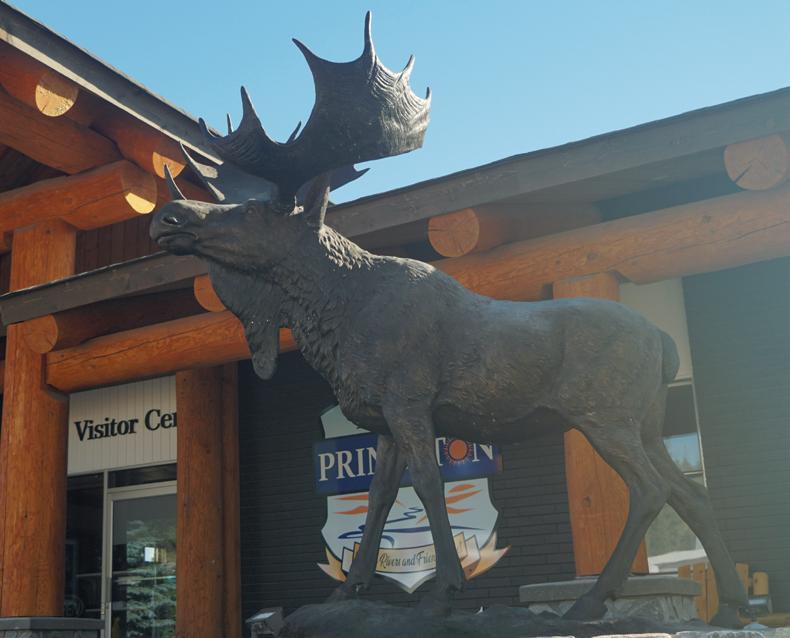
There are plans to make the sculpture tour even more in teractive and appealing to all ages. Postcards featuring pic tures of the sculptures are in the planning stages, creating sculpture-related activities for kids is in the works, and Schatz wants technology to be part of the fun as well.
“We’re going to hopefully make these animals come to life, whether that’s through an app or something else,” he said. “I think it’d be neat if you could hold your phone up and all of a sudden the animal turns and growls or does something neat.”
Visit the Town of Princeton website, princeton.ca , to learn more about the sculptures and everything else the community has to offer.



 © IMAGES COURTESY OF TOWN OF PRINCETON
DOWNTOWN
© IMAGES COURTESY OF TOWN OF PRINCETON
DOWNTOWN
NEW
WESTMINISTER © COURTESY OF TOURISM
NEW WESTMINISTER
ALL IMAGES © JOHN ATHIMARITIS / SIX SENSES ZIL PASYON
ADVERTORIAL ADVERTORIAL globalheroes.com November • 2022
RESPONSIBLE TRAVELLER
Make the Most of Winter in Kamloops, B.C.
There’s a chill in the air and frost on the grass—winter is on its way! Whether you’re plan ning your holidays or diving straight into outdoor activities, Kamloops is the place to be this winter. Between holiday festivi ties, time spent with family, and a host of indoor and outdoor ac tivities, there are family-friend ly experiences for every kind of winter adventure.
HIT THE SNOW
Who says winter has to be boring?
In Kamloops, winter is the perfect time to wrap up and head outdoors to enjoy the snow. Find fun-filled outdoor activities, from skiing to hiking and so much more.
Family-run Harper Mountain is both a hidden gem and a local favourite. Just 20 minutes from Kamloops, Harper Mountain is a small, laidback ski resort, complete with a terrain park and lift-operated tube park. Built, run, and beloved by families, Harper Mountain is perfect for beginners and expert winter sports lovers. Hit the hills by day for skiing, snowboarding,
snowshoeing or tubing, and settle down with hot cocoa by night. Harper Mountain’s season opens in mid-December and runs through March.
For a slower-paced winter adventure, keep warm with family and friends while bonding over a day on the ice or a snowy hike. Kamloops is home to plenty of indoor and outdoor skating rinks, perfect for gliding on the ice under snow-covered trees.

Inks Lake, Brocklehurst Arena & Pool, Westsyde Centennial Park, and Juniper Park are among many popular rinks where you can bring your skates and hit the ice!
The fun doesn’t end when the day does! Don’t miss Wildlights at BC Wildlife Park, a holiday light show that brings friends and fam ilies together to create magical, lasting memories. Popular among locals and back for its 24th year running, Wildlights is full of holi day fun for the whole family. Take family photos with Santa in his sleigh, walk through glowing light structures, view over 800,000 lights on display, and indulge in hot cocoa and festive treats.
MAKING A LIST, CHECKING IT TWICE
Holly jolly fun is waiting for you in Kamloops! Get in the holiday spirit with Christmas at Privato Vineyard & Winery and Woodward Christmas Tree Farm, a beloved long-time local tradition. While you may not be taking a tree home, the festive ambience and wintry joy will feel like a scene from a Hallmark movie. Bonfires, mulled wine, and ciders add a perfect touch to a great day out. Holiday shopping is easy at Monte Creek Winery’s Holiday Craft Market. Support local artisans and small businesses, enjoy delicious treats, and enjoy the cheerful atmosphere. This winery has just committed $10 million to upgrades, focusing on quality, innovation, and sustainability. Monte Creek’s wines are now divided into Ancient Waters and Living Land series. The Living Land series refers to the idea that great wine can only come from land that is truly alive. Biodiversity above and below the ground promotes a healthy environment and strengthens the grapevine,
leading to incredible fruit and incredible wine. The Ancient Waters series refers to the historical geological events that formed the land and prized soils.
A COZY STAYCATION
One of Tourism Kamloops’ values is to “fiercely protect the spaces we live and play in.” From staycations to staying near family over the holidays, Kamloops has plenty of accommodations that put

sustainability first. Delta Hotels by Marriott Kamloops, Best Western Plus Kamloops Hotel, and the Coast Kamloops Hotel and Conference Centre are all Biosphere Committed Companies. End every fun-filled day with a cozy evening indoors, watching the snow fall.
Visit tourismkamloops.com for details and to plan your winter fun today.

Sustainability in Travel and Tourism: In Practice with The Travel Corporation
For two years, people around the world put their highly anticipated travel plans on hold. Communities worldwide dependent on the tourism industry suffered as a result. During that time, many discussions took place within the sector about the need to re-evaluate operating practices so that when travel did return, the industry could build back better. COVID-19, it seemed, had jumpstarted the long-delayed conversation by travel and tourism to design with sustainability in mind. Now that travel has returned with pent-up demand, it’s time to understand what these promises look like in practice and ensure the conversation has moved beyond rhetoric.
The Travel Corporation (TTC), a group of 40 award-winning travel brands operating in 70 countries, is uniquely positioned to enable positive impact at scale, and is determined to inform travellers how they are succeeding and where they’ve faced challenges. In May, TTC released its first Impact Report (impact.treadright.org/ progress), making it the largest privately owned travel company to
do so. The report outlines progress against the 11 goals of TTC's five-year sustainability strategy How We Tread Right, launched in 2020 to address the most pressing issues faced by the industry and the planet: climate, food, waste, travel experiences, DEI, and wildlife. Then came TTC’s five-point Climate Action Plan in 2021 to address the company’s emissions.
This year, TTC announced its goal to achieve near zero emissions by 2050, through a formal commitment to science-based targets. These targets are currently under review by the Science Based Targets initiative (SBTi), an independent body that developed the first global science-based netzero standard to ensure businesses play their part in reducing emissions in line with keeping the global temperature below a warming of 1.5°C by mid-century.
WHAT DO CARBON REDUCTIONS FOR A TRAVEL BUSINESS LOOK LIKE?
While it varies on the type of business, TTC has an impressive and complex range including
brands such as Trafalgar, Uniworld Boutique River Cruises, Contiki and Red Carnation Hotels. The group owns 500+ vehicles, 13 Uniworld ships, 18 Red Carnation Hotels, five accommodations, 30+ offices and one winery. In practical terms, emissions reduction means changing the way the business operates. Here are some ways they have already started.
RENEWABLE ENERGY
TTC has eight solar projects on its various properties, and since September 2020 has sourced 28 per cent of global energy
needs from renewable sources and switched nine additional properties to 100 per cent. Contiki’s head office in London and accommodations Schöneck in Austria and Château in France all run on 100 per cent renewable energy, as do seven Red Carnation Hotels in London. The newly opened Xigera Safari Lodge gets 95 per cent of its power from a stateof-the-art solar energy center.

SUSTAINABLE FOOD Food is a big part of the travel experience as well as our respective footprints. Food
waste is one of the top three contributors to climate change, so food waste reductions are critical. So too is prioritizing local and organic food products, enabling us to reduce emissions associated with transportation while supporting systems of sustainable food production within our favourite destinations.
In 2021, TTC introduced food waste management systems Winnow and Leanpath at 13 hotels and ships and reduced food waste by 39 per cent at Red Carnation Hotels since September 2020.
CARBON REMOVAL Through its not-for-profit foundation TreadRight, TTC is investing in carbon removal solutions, which play a critical role in mitigating climate change. Two such solutions, showing very promising results in their pilot stages, provide long-term, potential permanent carbon removal solutions while creating co-benefits through GreenWave’s sustainable food production approach and Project Vesta’s ocean de-acidification.
Combining World Class Skiing with World Film Premieres
When actor Eric McCormack showed up in Whistler last season, it wasn’t to ski.
While Whistler is known for its world-class skiing during the winter months, it’s also home to one of the best film festivals in North America.
For 22 years, the Whistler Film Festival (WFF) has attracted some of the biggest names in film from across the globe to attend this British Columbia-based festival.
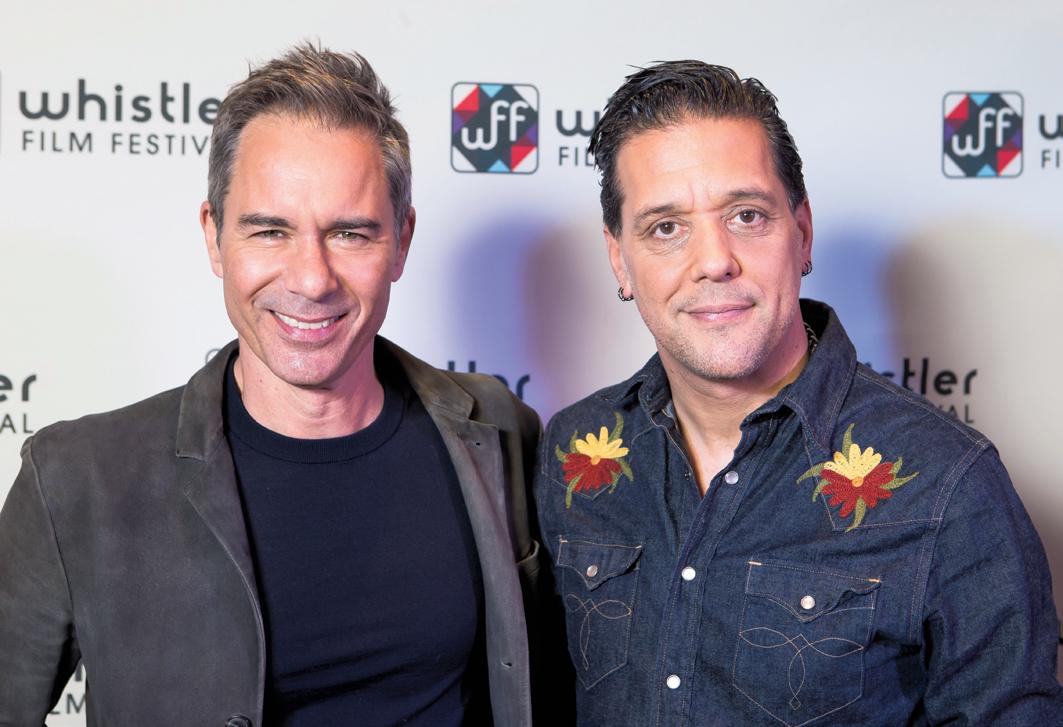
The festival prides itself on shin ing the light on Canadian inde pendent filmmakers and the joy of discovering new cinematic voices and new terrain. You never know when you will discover the next big thing, whether on a chairlift or in the theatres!
WFF is also proud of its record of promoting equity and was one of the first to establish gender pari ty goals. Celebrating the success of women in the industry started in 2016 with WFF’s Women in Focus series, then known as Women on Top, when WFF took 100 women to the top of Whistler Mountain during the festival for a keynote breakfast and expanded into a twopart series in 2018. In 2021, WFF
reached directorial gender parity, with 20 of 40 features and 25 of 41 shorts directed or co-directed by women or non-binary individuals.
This year the festival takes place from November 30 to December 4 in Whistler, B.C., and online from December 5 to January 2, 2023. This hybrid format allows the festival to provide the best of the in-person cinematic experience in Whistler and also reach new, engaged audiences across Canada while it streams a selection of Canadian and
international films. A word of caution for the true film fan, some films will only be available live, in theatres.
WFF22 is welcoming up to 90 films, including Oscar-contend ers, breakthrough Canadian titles, heart-stopping adventure films, and award-winning stories from around the globe. Unique industry initiatives and lively celebrations round out this cinematic celebra tion in North America’s premier mountain resort destination.
There are more than just red
carpets and film premieres at “Canada’s Coolest Film Festival.”
It is here where aspiring filmmak ers gain advice and showcase their skills to industry professionals to further their careers.
The industry-focused Content Summit in Whistler will feature over 30 sessions, including key notes, masterclasses, fireside chats, roundtables, and one-on-ones, fea turing forward thinkers, innovators, and decision-makers. Discussions on wide-ranging topics include blockchain, I.P. development, financing, co-production, bookto-screen adaptations, health and wellness, and creative collaboration, ensuring something for everyone.
Whistler Film Festival’s Content Summit will also give up-andcomers a chance to show off their skills and take home some prize money through the festival’s Talent Awards.
At WFF, you can indeed have a winning pitch. There is an opportunity for one British Columbia filmmaker to further develop their directing career and take home $15,000 cash plus up to $100,000 in services from across the industry through
the MPPIA Short Film Award Competition. The Power Pitch Competition is designed to set participants up for success while competing for a $36,000 producer prize package.
Feature-length films also have the opportunity to also walk away with cash prizes. The Borsos Competition for Best Canadian Feature is worth $35,000, the Shortwork Awards winner will receive $1,000 for their short film, and a B.C. student will walk away with a $500 prize.
The atmosphere that the Whistler Film Festival creates is one of the most unique experiences Whistler has to offer. It’s about finding new terrain, whether on the slopes or in the theatre.
Where else can you ski incred ible snowy mountains through the day and sit down to share the experience of a live film premiere with top talent at night?
Ticket packages and accommodation bookings are available through the festival’s website whistlerfilmfestival.com and for the latest updates, follow their social media.

Mountains by day Movies by night
© PHOTO COURTESY OF TOURISM KAMLOOPS
ERIC MCCORMACK AND GEORGE STROUMBOULOPOULOS © KIM EIJDENBERG
Ticket and Accommodation packages available online
CONTIKI SECURED 100 PERCENT RENEWABLE ENERGY FOR ITS SPECIAL STAY ‘CHÂTEAU DE CRUIX’, A SIXTEENTH CENTURY PROPERTY LOCATED IN FRANCE © COURTESY OF THE TRAVEL CORPORATION
ADVERTORIAL ADVERTORIAL globalheroes.com November • 2022
Welcome to Fresno County, California!
From thrilling outdoor adven tures, exceptional farm-to-fork dining, family-friendly attrac tions and one-of-a-kind arts and cultural districts, Fresno County is truly the heart of California with plenty of fun year-round.
THREE NATIONAL PARKS IN ONE TRIP
With nearly 300 days of sunshine each year, Fresno County is made for those seeking to venture outdoors. No other county offers you three extraordinary national
parks located a short drive away. Stay in Fresno or Clovis and drive 90 minutes to Yosemite, Sequoia and Kings Canyon National Parks. See Yosemite’s incredible landmarks and breathtaking views, such as El Capitan Mountain, Half Dome and Mariposa Grove. Hike among the largest trees in the world, including the 275-foot General Sherman, in Sequoia National Park. These magnificent trees have been around for thousands of years. If you’re looking for a quieter park, journey to Kings Canyon National Park, an incredible hidden treasure home to the deepest canyon in the United States, with roaring waterfalls and more incredible sequoia groves.
ADVENTURE IN EVERY SEASON
Catch pink and white petals falling along the Fresno County Blossom Trail, a stunning representation of the county’s impressive agricultural footprint. The 112-kilometre trail begins to bloom in mid-February with various festivals and events along the way. Get outdoors in the spring and summer by hiking scenic trails beloved by locals, like
Big Table Mountain and Pincush ion Peak, and taking a dip in one of several awe-inspiring lakes. Learn more about Fresno County’s history and culture by exploring the Fores tiere Underground Gardens, an un derground wonder carved by hand in the early 1900s. Sit in the tran quil Shinzen Japanese Friendship Gardens or walk through Fresno’s vibrant Mural District downtown.
The fall brings more fun annual events: watch taco trucks compete to become the next taqueria cham pion at the Taco Truck Throwdown in Downtown Fresno and see hot air balloons float to the sky during ClovisFest in Old Town Clovis.
No one does the holidays quite like Fresno County. Take part in the annual trek to the nation’s Christmas tree in Kings Canyon National Park, where a wreath is laid on the General Grant Tree, a prayer is given and songs are sung.

Visit the largest Hmong New Year celebration in the world in Fresno.
The days-long festival is held each year in late December.
FARM-TO-FORK DINING
As the number one agricultural
producing county in the United States, which contributes nearly $8 billion USD to California’s econo my, the food in Fresno County is unmatched. With more than 300 crops, including the production of nearly $3 billion USD of almonds, grapes and pistachios alone, “farm fresh” starts here and is in every dish served. Journey to the heart land of farm-to-table dining to savour dishes created with fresh ingredients grown minutes from where your meal is plated.
While you are visiting, tap into some of Fresno County’s brewer ies where local brewers are putting their own twist on the craft beer game, including in Downtown Fresno’s Brewery District and along the Clovis Taps Trail. Stop by the local farmers’ markets to taste farm-fresh produce from the source that feeds our community and the country.
Plan your trip today at visitfresnocounty.org


Calanoa: Paradise in the Jungle
A COMMUNITY PROJECT
 RAYE MOCIOIU
RAYE MOCIOIU
Deep in the heart of the Amazon jungle lies an off-the-grid experience unlike any other.
The Calanoa Jungle Hotel, described as a jewel of a hotel, is a laboratory for a sustainable Amazon settlement. Designed and operated by Diego and Marlene Samper, the hotel is a unique compound of cabins designed and built with locals in mind.

The Sampers met on a science and research expedition in Colombia’s Sierra Nevada de Santa Marta National Park in 1980 and settled in the Colombian Amazon soon after falling in love. They founded the first Calanoa here, a self-sufficient farm where they lived and worked on conservation projects.
In 1988, the Colombian drug wars forced the Sampers and their daughters to flee. A decade later, they migrated to Canada, but their love of the country stayed strong. Ten years ago, the family returned to the Amazon with a mission in mind: rebuild Calanoa, better and stronger than ever.
Diego designed the eight-cabin lodge, combining traditional techniques with a contemporary approach, and enlisted the help of locals of the Mocagua community to bring their dream to life. A community endeavour, the locals are as much a part of the magic of Calanoa as the art, and as such,
the hotel has invested in their home region time and time again. In creating Calanoa, carpentry classes were provided, as none of the locals had the skills needed to build. The staff is local to the region, and their passion for the jungle spreads to visitors, sharing the beauty and magic in every experience.
Every part of the jungle hotel
was created with sustainability in mind, from the materials used in building the structure to the replanting of the trees and palms used for the future maintenance of the buildings, and even the roofs, woven from palms. Rain is harvested, and the energy comes from solar panels. The team made use of local materials and resources, keeping each part
of the process as sustainable as possible. Everything is from the jungle, and each aspect is unique. The architecture enhances the experience: ethereal walls and light spaces improve the natural air circulation, allowing visitors to open their senses to the jungle without limits. This is all by design; Calanoa is both a living work of art and a place to educate guests on the importance of conservation.
A space of alternative educational processes, the jungle lodge seeks to contribute to the conservation of the biological and cultural diversity of the Amazon region through art, design, architecture, scientific research, community education and sustainable tourism.
Residences, workshops, and multidisciplinary projects, including cultural activities, make Calanoa a place of luxury and learning, an immersive dive into the power of alternative energies and the beauty of living off the land.
The charm of a small town close to Southern California’s most famous attractions, Simi Valley is Southern California’s best-kept secret. Located just minutes from Los Angeles, Simi Valley offers a vibrant city full of cultural diversity, historical landmarks, and beautiful rolling hills. Los Angeles International Airport, Van Nuys Airport, and Hollywood Burbank Airport are all within 65 kilometres of Simi Valley and offer easy access to Simi Valley from anywhere in the world. All major domestic airlines serve at least one of the three airports, with many offering services from all three.
Generations before protected the beautiful natural resources, the gorgeous hills, and the mountains that surround Simi Valley, California. Each entrance to Simi Valley, California, is through a greenbelt, nature

Simi Valley offer an array of hiking trails, but mountain biking is also a popular outdoor sport in Simi Valley. With nearly 40 million Americans now mountain biking every year, Simi Valley has become a popular destination for the sport in Southern California.
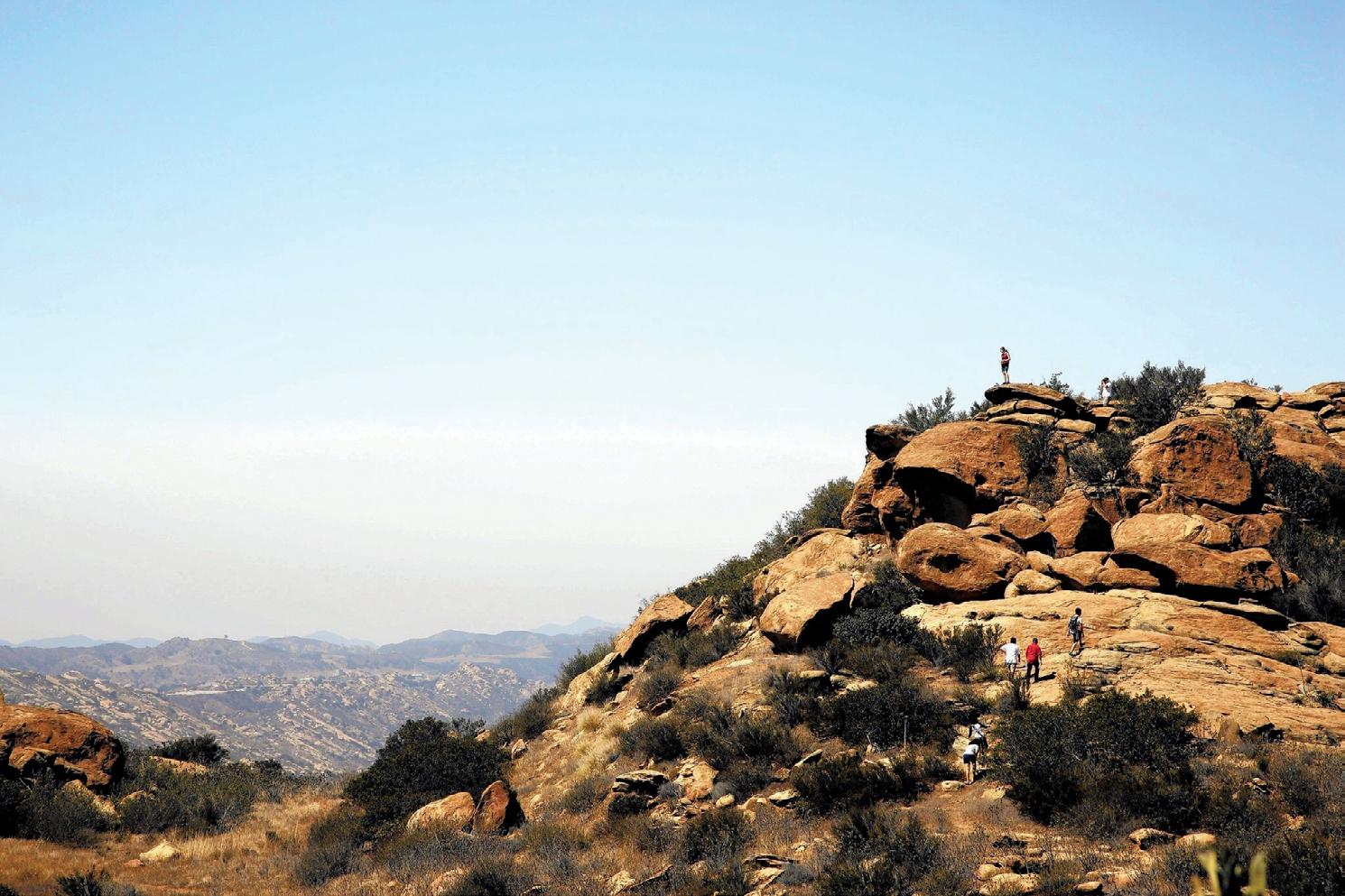
Surrounded by the Santa Susana Mountain range, the towering mountains surrounding the beautiful valley provide some of Southern California’s most picturesque rides. There are more than 15 mountain biking trails that range from easy to extremely challenging and are perfect for both beginning and experienced riders. After exploring all things outdoors in Simi Valley, don't miss this one-of-a-kind museum set on a beautiful hilltop with stunning views of the valley.
The Ronald Reagan
when you walk through an exact replica of President Ronald Reagan’s Oval Office, complete with his preferred decor and a jar of jelly beans on the desk. You can also board and tour the same Air Force One plane that President Ronald Reagan flew more than 660,000 miles in. Learn about the 40th President of the United States through the Museum & Library’s many permanent and visiting exhibitions, and stay for lunch at one of the two on-site restaurants.
Simi Valley is Southern California's best-kept secret, full of small-town charm, and is the perfect choice for mountain biking, hiking, or your next getaway.

Whether you are into hiking, visiting museums, or attending a performance, you’ll find it all and more in Simi Valley. With more than 4,000 acres of park land in 38 parks, one perform ing arts centre, and two his torical landmarks, visitors and residents enjoy superb amenities
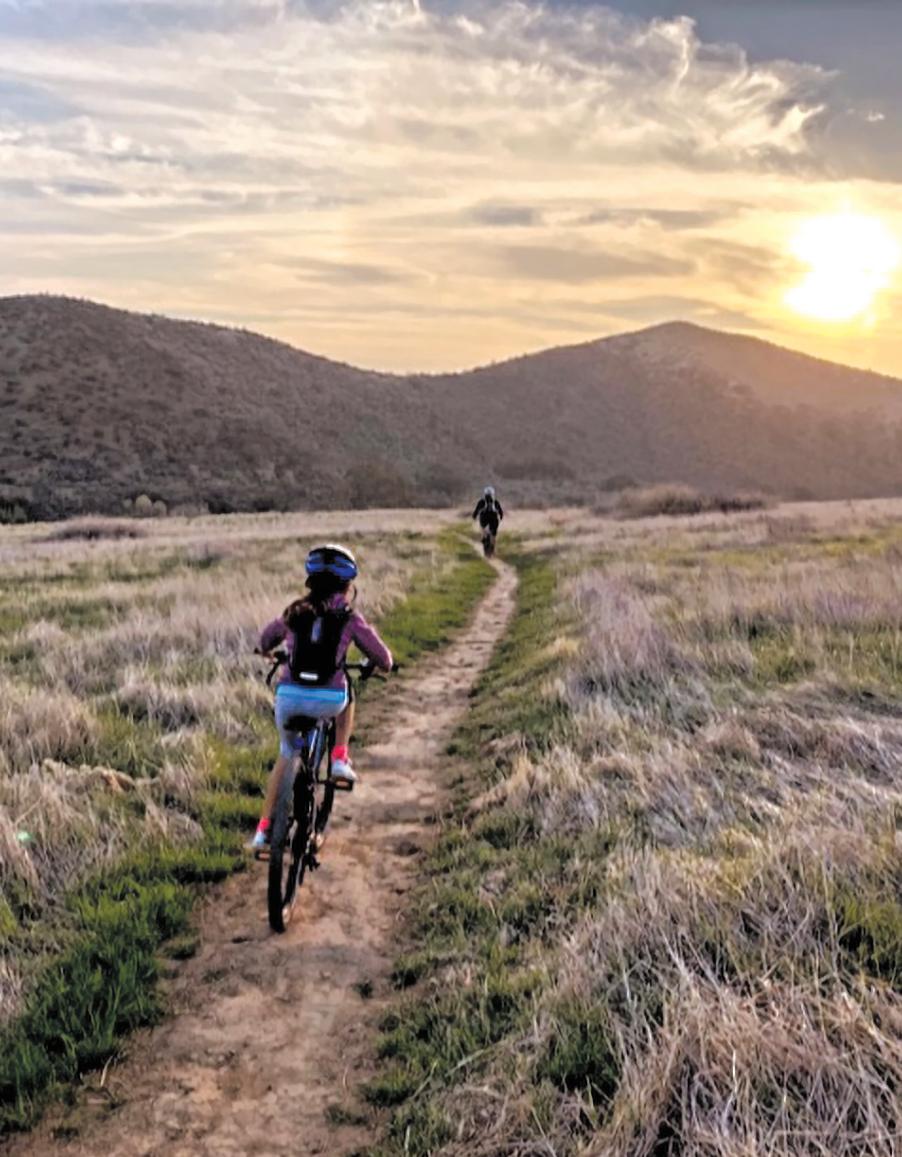
CONT. NEXT PAGE
SEQUOIA NATIONAL PARK © COURTESY OF VISIT FRESNO COUNTY
A SUSTAINABLE ARCHITECTURE FOR THE HUMID TROPICS © COURTESY OF CALANOA
Start your adventure at VisitSimiValley.com Small-Town Charm and Outdoor Fun in Simi Valley, California Start your adventure at VisitSimiValley.com © COURTESY OF SIMI VALLEY CHAMBER OF COMMERCE RESPONSIBLE TRAVELLER ADVERTORIAL ADVERTORIAL globalheroes.com November • 2022
COME STAY
RESPONSIBLE TRAVELLER
Food, Wine, and Adventure in Eugene, Cascades & Coast

Experience a year-round play ground where the great out doors are not just a highlight of your trip but an integral part of the local lifestyle. The Eugene, Cascades & Coast re gion is home to new wonders every season. Between exploring the pristine natural landscapes and savouring Oregon’s incred ible culinary bounty, you’ll find yourself charmed by the region’s little wonders. From the tip of the Cascades mountain region through the southern end of the Willamette Valley, all the way to the Central Oregon Coast, there’s a world of adventure waiting for you.
WILLAMETTE VALLEY WINE
Welcome to the South Willamette Valley, with more than 20 wineries surrounding the Eugene metro area. Often ranked as a top wine destination, the South Willamette Wine Trail showcases excellent wineries, taking you from urban wineries at the heart of Eugene to quiet tasting rooms deep in Oregon wine country. Immerse yourself in the wine
country experience and find your perfect glass at these accessible tasting rooms.
SOUTH WILLAMETTE VALLEY FOOD TRAIL
Explore over 50 destinations offering unique culinary and foodie experiences in the South Willamette Valley. This region of Oregon is a culinary hub, with a variety of farms and local ag riculture feeding chef creativity and inspiration. Local is king here, with farm-to-table restau rants, artisan products and farm experiences highlighting local foods and hip, rustic and for ward-thinking restaurants serv ing 33 per cent or more local ingredients on menu items. Find something for every palate in this foodie destination.
THE OREGON DUNES NATIONAL RECREATION AREA

Take a day trip to Florence and explore Oregon’s classic coastline. It’s easy to discover adventures unique to this seaside town. Relax on the beaches or stroll through an intriguing sanctuary
of carnivorous flora at the Darlingtonia State Natural Site, tour North America’s largest coastal sand dunes by dune buggy, or learn to sandboard on the sandy slopes. When you’re done, explore great eateries and places to stay in the Old Town neighbourhood.
CYCLING THROUGH COVERED BRIDGES
Bike along a historic covered bridge route and discover three official Oregon Scenic Bikeways and an iconic movie location—the orange train trestle from Stand By Me . Looping around Dorena Lake and up to
Culp Creek, the route totals 57.94 km (36 miles) for an allday cycling excursion, ending in Cottage Grove, Oregon, where you can unwind with a drink, a show, or a delicious meal. Prefer a shorter bike ride? This beginner-friendly trail is easily shortened to accommodate all time frames.
HIKES AND WATERFALLS
Explore easily accessible hikes near the Eugene and Springfield metro area or iconic sights and waterfalls in the Coastal or Cascades mountain ranges. Hike, run, or stroll through old-growth forests and quiet canyons, across ancient lava beds, along dramatic cliffs and around serene lakes. Scenic views are swathed in golden hues, colourful leaves frame roadways, and the air is crisp and bursting with woodsy scents as you note seasonal wildflowers, birds, and wildlife.
Memories are waiting to be made in Eugene, Cascades & Coast. Plan your trip at EugeneCascadesCoast.org
THE CALANOA FOUNDATION

For more than a decade, Calanoa has contributed to the conservation of the biological and cultural diversity of the Colombian Amazon in the Indigenous territories near the reserve, Tikuna, Cocama, Huitoto, and Yagua.
The Foundation seeks to enrich the local communities, using funding from the hotel to support community projects and participate in the conservation and recovery of ancestral knowledge and cultural practices. Currently, the Foundation is seeking funds for projects like El Yacaré, a boat that travels down the Amazon River at the request of the communities, carrying books, art, and experts on carefully curated subjects for the Amazonian population. Calanoa is also working with local experts to promote research projects that will create a biodiversity inventory of the Calanoa Reserve’s flora and fauna, creating a record of the medicinal plants found in the gardens and traditional community orchards. The children’s choir of El
Vergel, supported by Calanoa, preserves the dances, songs, and the Tikuna language. The Yacaré project contributes to conserving Indigenous languages and traditions by recording the stories and songs of the elders and generating an archive available to the communities. The Calanoa Foundation also contributes to a scholarship program for
Indigenous students and provides encyclopedias and dictionaries for schools—and the students often return to contribute to Calanoa.
ART IN THE AMAZON
seek to nurture it through Calanoa’s projects, combining traditional art and culture with sustainable management of forest and river resources.
The result is a strengthening of cultural identity, a deeper understanding and appreciation for the land, and stronger economic well-being for the community as a whole.
Calanoa focuses on what they describe as “art for conservation,” meaning that each artistic venture contributes significantly to the community’s economic well-being, strengthening cultural and ethnic identity, and environmental conservation.
The Mural Painting in Mocagua project, in which community members paint the facades of their houses with relevant motives to each family’s Indigenous clans, is a perfect example of this mission.
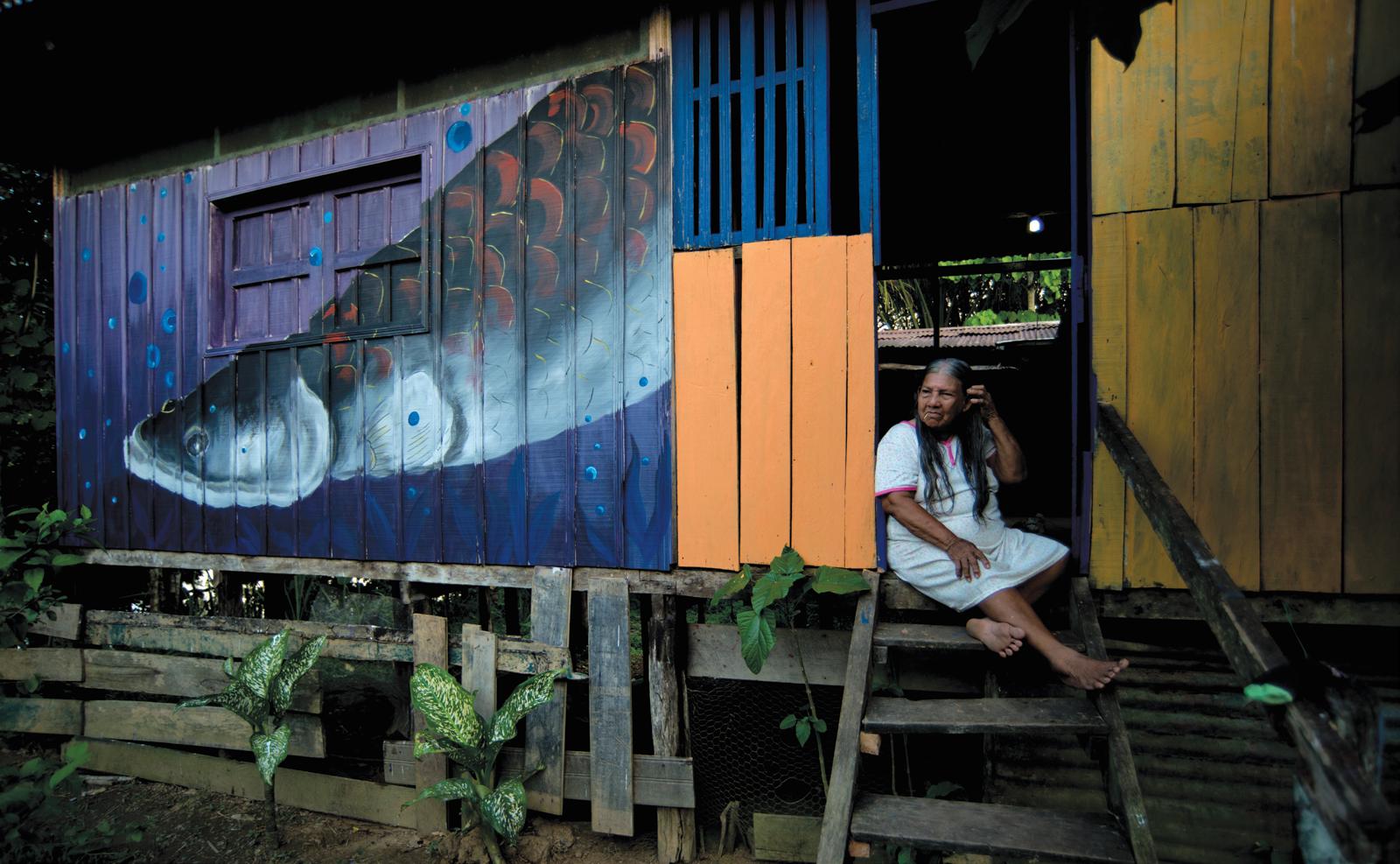
The Amazon offers endless opportunities for art and learning, but Calanoa takes it one step further. In 2013, in partnership with Kwantlen Polytechnic University in Vancouver, Diego and Marlene established the Amazon Field School, offering students the opportunity to seek alternative learning opportunities in a new and exciting environment: the jungle. The Amazon Field School explores topics such as creativity, imagination and aesthetic inquiry, academic research, ecology, conservation and environmental awareness, cultural awareness, community development, and environmental design.
Your Extraordinary Escape Starts Here
As the weather cools, wanderlust is prone to strike. Get ahead of the winter blues with a vacation that takes you on a tour of the world’s most beautiful places, from South Africa to the Hawaiian Islands and so much more.
Since 1984, Canada One Travel has been a trusted source for travel planning for both corporate and leisure travellers. An award-winning

travel agency, Canada One Travel knows that your travel needs are unique. Whether you’re preparing to embark on your first trip over seas or a company looking to con solidate all travel under one roof, everything you need to plan your trip can be found in one place.
Canada One Travel has selfbooking tools to assist corporate clients in being more efficient in
controlling their travel expenses while being compliant with the company’s travel policies.
For leisure travel, professional travel advisors with years of expe rience can provide sound advice, or travellers can take advantage of self-booking tools, perfect for simple travel itineraries, sustain able tourism, and multigenera tional tourism.
Destination weddings and family reunions are a breeze when you plan with Canada One Travel. Their excellent cus tomer service and travel advisory teams will take care of all the heavy lifting so you can focus on the fun parts.
There’s a whole world of beauty and adventure waiting to be explored.
YOUR ADVENTURE AWAITS IN…
South Africa , where you’ll step out of the ordinary and into a journey that will leave you in awe. Lions, cheetahs, and elephants, oh my! Your adventure includes a choice of accommodations, private guided
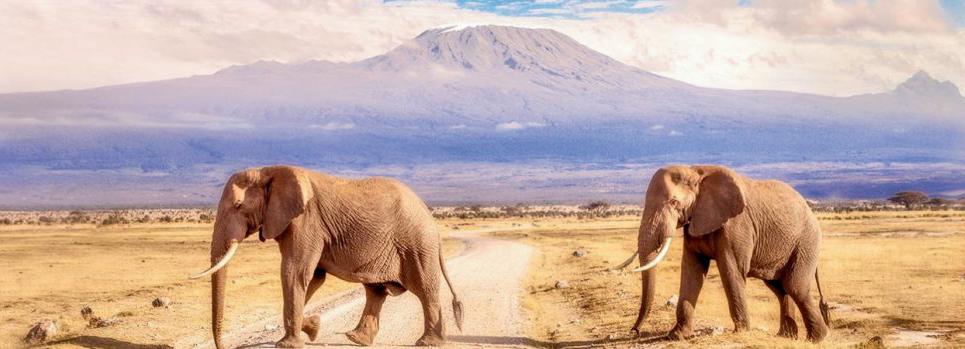
sightseeing, shared game drives, and a local host at your service to make your journey extraordinary.
Alaska, where the beauty of the land is waiting to amaze you. See glaciers calve into the sea, ride the world-famous Alaska Railroad, and cruise through the sea to watch for seals, sea otters, birds, and even whales. Don’t forget your camera!

East Malaysia, where you’ll stay in two award-winning deluxe lodges: Sukau Rainforest Lodge and Borneo Rainforest Lodge. Known for its beaches, rainforests, coral reefs and abundant wildlife, and with islands famous for div ing, this tour of Sabah was made for adventurers.
Colombia, where the biodiversi ty alone will leave you breathless. Travel from Bogotá to Medellín, and Cali to Cartagena de Indias, experiencing incredible food, dancing, and historic treasures all the while.
Hawaii, where you won’t be able to help smiling as tranquil ocean waves kiss your feet. Travel through the best of the Hawaiian Islands and marvel at the sight of

the huge volcanic Haleakala Crater in Haleakala National Park. Croatia , where spectacular scenery, historic sites, and special experiences abound. Explore the breathtaking architecture and walking tours through Zagreb, Opatija, Zadar, Split, and Dubrovnik in Croatia and Slovenia’s capital Ljubljana.
Canada’s Maritimes, where you’ll get acquainted with the local cul ture, charming villages, and sea faring traditions of Nova Scotia, Prince Edward Island, Cape Breton Island, New Brunswick, and Maine in the United States. Take in stun ning landscapes, scenic drives, and adventures on high tides.
Australia, where the natural wonders and coral reefs will stay in your memory forever. Australia is filled with beauty, from sweeping coastlines and pristine beaches to picturesque wineries and national parks teeming with wildlife.
Travel with Canada One Travel for the journey of your dreams. Start planning today at canadaone.travel or contact 800-668-6889.
CONT. PREVIOUS PAGE
Art is integral to Calanoa. As artists and conservationists, the Sampers believe that creativity is the greatest economic resource possible, and they
For Trips That Move You Your best vacation begins here canadaone.travel © IMAGES COURTESY OF CANADA ONE TRAVEL
SKINNER BUTTE © BRANDON FRALIC
MURAL ART AT A TIKUNA VILLAGE © COURTESY OF CALANOA
ADVERTORIAL ADVERTORIAL globalheroes.com November • 2022
RECIPES
Mild Gouda: The Goes-With-Everything Favourite!
Descended from a long line of cheesemakers, the Bergeron fami ly has been developing its expertise in Saint-Antoine-De-Tilly in the Chaudière-Appalaches region for more than 30 years. The passion and cheese-making knowledge, passed down from generation to generation, helped the family devel op the signature Bergeron flavour. Today, the company’s mission is to position Fromagerie Bergeron as a leader in the cheese industry and to remain committed to preserving the unique character and taste of a Nordic terroir that’s all its own.
Highly versatile Gouda is a crowd favourite for a reason. This firm orange-hued, wax-coated cheese, ripened for eight to 12 weeks, is made with pasteurized cow’s milk. Use it to gratinate your meals, snacks, or tastings. Melt it on your vegetables or put it in your sauces. Try it with a blond ale, a light red wine, a dry white wine, or a rosé wine. No matter how you use it, the whole family will enjoy the mild flavour. For a cozy comfort meal packed with flavour, try these pancetta stuffed potatoes, where Fromagerie Bergeron’s mild Gouda cheese takes centre stage.
PANCETTA STUFFED POTATOES WITH MILD GOUDA CHEESE DESIGNED AND PRODUCED BY MARIE-JOSÉE PATRY, PHOTOGRAPHER AND FOOD STYLIST.

This classic never goes out of style! Here is our version of the pancetta stuffed potato with a touch of veg etables. Enjoy your meal!
SERVINGS: 8 • PREP: 30 MIN.
• COOKING: 40 MIN.
Ingredients
• 4 large russet potatoes
• 135 g (1½ cups) broccoli in small florets
1 tbsp. vegetable oil
• 1 tbsp. garlic flower
• 175 g (6 oz) pancetta, sliced or diced 60 g (¼ cup) margarine
• 260 g (1 cup) plain lactose-free Greek yogurt
• 2 tbsp. salted herbs from the Lower St. Lawrence
• 10 g (¼ cup) fresh chives, snipped or 1 tbsp. dried
• 1 block (250 g) Bergeron mild Gouda cheese, grated

• Salt and pepper to taste
Directions
1 Preheat the oven to 200°C (400°F) and line a baking sheet with parchment paper.
2 Carefully wash the potatoes and cut them in half length wise. Place them on the baking sheet and bake in the middle of the oven for 30 minutes or until the potatoes are tender.
3 Meanwhile, combine broc coli florets, oil, and garlic
flower in a bowl. Halfway through cooking the pota toes, spread the broccoli on the baking sheet.
4 Over medium heat, sauté the pancetta for about 8 minutes in a skillet. Set aside on a pa per towel.
5 Coarsely chop broccoli with a knife.
6 Scoop out the flesh from the potatoes, keeping about 1.25 cm (½ inch) at the bottom.
7 In a large bowl, mash scoopedout flesh with margarine using a potato masher or fork. Add broccoli, half of the pancetta, yogurt, salted herbs, half of the chives and half of the grated cheese. Mix well and season with salt and pepper.
8 Spoon the mixture back into the potatoes. Sprinkle with remaining cheese, pancetta, and chives.
9 Place the potatoes on the bak ing sheet and bake for 5 to 10 minutes, until the cheese is melted.
10 Serve with a spring salad.
Find more recipes at fromagesbergeron.com/en/recipes
Rethinking the Meaning of Good Food
Every night, one in nine people go to bed hungry. This fact is the driving force behind Good Food For Good, a BIPOC womanowned organic food company with a range of award-winning sauces.
Before Richa Gupta started Good Food for Good in 2013, she was on a mission to answer the question: how do you make eating healthy easy and delicious while making a difference in the world? What if you made healthier, delicious meals and donated meals for those in need at the same time?
As a mother, Gupta found that it was challenging to feed her family with good, nutritious food on busy nights—too often, the easy and convenient dinner options lack nutritional value, making families choose between convenience and healthy eating. At the same time, Gupta was driven to make a difference in the world, and she saw an opportunity to do both at the same time.
She started Good Food for Good using ingredients that you can find in your own kitchen, giving every product a homemade feel. Their
line of ketchup, barbecue sauces, and homemade vegan cooking sauces are USDA-certified organic, sweetened only with dates, and free of gluten, refined sugars, soy, dairy, and preservatives. If you wouldn’t add it to your homemade meals, you won’t find it in Good Food for Good’s sauces. No longer would families have to choose between a quick and convenient meal or a healthy and nutritious one—they could have both!
Through their Buy One, Feed One program, the company donates one meal for every single jar of sauce sold, combatting hunger in partnership with food banks and nonprofit organizations like Food Banks Canada, LA Food Bank and the Akshaya Patra Foundation. Through these partnerships, Good Food for Good has donated more than 1.5 million meals across the U.S., Canada and India.
Good Food for Good makes it easy to put your health first without sacrificing flavour and easier still to support communities across the world, so no one has to go to bed hungry.
AUTUMNAL COCONUT CURRY RECIPE BY RICHA GUPTA
Hello November! Our days are getting shorter, and nights are getting chillier. Salad no longer brings me joy, and I crave a nice bowl of warming soup or curry to keep me warm all season long. If you are like me, you should continue to read.
I am a big fan of warming spices in a curry—whether it’s Thai, Malaysian, Japanese or Indian. They are perfect for cool evenings. Spices are also loaded with nutrients; a scien tific study published in 2021 showed that a single serving of mixed spices can significantly modify/restore certain com mensal microbes, particularly in people who do not regularly consume these spices.
As we now know, the health of our immune system is directly correlated to the health of our gut. Keeping our gut healthy with lots of prebiotic foods (vegetables) and spices can go a long way in keeping us healthy.
Cranberries: Local, Healthy, Delicious

Cranberries are native to British Columbia and are called “ibimi” [ihbih-mee] or “bitter berries” by the local First Nations. This bitterness is due to the proanthocyanidins (PACs), which are also responsible for many of the unique health bene fits of cranberries, such as protecting the heart and cardiovascular system. Known for their bitter flavour, cranberries are naturally very low in sugar. This bitterness is great for those who like dark chocolate and black coffee—pure unsweetened cranberry products fit right into our palate. You can get unsweet ened cranberry juice and cranberry juice blends from Bremner’s, our local B.C.-based juice maker. For most people, though, a sweet tooth is evident. That is why most cran berry products have added sugar to increase palatability. Thankfully, the added sugar doesn’t diminish any of the health benefits—a spoon full of sugar helps the medicine go down, after all. Sweetened dried cranberries have the same sugar content as rai sins but provide many more health benefits. At this festive time of year, it may be a bit more challenging to lower our sugar intake, but Lisa MarcAurele at Low Carb Yum
(lowcarbyum.com) has a recipe for you that is short on prep time, lowcarb, eye-catching and sure to please family and friends. We wish you a happy and healthy holiday season.
I want to share one of my favourite curries for winter nights that is loaded with gut-healing and anti-inflammatory spices and is ready in minutes. It’s a family favourite in our house!
Ingredients
Good Food For Good Organic Coconut Curry
• 2 cups red pepper cubed
• ½ cup red onion cubed 3 cups chopped spinach
• 2 cups cooked chickpeas
• 1 cup water
• 1 tsp coconut oil
Directions
• Sauté onion and peppers in 1 tsp of coconut oil for 2 minutes.
• Add all other ingredients except spinach and cook for 5 minutes till the sauce is nice and bubbly.
• Add spinach and turn off heat.
• Taste and adjust salt if need be.
• Add a squeeze of fresh lemon and chopped cilantro to garnish.
• Serve with basmati rice, and enjoy.

a boil over medium heat for
minute.
2 Stir in berries; cover and reduce
Cook until most of the berries have popped, about 7 to 10 minutes. Add lemon
3 Press mixture through a sieve
FILLING
set
1 In a large bowl beat the cream cheese with the xylitol and stevia until light and fluffy. Add eggs, beating just until blended. Add lemon juice. Pour into crust.
TOPPING OFF AND BAKING
1 Spoon cranberry sauce over filling; cut through filling with a knife to swirl.
2 Put a pan on the bottom rack of the oven and fill with water.
3 Bake cheesecake on middle rack at 350°F for 45 minutes. Turn oven off; let cheesecake stand in oven for one hour with door propped ajar.
4 Remove from oven and cool on a wire rack. Carefully run a knife around sides of the pan to loosen and remove side of the pan. Refrigerate overnight.

For more cranberry recipes, visit our website at www.bccranberries.com CRANBERRY SWIRL CHEESECAKE RECIPE BY LISA MARCAURELE PREP TIME: 10 MINUTES COOK TIME: 2 HOURS SERVINGS: 12 PEOPLE When you’re looking for a festive holiday treat that’s as beautiful as it is delicious, this easy cranberry swirl cheesecake is a decadent des sert that’s sure to please any crowd! Ingredients CRUST • 2 cups pecan halves • 1/4 cup melted butter • 2 tablespoons Pyure All Purpose • 1/2 teaspoon cinnamon SAUCE 1/3 cup powdered erythritol • 1/4 teaspoon stevia extract powder • 1/3 cup water • 1 bag fresh cranberries, 12 ounces • 1 teaspoon lemon juice FILLING • 32 ounces cream cheese • 1/2 cup powdered erythritol 1/4 teaspoon stevia extract powder • 5 eggs lightly beaten • 1 tablespoon lemon juice Directions CRUST 1 Grind pecans in a food pro cessor. Pulse the processor until the largest pieces are no bigger than split peas. Add the butter and the sweetener. Blend until it’s mixed evenly. 2 Press it into the bottom of a 9-inch springform pan. Sprinkle cinnamon on top to cover. Press cinnamon in with back of a spoon. 3 Bake at 300°F for 8-12 minutes. 4 Cool. SAUCE 1 Combine sugar and water in a large saucepan. Bring to
one
heat.
juice.
and
aside.
NUTRITION: SERVING: 1SLICE CALORIES: 292 CARBOHYDRATES: 8G PROTEIN: 7G | FAT: 26G | SATURATED FAT: 11G | POLYUNSATURATED FAT: 3G | MONOUNSATURATED FAT: 6G | CHOLESTEROL: 101MG SODIUM: 264MG | POTASSIUM: 86MG | FIBER: 1G | SUGAR: 3G | VITAMIN A: 700IU | VITAMIN C: 4.1MG | CALCIUM: 90MG | IRON: 0.7MG
CRANBERRY SWIRL CHEESECAKE © COURTESY OF BC CRANBERRIES
Try something new today at www.bccranberries.com Tasty Healthy Versatile
© COURTESY OF FROMAGERIE BERGERON
© COURTESY OF GOOD FOOD FOR GOOD FOOD HEROES & FEEL GOOD
ADVERTORIAL ADVERTORIAL globalheroes.com November • 2022
DōMatcha® is a 100 per cent authentic Japanese matcha brand and is one of the leading brands in North America that boasts a myriad of benefits. Matcha contains a combination of caffeine and L-theanine, an important amino acid that aids focus and relaxation. Green tea leaves account for the richest source of naturally occurring L-theanine. Matcha also contains a powerful punch of antioxidants called Catechins. Oxygen radical absorbance capacity, or the ORAC value,
Discover the Way of Matcha
measures the antioxidant capacity in a nutrient or food product. DōMatcha® boasts an ORAC value of 1354/gram. To compare, kale has an ORAC value of 17.7 and blueberries have 24 per gram.
DōMatcha® provides a fantas tic alternative to coffee as mat cha is alkalizing and non-acidic while supplying you with key nutrients needed to give you an extra boost throughout your day. DōMatcha® contains 25-35mg/g of caffeine, while coffee contains 80-120mg/g.
As a result of the high caffeine levels found in coffee, energy spikes followed by a crash are common. However, matcha can provide a more continuous release of caffeine that main tains energy levels throughout your day.
DōMatcha® ensures only the purest leaves are used in their tea. The plants are shielded from sunlight for two to three weeks prior to harvest to boost chlorophyll and L-theanine content. Additionally, only the youngest and most tender leaves
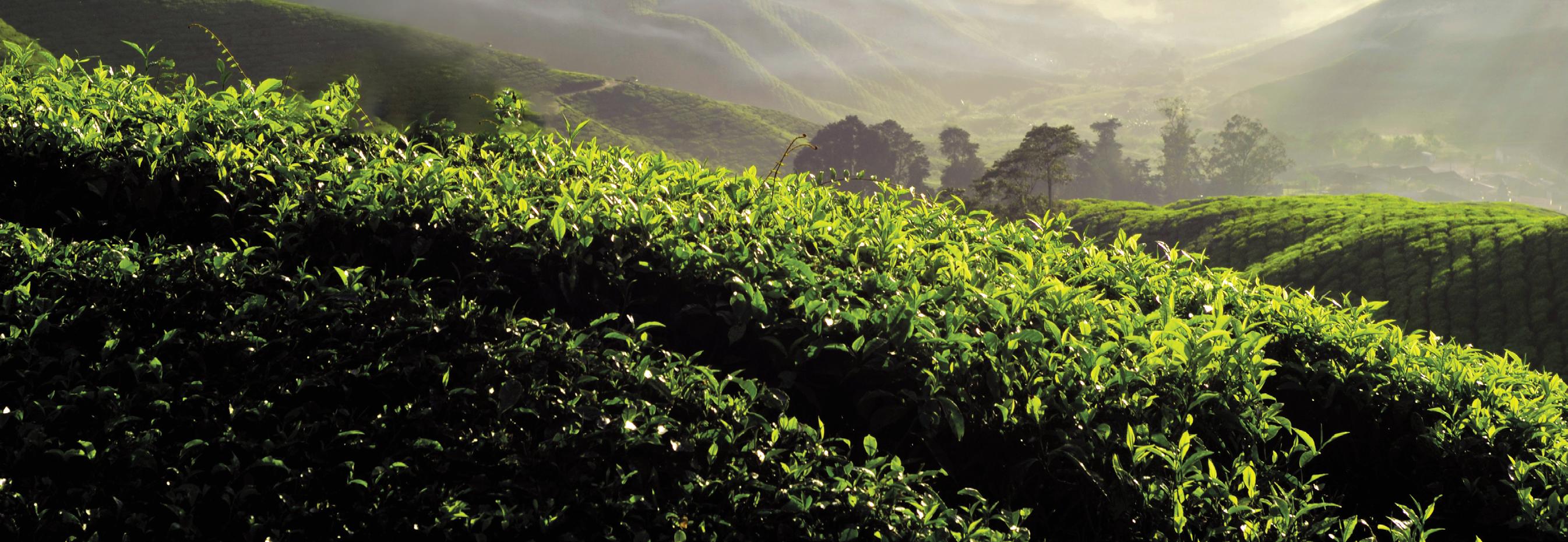
are harvested for DōMatcha®. Before production, rough fibres such as stems and veins of the leaves are removed. The leaves are then stone-ground to guarantee a smooth and delicious taste while preserving essential nutrients.
Not only does DōMatcha® exhibit a multitude of benefits, but they are also true to their historical and cultural roots.
The DōMatcha® brand is backed by over 700 years of expertise. Kazunori Handa-San is a 16thgeneration tea master who guides DōMatcha® production in Japan. DōMatcha® established a close relationship with the Handa Clan, renowned for their tea expertise, in 2005. The Handa Clan are highly respected and recognized tea masters whose history dates back 400 years.
Additionally, DōMatcha®’s supplier, based out of Uji, Kyoto, has proudly been in the business for over 300 years. In 2007, DōMatcha® was founded with the goal of bringing authentic Japanese Green Tea to international markets. In 2016 DōMatcha® was the first to introduce decaf matcha to markets outside Japan.
The DōMatcha® brand is owned by Andrews & George, who remains the parent company of Ecotrend Ecologics Ltd., DōMatcha’s distributor, retaining the legacy and close relationships




Andrews & George has had with Japan for centuries.
Andrews & George Company Limited, celebrating its 130th year in business, was founded in 1892 as an import/export company in Japan by William H. Andrews and Edward W. George. Andrews & George became the first foreign-owned company to establish a business in Tokyo, Japan.
Andrews & George Company Limited has a long history of perseverance and resiliency that led the company to become an industry leader and accomplish many remarkable achievements over the past 130 years. Andrews & George paved the way for the creation of the DōMatcha® brand. A company that cherishes the same values and relationships today that was integral to the foundation of Andrews & George 130 years ago.
DōMatcha® has a variety of products that are sure to suit your needs. Try the DōMatcha® difference that comes from a rich history, commitment to quality, and centuries of expertise.
Find out more about the way of matcha at domatcha.ca



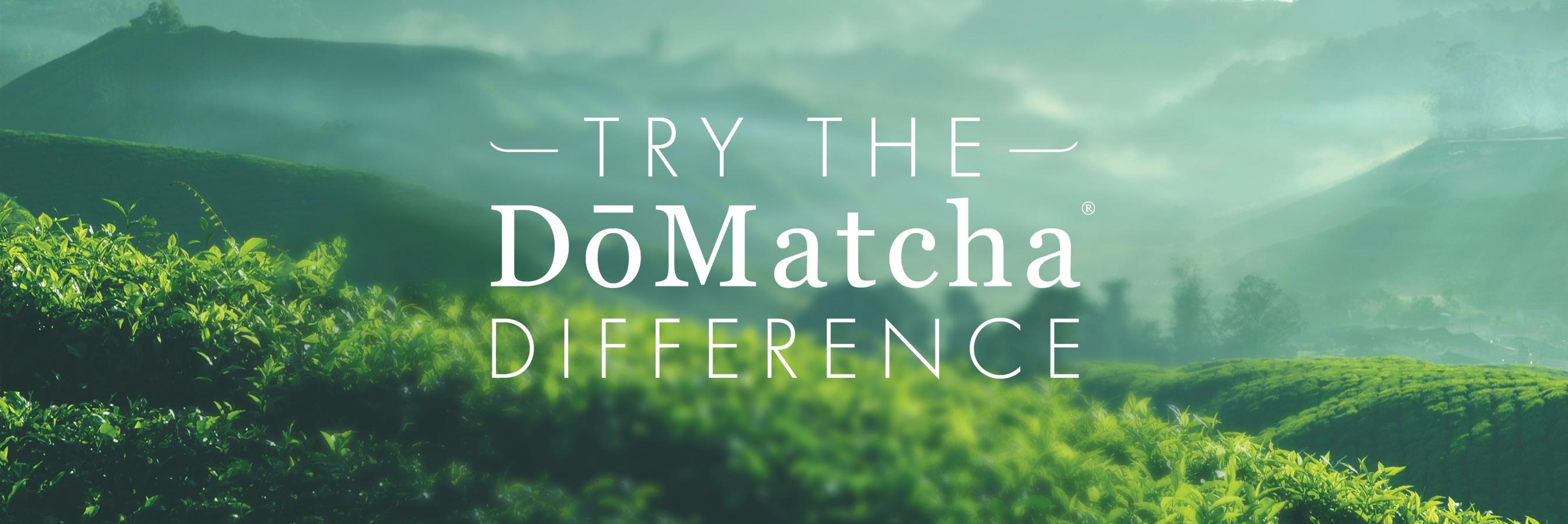 © JOHN HARRISON
© JOHN HARRISON
WHAT YOU NEED: FOOD HEROES & FEEL GOOD RECIPES ADVERTORIAL November • 2022
Empowering Families to Leave Poverty Behind – For Good

OPPORTUNITY INTERNATIONAL unleashes the power of entrepreneurs in some of the world’s poorest countries. Through innovative partnerships, our programs enable people to expand their businesses, feed their families, create jobs and change their communities. Every minute an Opportunity client accesses the financial tools, training and support to escape poverty and gain the opportunity to live a life with dignity and purpose.
WHY AGRICULTURE
Agriculture employs around 75 per cent of the African workforce, but the sector remains reliant on sub sistence and rain-fed agriculture. Only a fraction of suitable land is currently cultivated, and climate change poses a threat to future growth and development. One out of every two people on this planet struggles to feed and educate their children. When empowered by an opportunity, they have a chance to work their way out of poverty and transform their lives.
Opportunity International fo cuses on improving agriculture in Africa because it is home to a quarter of the world’s arable land,
CHALLENGE
No Financial Access
– Traditionally, farmers must borrow money from unregulated local lenders at high-interest rates to cover the costs of planting, harvesting and selling.
Low-Quality Resources –High-quality seeds and fertilizer are necessary to maximize crop yields but often are too expensive for farmers to afford.
Limited Agricultural Skills
– Farmers regularly lack technical assistance and training in modern agricultural techniques that improve the quality and yield of crops.
Side-Selling – Seasonal cash flows mean farmers usually have to forfeit up to half their annual income by selling crops at an extreme discount before the harvest.
No Access to Markets –Farmers often must sell their crops to consolidators at a low price because they lack access to viable markets.
yet it generates only 10 per cent of global agricultural output.
The fact remains that a typical smallholder farming household lacks the necessary resources to transform their subsistence farm into a thriving agribusiness.
Our Agriculture program helps people feed their families and grow enough to make a profit.
We do this through the following:
• Sustainable, climate-smart port folios in strong value chains
• Leveraging technology to reduce cost and risk
• Establishing a network of farmer support agents across Africa
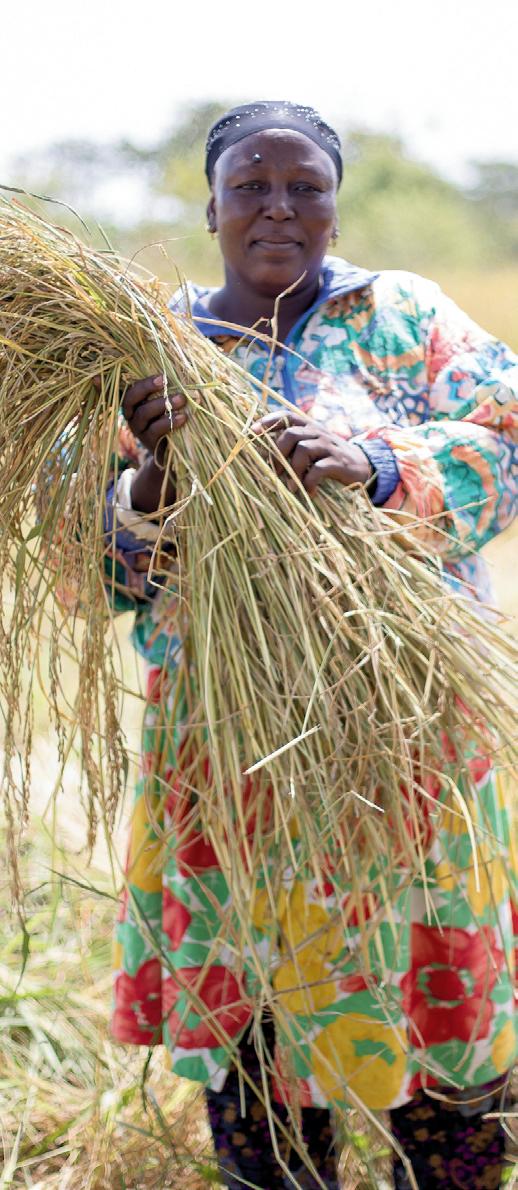
SOLUTION
Access to Agricultural Loans – Working with partners to use hightech, low-cost banking solutions to deliver loans to rural farming communities.
Access to Better Resources – Linking farmers to suppliers with high-quality seeds and fertilizers and negotiating competitive pricing for farmers.
Agricultural Training –Partnering with agricultural experts to deliver crop-specific training and assistance in good farming practices.
Access to Savings Accounts – Enabling farmers to open savings accounts during harvest season to save profits for financial protection between harvests.
Access to Better Crop Markets – Linking farmers to the best crop buyers where they can take advantage of better market prices.
NUCLEUS FARMERS
ظ Farmers are grouped into teams and each group elects their leadership. Prices are mutually agreed upon based on the cost of production for the season. Agreedupon prices remain fixed, typically for a year. In this model, aggregators provide all inputs to shareholders on a credit basis to be repaid after the harvest.
ظ While issues in working with smallholder farmers still sometimes arise, the nucleus model
discourages common problems like side-selling, diversion of inputs and under-declaration of produce. If one farmer is found engaging in misconduct or in breach of agreements, the entire group is held accountable.
ظ The nucleus farmer selects his farmers on the basis of credibility and integrity because they must come from the community and must be residents in the community.
Joshua, pictured above, is a nucleus farmer who serves 3,000 rice farmers, of whom 90 per cent are women. Opportunity International’s Implementing Partner in Ghana, Sinapi Aba Savings & Loans, Inc., provides Joshua with a loan to purchase farm equipment and obtain working capital. In turn, Joshua assists smallholder farmers by loaning them quality inputs, clearing the land, providing training in good agricultural practices and helping the farmers get their products to market.
Joshua is a visionary who saw a need and offered a solution
SUSTAINABLE DEVELOPMENT GOALS

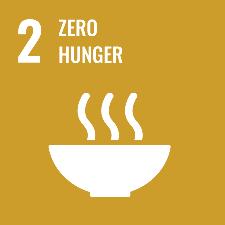
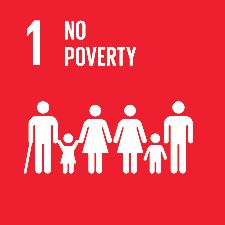


The 2030 Agenda for Sustainable Development, adopted by all United Nations Member States in 2015, provides a shared blueprint for peace and prosperity for people and the planet, now and into the future. The 17 Sustainable Development Goals (SDGs) recognize that ending poverty and other deprivations must go hand-in-hand with strategies that improve health and education, reduce inequality, and spur economic growth—all while tackling climate change and working to preserve our oceans and forests. Opportunity International’s Agriculture program supports the following SDGs:
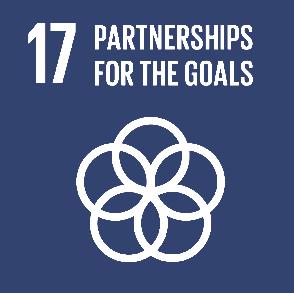
—and by doing so, has trans formed communities across northern Ghana. He has earned a reputation for community development by aggregating smallholder rice farmers and is sought out by communities who ask him to come and help them improve their communities.
When entering a community, he presents his methodology to the women in the community, creating opportunities for local women to earn employment and gain experience.
Joshua asks the women if they are interested in rice farming. If they are, the women vouch for
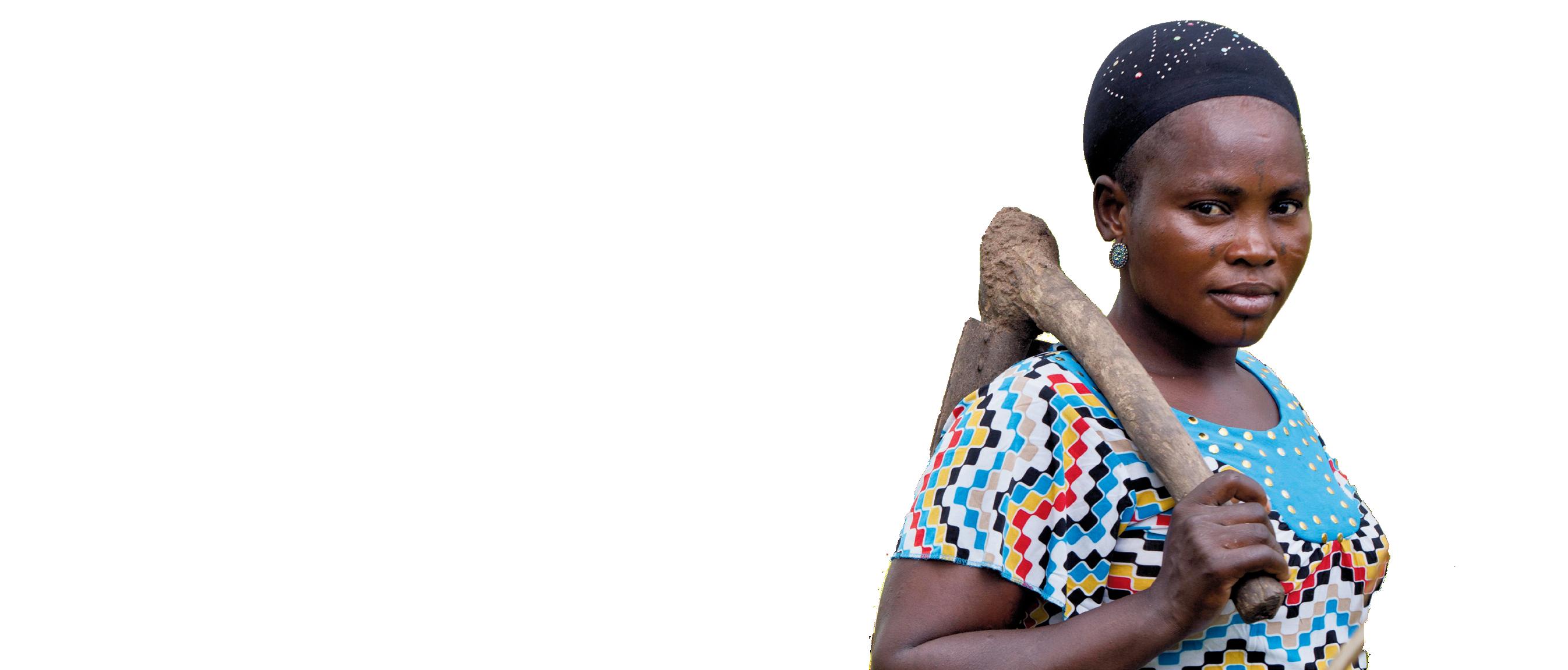
each other and form an “outfarmer” group. To date, Joshua has established 300 out-farmer groups. Joshua’s vision for the future is to involve women in the entire value chain. He wants to start a milling operation in Tamale and hire women to run the operation. The women farmers from the surrounding areas of Tamale would harvest the rice, which would then be taken to Tamale to be milled into flour by another group of women—thus providing employment for even more women and further driving gender equality.

OPPORTUNITY INTERNATIONAL CANADA
A STORY FROM THE FIELD
© MEEZY PHOTOGRAPHY JOSHUA © COURTESY OF OPPORTUNITY INTERNATIONAL The Multiplier Effect Yes, I want to help improve the lives of smallholder farms and their communities. Donate securely online at opportunityinternational.ca Loan to Joshua provides capital for the purchase of Farm Equipment and Working Capital Employment for 15 Extension Service Providers (ESP) and4 Supervisors Transformed lives of 3 , 000 out-farmers, their children and communities1 © KATE HOLT
globalheroes.com ADVERTORIAL November • 2022

 CORE is on the
CORE is on the

















































 ALLIE MURRAY
ALLIE MURRAY


















































 ALLIE MURRAY
ALLIE MURRAY






 © IMAGES COURTESY OF TOWN OF PRINCETON
DOWNTOWN
© IMAGES COURTESY OF TOWN OF PRINCETON
DOWNTOWN









 RAYE MOCIOIU
RAYE MOCIOIU


























 © JOHN HARRISON
© JOHN HARRISON




























































